H
|
|
| Hapalopilus nidulans (Cinnamon Bracket) |
   |
May 8, 2023. In Gerrards Cross on some unidentified fallen wood Jesper Launder noticed two small brown brackets - one either end. Both were the same species, one immature (photo 1) and one mature (photo 2). In some books as H. rutilans (it being unclear which name should prevail) this pored small bracket in uncommon but if in doubt over its identity a drop of KOH obligingly turns bright purple in all parts! Jesper nobly returned the next day armed with his KOH - photo 3! This is the first county find for quite a few years. |
    |
Jul 12, 2021. A few weeks back Claire Williams sent Penny photo 1 of an immature bracket found on rotting deciduous wood in Downley Woods. Unable to name it, Penny suggested Claire return to the site when it had developed further and the result was photos 2 and 3 taken today which made determination much easier. This is a bracket for which we have about 10 county records but none since 2010 thus conspicuous by its absence in recent years. The species has several redeeming features: it is soft and quite pliable and is the same buffy colour both above and below, having quite distinct pores underneath. The most useful and conclusive feature, however, is that a drop of the chemical KOH turns instantly purple! So to make the determination secure Claire took a sample over to Penny, the result being photo 4. |
Hebeloma birrus (Yellowish Poisonpie)  |
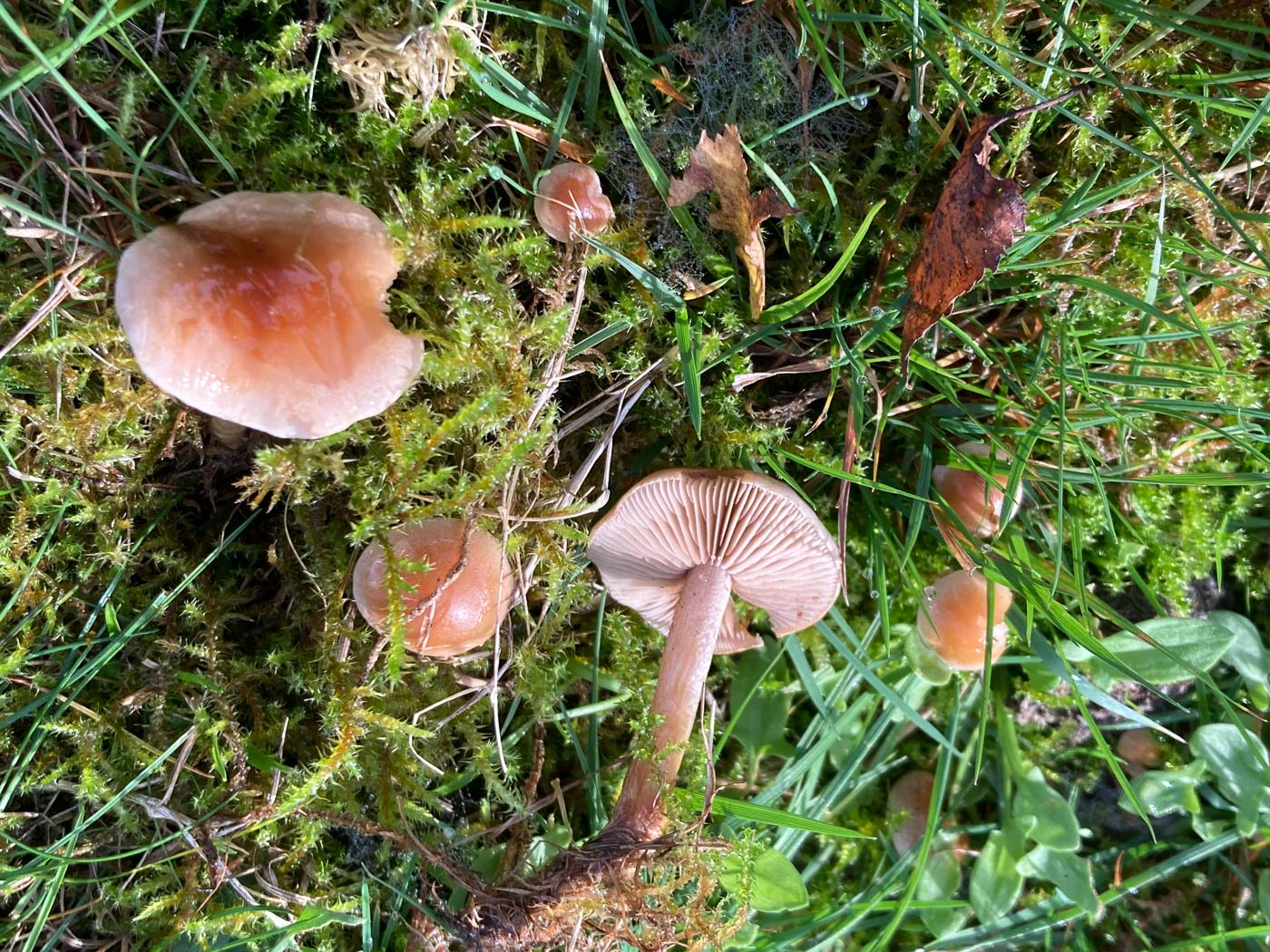 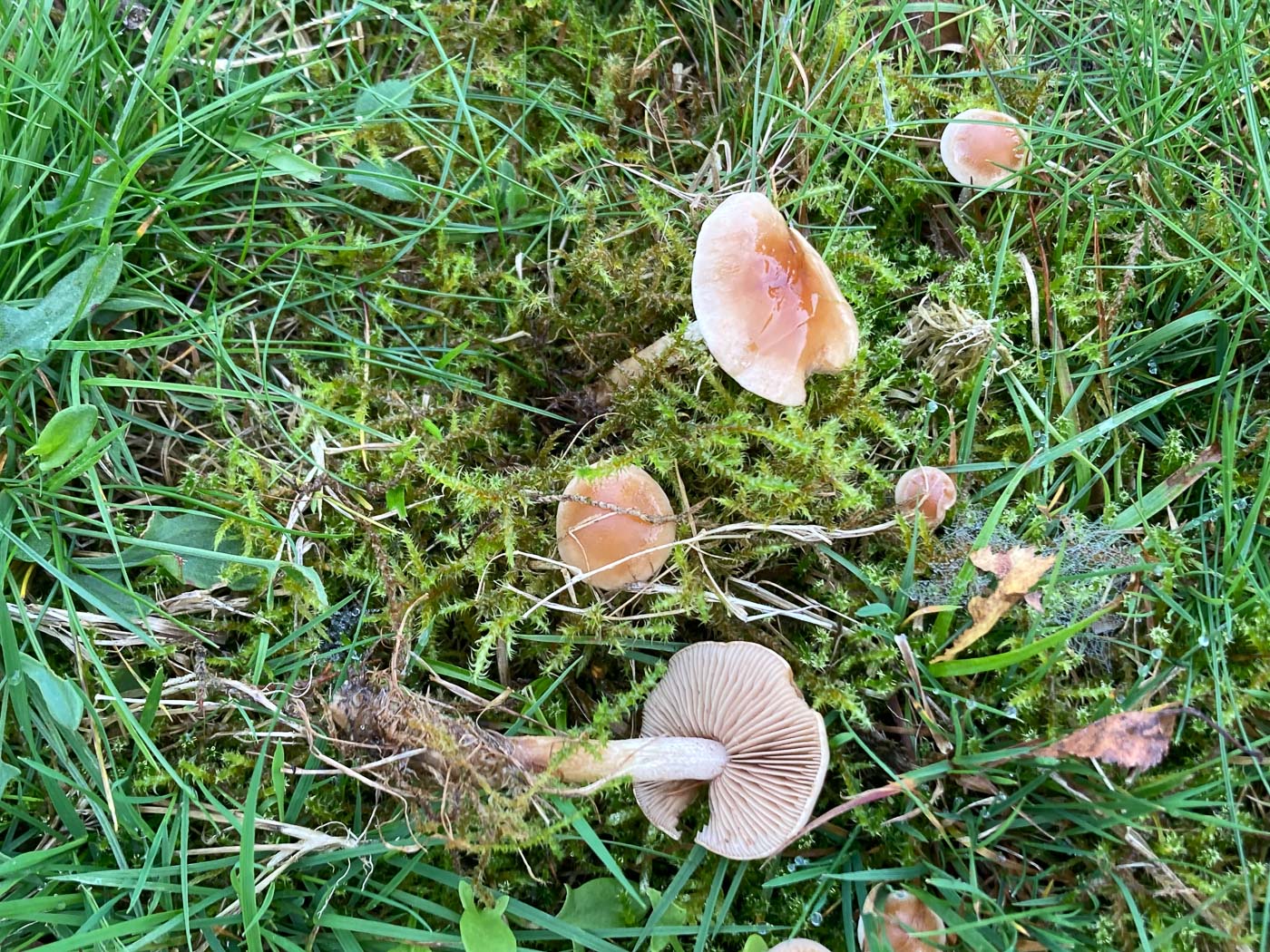 |
Oct 17, 2024. At Burnham Beeches in grassy soil under deciduous trees Russell Ness found a group of this Poisonpie which is quite common locally and usually has a clearly twotone cap which dark centre and pale rim. However all members of this tricky genus need identification using a scope. They have moist to sticky caps and most have a sharp radish smell though a few have a sweet burnt sugar smell and today's species has a faint component of cocoa especially in contained in a covered pot after collection. |
   |
Nov 9, 2021. In soil under Birch in a grassy glade at Burnham Beeches Penny found the three small fruitbodies with distinctly two-tone caps and recognised them as probably one of several Poisonpies with this characteristic. At home the spores were ornamented, strongly dextrinoid and had a 'loosening perispore' (the outer surface tending to have bits detaching from it), and this together with the cylindrical gill edge cells and faint smell - not radishy as in many of this genus - led to the determination. Two days later at nearby Stoke Common she found further collections though some lacked the two-tone caps and on collection were thought to be something different. All were under Oak and had the same microscopic features, photo 2 having the two-tone caps but Photo 3 is of a collection on burnt ground, fitting fine checking the literature which described the species as sometimes with a two-tone cap but sometimes not! |
| Hebeloma cf. crustuliniforme (Poisonpie) |
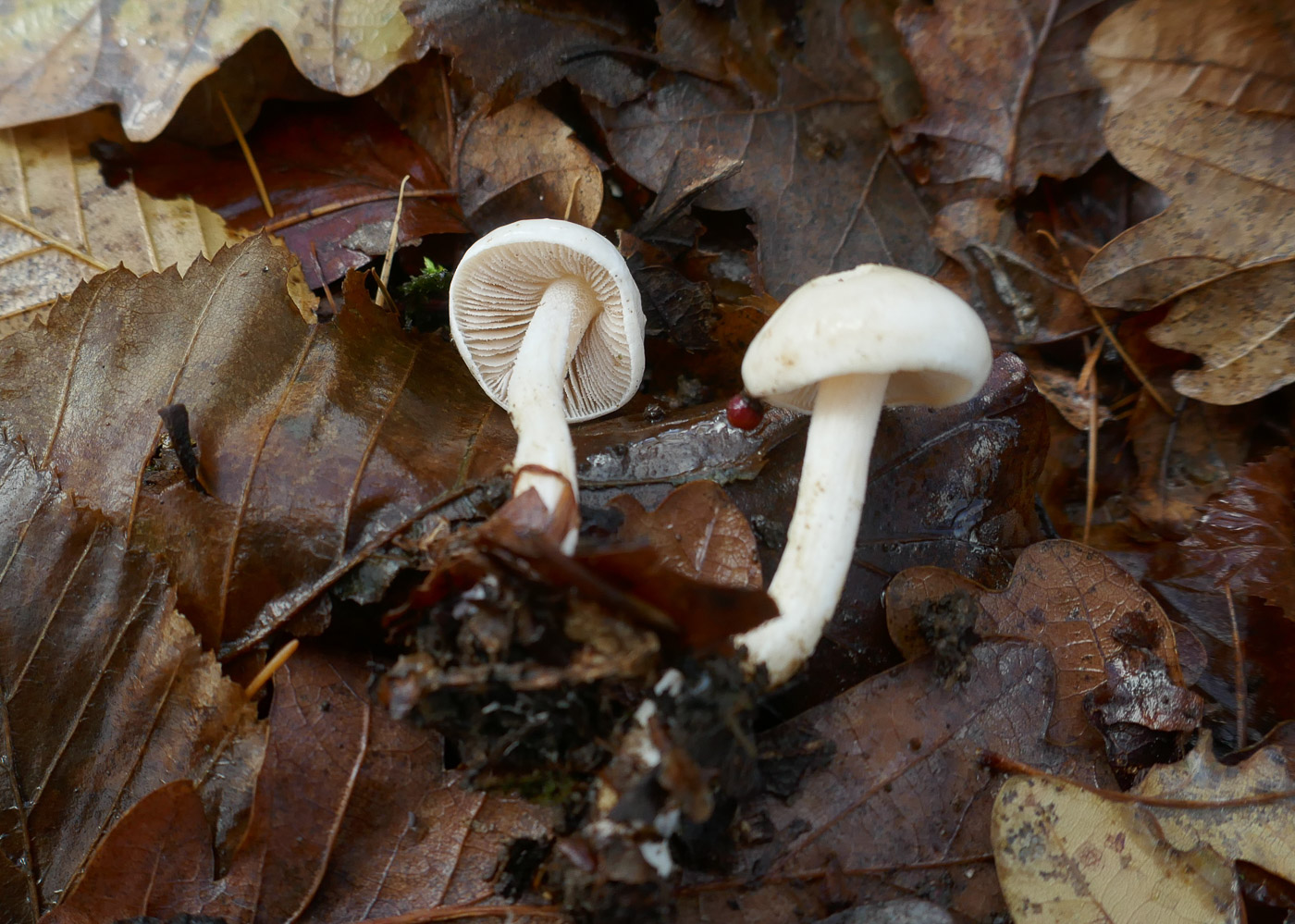
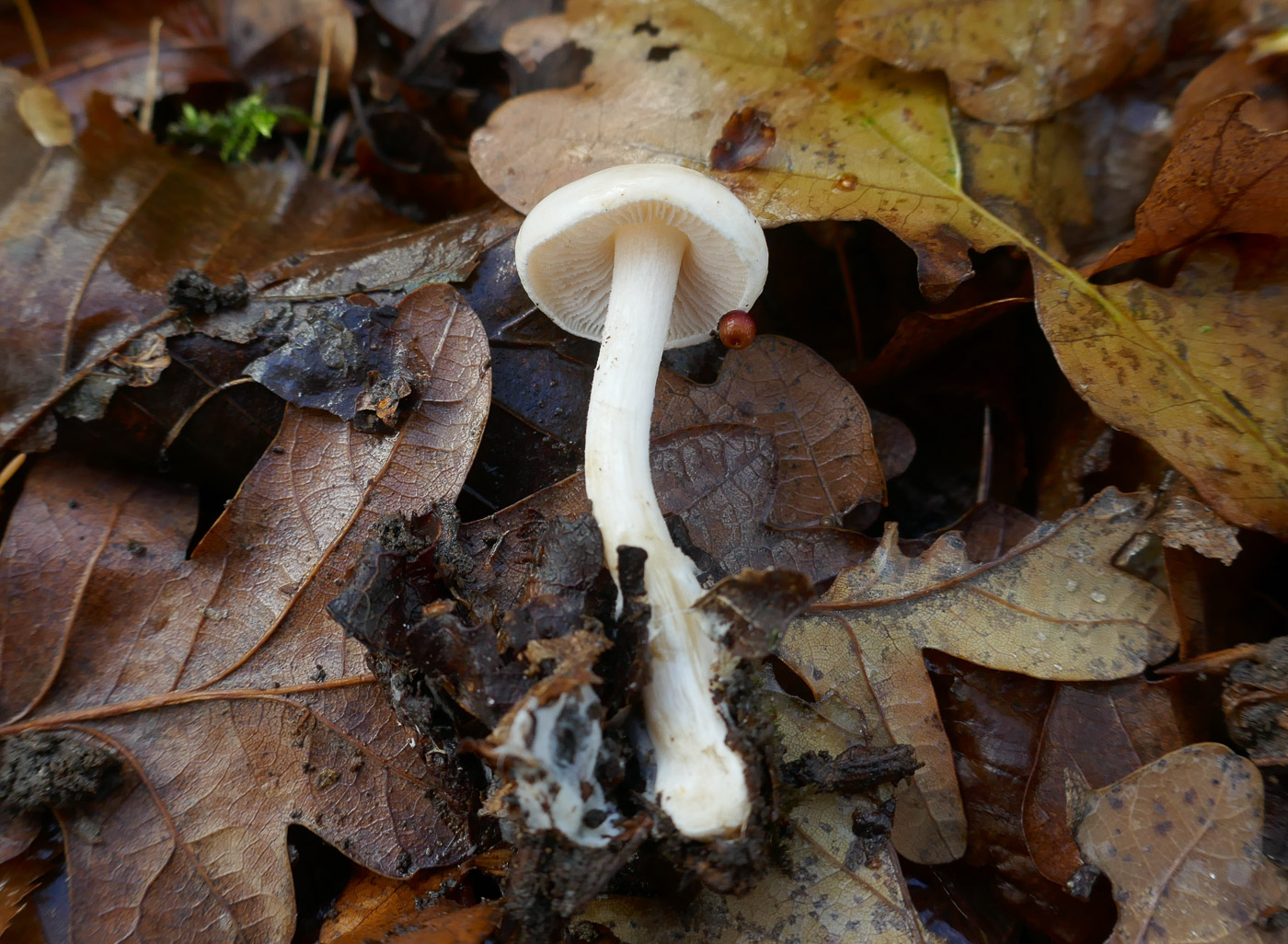
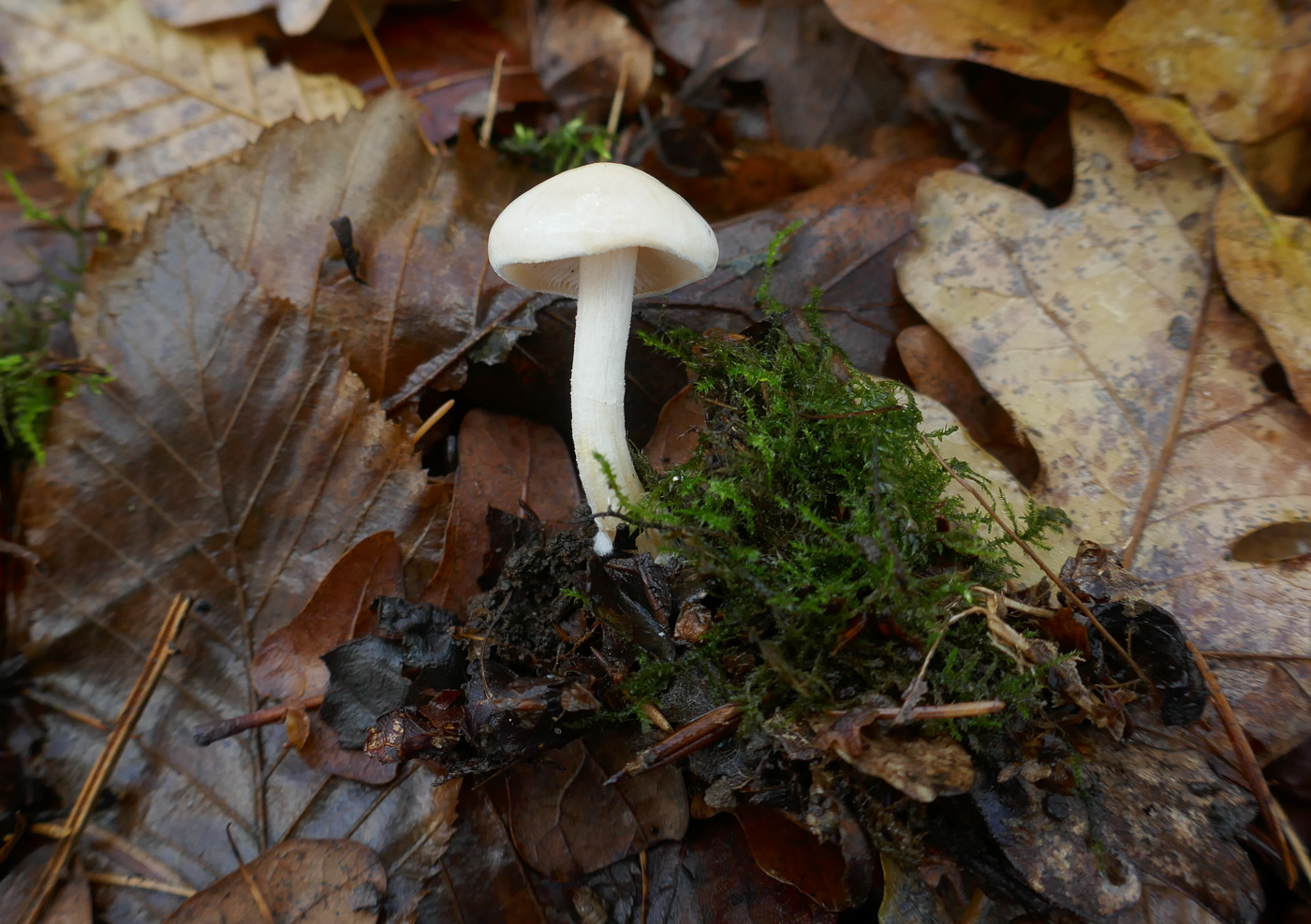
|
Dec 3, 2025.  At Stampwell Farm Jackie Ewan scratched her head over this puzzling white pair of mushrooms when found in woody litter under Oak and Birch. At home she was expecting it to be an Inocybe (Fibrecap) which has several white species, but the plentiful gill edge cystidia were neither metuloid nor were they or the spores shaped cprrectly for other related but possible Fibrecap genera; furthermore the spore print proved too pale. Penny passed the photos on to Jesper Launder who suggested the genus Hebeloma despite its unusually white appearance in lieu of the cystidia, the spore print colour and the almond-shaped slightly ornamented spores. (Very occasionally white forms of normally buff coloured members of this genus can be thrown up, as occurred with the exceptionally rare H. laetitiae Penny found at Stoke Common back in 2010 which turned out to be the 3rd European collection.) Jackie then agreed that this genus was a good possibility, recalling that the cap was indeed a bit sticky on collection - often a useful pointer to Hebeloma when in doubt over the genus, then recalled finding H. crustuliniforme quite regularly on site. The micro-characters fitted fine though the fruitbodies' small size and white colour not surprisingly had sent her in a different direction! Hopefully sequencing will confirm this unusual collection of a quite common species, described as cream-buff with yellow-brown centre. At Stampwell Farm Jackie Ewan scratched her head over this puzzling white pair of mushrooms when found in woody litter under Oak and Birch. At home she was expecting it to be an Inocybe (Fibrecap) which has several white species, but the plentiful gill edge cystidia were neither metuloid nor were they or the spores shaped cprrectly for other related but possible Fibrecap genera; furthermore the spore print proved too pale. Penny passed the photos on to Jesper Launder who suggested the genus Hebeloma despite its unusually white appearance in lieu of the cystidia, the spore print colour and the almond-shaped slightly ornamented spores. (Very occasionally white forms of normally buff coloured members of this genus can be thrown up, as occurred with the exceptionally rare H. laetitiae Penny found at Stoke Common back in 2010 which turned out to be the 3rd European collection.) Jackie then agreed that this genus was a good possibility, recalling that the cap was indeed a bit sticky on collection - often a useful pointer to Hebeloma when in doubt over the genus, then recalled finding H. crustuliniforme quite regularly on site. The micro-characters fitted fine though the fruitbodies' small size and white colour not surprisingly had sent her in a different direction! Hopefully sequencing will confirm this unusual collection of a quite common species, described as cream-buff with yellow-brown centre. |
| Hebeloma mesophaeum (Veiled Poisonpie) |
  |
Mar 18, 2024.  Under Birch and Eucalyptus in Gerrards Cross, Jesper Launder was amazed to come across this genus in March - one we expect to find in the autumn. Microscopy confirmed it, however, and also enabled him to determine the species - not that rare (in the autumn) and sometimes with a two-tone cap with distinctly darker centre (as will be seen in our other previous Finds entry which was also made under Birch). However, bearing in mind the extraordinarily unseasonal date and possible association with Eucalyptus, today's collection will be sequenced. Under Birch and Eucalyptus in Gerrards Cross, Jesper Launder was amazed to come across this genus in March - one we expect to find in the autumn. Microscopy confirmed it, however, and also enabled him to determine the species - not that rare (in the autumn) and sometimes with a two-tone cap with distinctly darker centre (as will be seen in our other previous Finds entry which was also made under Birch). However, bearing in mind the extraordinarily unseasonal date and possible association with Eucalyptus, today's collection will be sequenced. |
 |
Oct 16, 2020.  Penny C. found this striking collection under Birch in Burnham Beeches. This is one of the commoner species of Poisonpie and when it has this very distinctive two-tone coloured cap it is easy to recognise, though it is often not as clear as in today's collection. With this genus one should always check for the radish smell which most species have and also use a scope to determine the species. It is considered one of the harder genera to identify and very few can safely be named in the field. Penny C. found this striking collection under Birch in Burnham Beeches. This is one of the commoner species of Poisonpie and when it has this very distinctive two-tone coloured cap it is easy to recognise, though it is often not as clear as in today's collection. With this genus one should always check for the radish smell which most species have and also use a scope to determine the species. It is considered one of the harder genera to identify and very few can safely be named in the field. |
| Hebeloma radicosum (Rooting Poisonpie) |
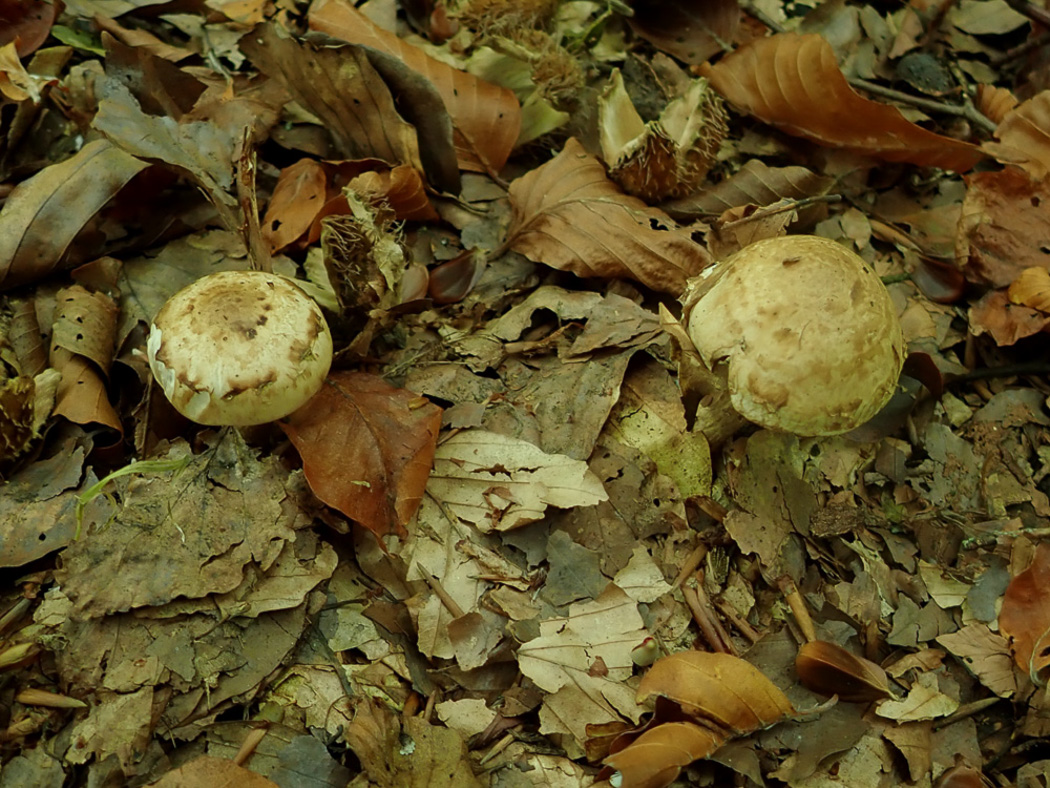 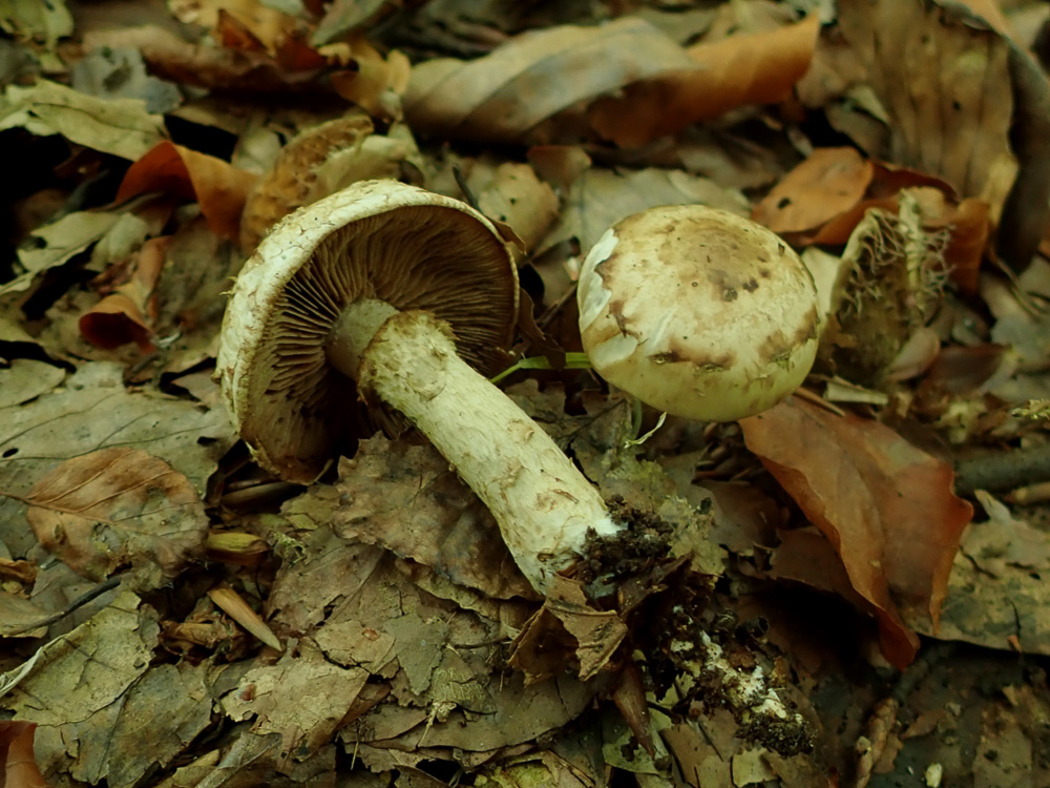 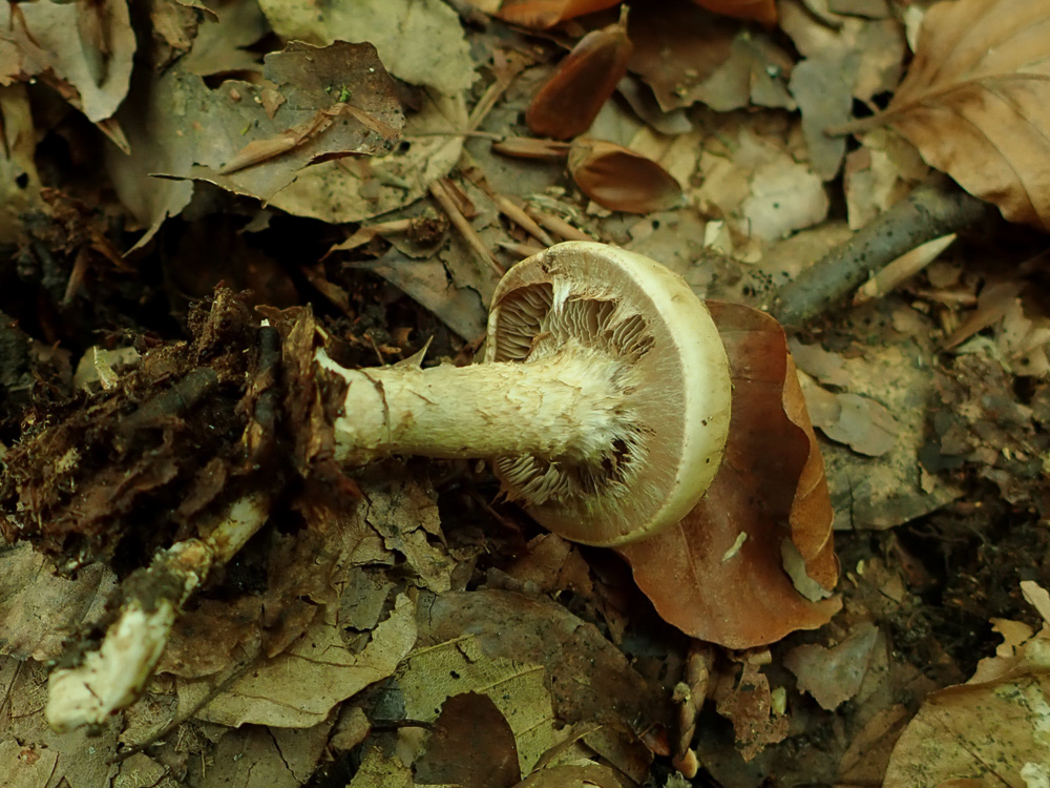
|
Oct 7, 2025.  In Gussetts Wood under Beech Penny saw two caps which seemed unfamiliar to her so they were quickly collected to look at in detail later - there were plenty of other mushrooms begging for attention at the time so she failed to look closely enough to notice the white root extending below the stem (see photo 2) or the distinctive smell of marzipan! Short of time, the collection was overlooked till shown the next day to Geoffrey Kibby who recognised it instantly! So this particular Hebeloma is alone in having three field characters which in combination are diagnostic (if you know to look for them!): not just the rooting base and marzipan smell but also the thick veil which leaves a ring on the stem (see photo 3). We have quite a few county records but this is considered an occasional species. In Gussetts Wood under Beech Penny saw two caps which seemed unfamiliar to her so they were quickly collected to look at in detail later - there were plenty of other mushrooms begging for attention at the time so she failed to look closely enough to notice the white root extending below the stem (see photo 2) or the distinctive smell of marzipan! Short of time, the collection was overlooked till shown the next day to Geoffrey Kibby who recognised it instantly! So this particular Hebeloma is alone in having three field characters which in combination are diagnostic (if you know to look for them!): not just the rooting base and marzipan smell but also the thick veil which leaves a ring on the stem (see photo 3). We have quite a few county records but this is considered an occasional species. |
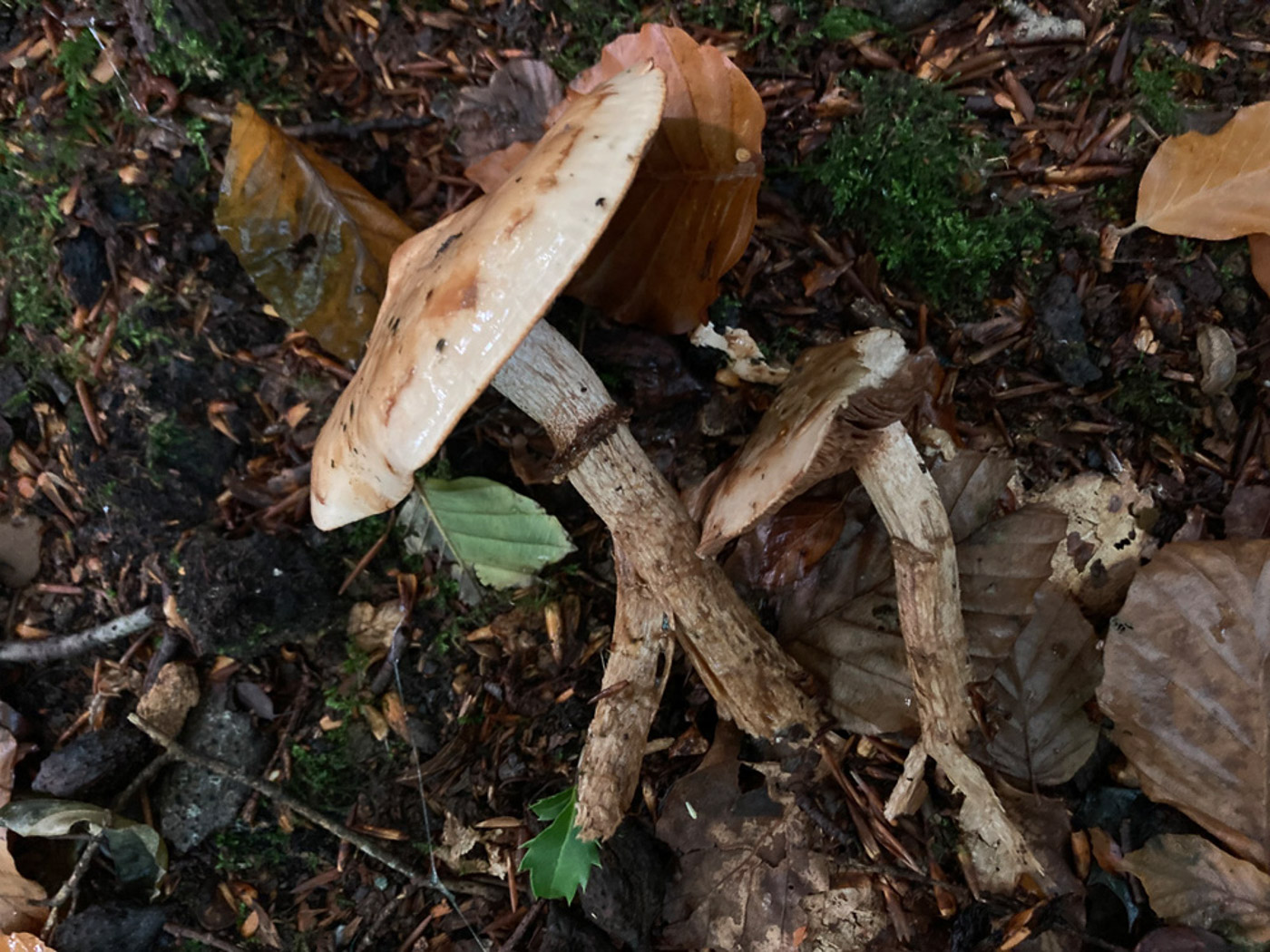 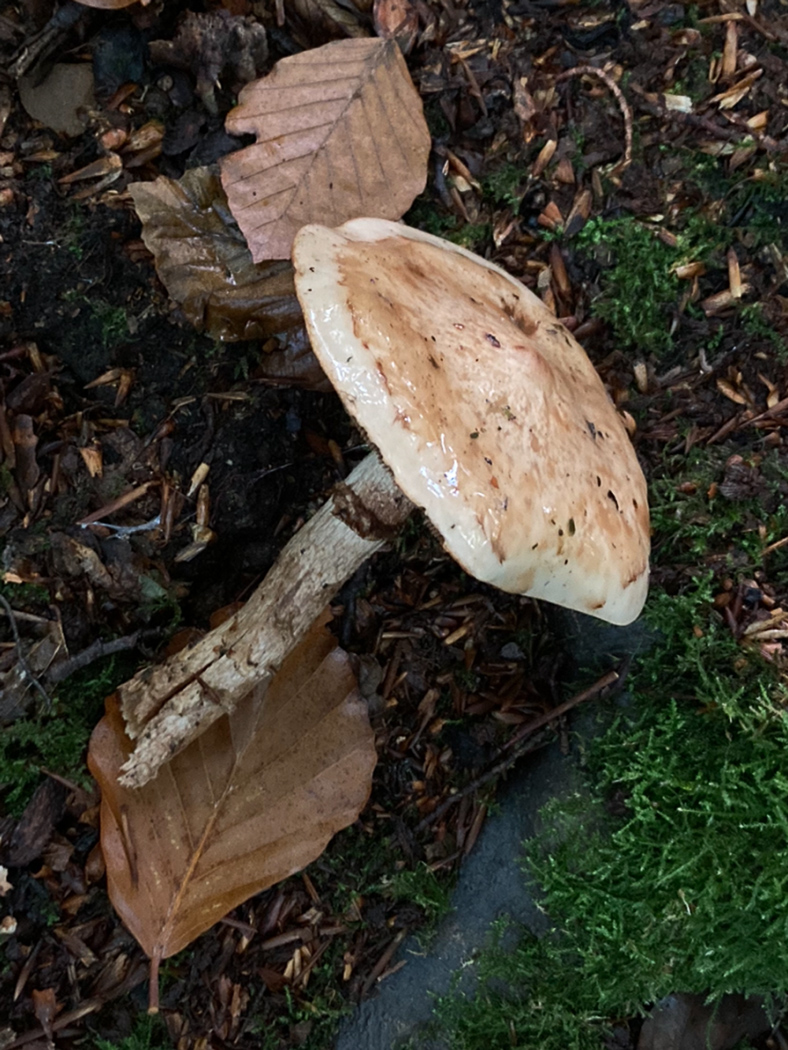 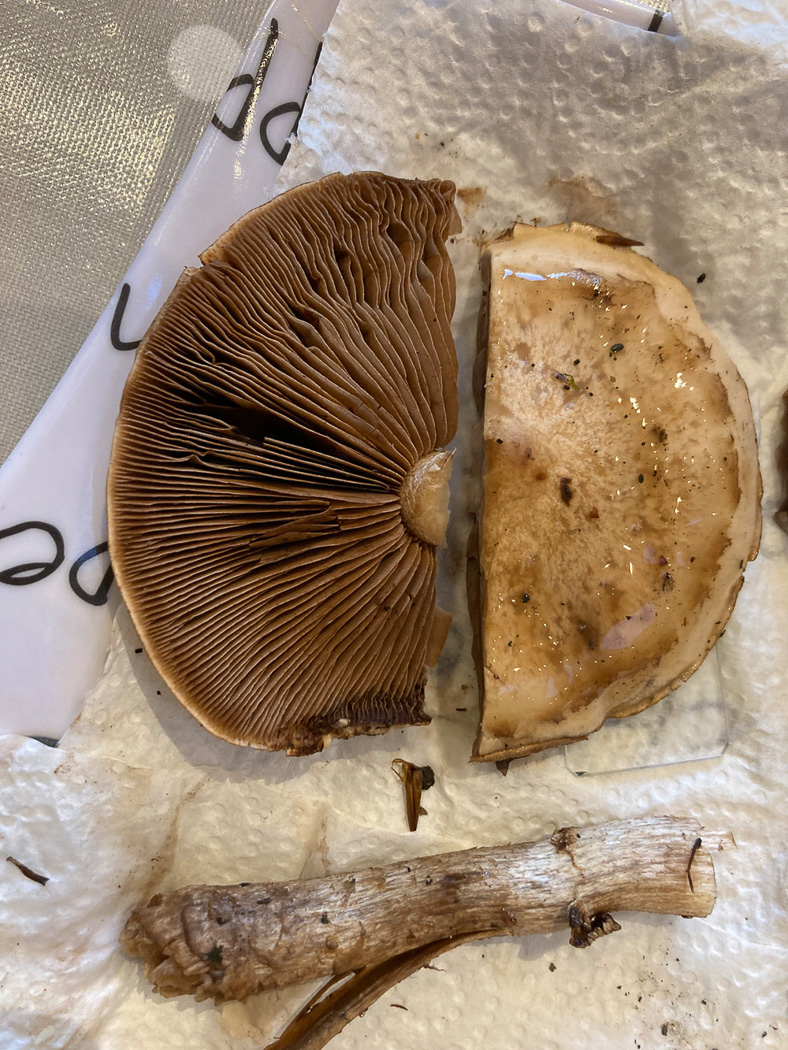 |
Oct 18, 2024.  In Burnham Beeches Russell Ness found this quite large singleton, with cap about 7 cm across, which stumped him for identification at the time. He initially thought it might be a species of Pholiota, having a sticky cap, a ringed stem and found at the base of a Beech trunk, and it was not until spore colour and microscopic features together with the developing strong smell of marzipan were noted at home that he twigged what it was! This uncommon Hebeloma is unique amongst members of the genus in three ways: it has a ring on the stem, it roots deeply into its substrate and it has a distinctive marzipan smell. The least obvious of these features is probably the rooting stem which in older specimens is likely to snap off on collection and therefore be missed, especially if you don't know to check for it at the time - this is exactly what happened here! (Surely Marzipan Poisonpie would be a more apt name?) It is known that the root links to the latrines of voles and mice presumably supplying an extra source of nutrients. We have a handful of previous county records but this is a new entry for Finds. In Burnham Beeches Russell Ness found this quite large singleton, with cap about 7 cm across, which stumped him for identification at the time. He initially thought it might be a species of Pholiota, having a sticky cap, a ringed stem and found at the base of a Beech trunk, and it was not until spore colour and microscopic features together with the developing strong smell of marzipan were noted at home that he twigged what it was! This uncommon Hebeloma is unique amongst members of the genus in three ways: it has a ring on the stem, it roots deeply into its substrate and it has a distinctive marzipan smell. The least obvious of these features is probably the rooting stem which in older specimens is likely to snap off on collection and therefore be missed, especially if you don't know to check for it at the time - this is exactly what happened here! (Surely Marzipan Poisonpie would be a more apt name?) It is known that the root links to the latrines of voles and mice presumably supplying an extra source of nutrients. We have a handful of previous county records but this is a new entry for Finds.
|
| Hebeloma sacchariolens (Sweet Poisonpie) |
 |
Sep 29, 2022.  At Stampwell Farm in a woodland path under Oak and Birch Jackie Ewan found this group of mushrooms and recognised the genus from their sticky caps and general appearance, then tested for the typical radish smell present in many members of the genus. A few species, however, have a remarkable and distinctive smell of burnt sugar which was present here. She checked the microscopic characters later to confirm her ID made using her nose! The species is not rare though this is a first for Members' Finds. At Stampwell Farm in a woodland path under Oak and Birch Jackie Ewan found this group of mushrooms and recognised the genus from their sticky caps and general appearance, then tested for the typical radish smell present in many members of the genus. A few species, however, have a remarkable and distinctive smell of burnt sugar which was present here. She checked the microscopic characters later to confirm her ID made using her nose! The species is not rare though this is a first for Members' Finds.
|
| Hebeloma sinapisans (Bitter Poisonpie) |
  |
Sep 24, 2020.  Our first photo of a member of this large and tricky genus, this was found under Beech at Mousells Wood by Penny Cullington. It is typical of its genus, very few of which can or should be named in the field and all of which are mycorrhizal with trees. They have sticky, smooth, pale to darker brown caps and white stems, often with a distinct smell of radish (though a few have a sweet smell). The species here is a large one with caps up to 10 cm across or more, it also has a bulbous stem base (seen in the LH specimen) and when sliced open there is a hanging flange (wick) at the top of the stem. Our first photo of a member of this large and tricky genus, this was found under Beech at Mousells Wood by Penny Cullington. It is typical of its genus, very few of which can or should be named in the field and all of which are mycorrhizal with trees. They have sticky, smooth, pale to darker brown caps and white stems, often with a distinct smell of radish (though a few have a sweet smell). The species here is a large one with caps up to 10 cm across or more, it also has a bulbous stem base (seen in the LH specimen) and when sliced open there is a hanging flange (wick) at the top of the stem.
|
| Helvella acetabulum (Vinegar Cup) |
 |
Mar 21, 2024. Jesper Launder has now found several of these springtime cups coming up in Gerrards Cross though his photo here was the earliest. As both this species and the fairly similar Disciotis venosa are likely to be around at this time, care is needed by the less experienced to separate them. The English (and Latin species) name here refers not to its smell but to its shape - similar to that of the ancient Roman or Greek cup used for vinegar. Unlike D. venosa which smells strongly of chlorine / bleach and has wrinkles / veins on the inner surface, H. acetabulum has no smell and has wrinkles / veins running up the stem and onto the outer surface. Both are relatively common in spring in grassy woodland glades / soil. |
  |
Apr 8, 2023. In Jordans Village Jesper Launder was pleased to spot this unusual springtime fruiter - one he's not seen in the village before despite his regular forays around the area. (The Latin species name indicates a vessel used to store vinegar in the distant past.) The species could possibly be confused with the similar Disciotis venosa (Bleach Cup) which also fruits now and is another large brown cup growing in soil in grassy areas, also under trees. The main distinguishing features: the Helvella has a smooth inner surface and a prominent cream stem having marked sometimes forking ribs, whereas the Disciotis develops a wrinkled inner surface and has hardly any stem; furthermore the Helvella lacks a distinct smell but the Disciotis has a strong smell of bleach when damaged. Photo 2 was taken by Philip Townsend 3 weeks later at Ragpits BBOWT Reserve. |
 |
May 12, 2021. At Ragpits Reserve Phil Townsend found this springtime ascomycete at the edge of the meadow under Hazel. This is considered an occasional species and is quite a large cup, up to 5cms across or so, possibly looking more like a Peziza than a Helvella but differing considerably from Peziza under a scope. The distinct whitish stem is a salient feature to look for, as are the ribs / veins which form on the outside of the cup. |
| Helvella cf ephippium/sublicia (a species of Saddle) |
  |
Nov 10, 2022.  In Round Spring Wood, Dancersend, in the Beech litter we found this small Saddle, clearly different from the two much more common Saddles which both have a strikingly ridged stem. The specimens stood less than 3 cms tall (this can be gauged by the Beech leaf on which they were placed for photo 1 - taken by Neil Fletcher), the stems were smooth and the underside was finely downy / hairy. After sequencing showed it to have no close matches and only a 95% match to the rare Helvella ephippium (hence the 'cf' in the title, sublicia being the latest name for the species) the specimen was sent first to Kerry Robinson, then to Paul Cannon for expert help, and is now in the Kew Fungarium. More material is needed to take this further but it could possibly be an undescribed cryptic species. Photo 2 is Sarah Ebdon's. In Round Spring Wood, Dancersend, in the Beech litter we found this small Saddle, clearly different from the two much more common Saddles which both have a strikingly ridged stem. The specimens stood less than 3 cms tall (this can be gauged by the Beech leaf on which they were placed for photo 1 - taken by Neil Fletcher), the stems were smooth and the underside was finely downy / hairy. After sequencing showed it to have no close matches and only a 95% match to the rare Helvella ephippium (hence the 'cf' in the title, sublicia being the latest name for the species) the specimen was sent first to Kerry Robinson, then to Paul Cannon for expert help, and is now in the Kew Fungarium. More material is needed to take this further but it could possibly be an undescribed cryptic species. Photo 2 is Sarah Ebdon's.
|
| Helvella cf. fibrosa (a very rare species of Saddle with no English name) |
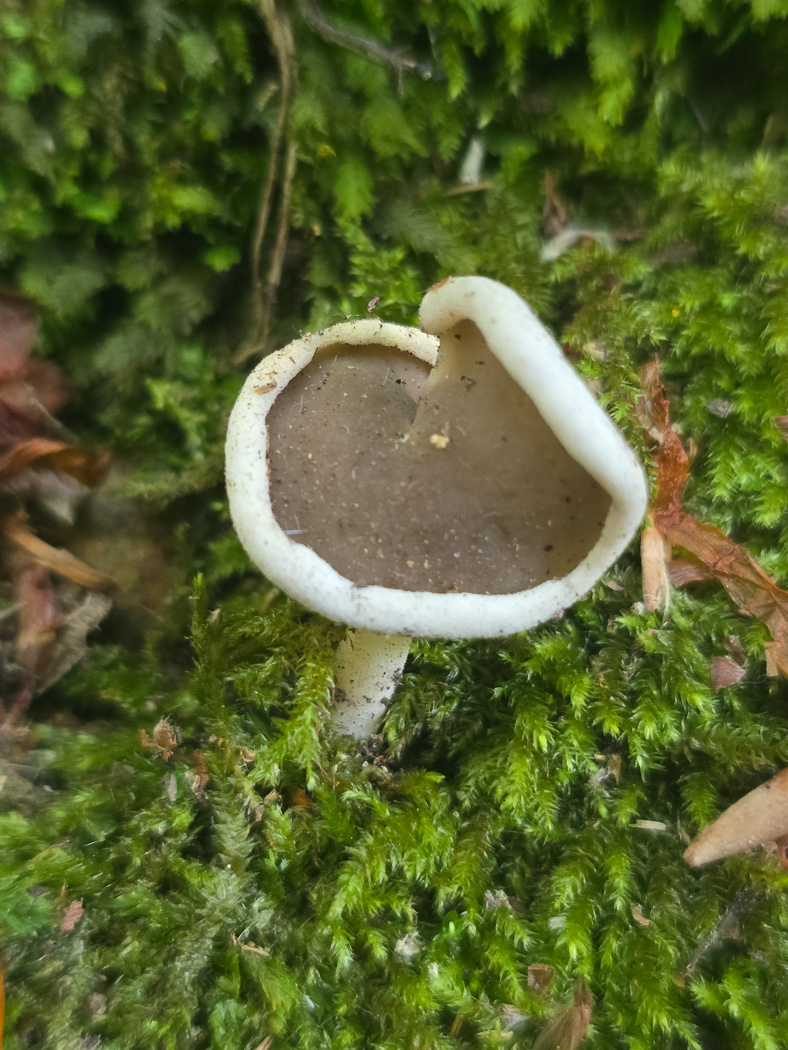
|
Jun 14, 2025.  On a mossy roadside bank in Chalfont St. Peter Jesper Launder spotted this tiny Helvella which though similar to H. macropus didn't ring any bells with him. (He apologises for the photo which had to be taken rapidly because of the uncomfortably close traffic!) At home the spore shape - ellipsoid and not fusiform - eliminated H. macropus, and following an online key then led him close to H. fibrosa though there seems discrepancy as to whether this species has smooth or finely ornamented spores - he found smooth spores - though other features appear to fit well. FRDBI has just two records and we have no mention of this species in our Bucks database, so this is clearly one for sequencing .............. On a mossy roadside bank in Chalfont St. Peter Jesper Launder spotted this tiny Helvella which though similar to H. macropus didn't ring any bells with him. (He apologises for the photo which had to be taken rapidly because of the uncomfortably close traffic!) At home the spore shape - ellipsoid and not fusiform - eliminated H. macropus, and following an online key then led him close to H. fibrosa though there seems discrepancy as to whether this species has smooth or finely ornamented spores - he found smooth spores - though other features appear to fit well. FRDBI has just two records and we have no mention of this species in our Bucks database, so this is clearly one for sequencing ..............
|
| Helvella crispa (White Saddle) |
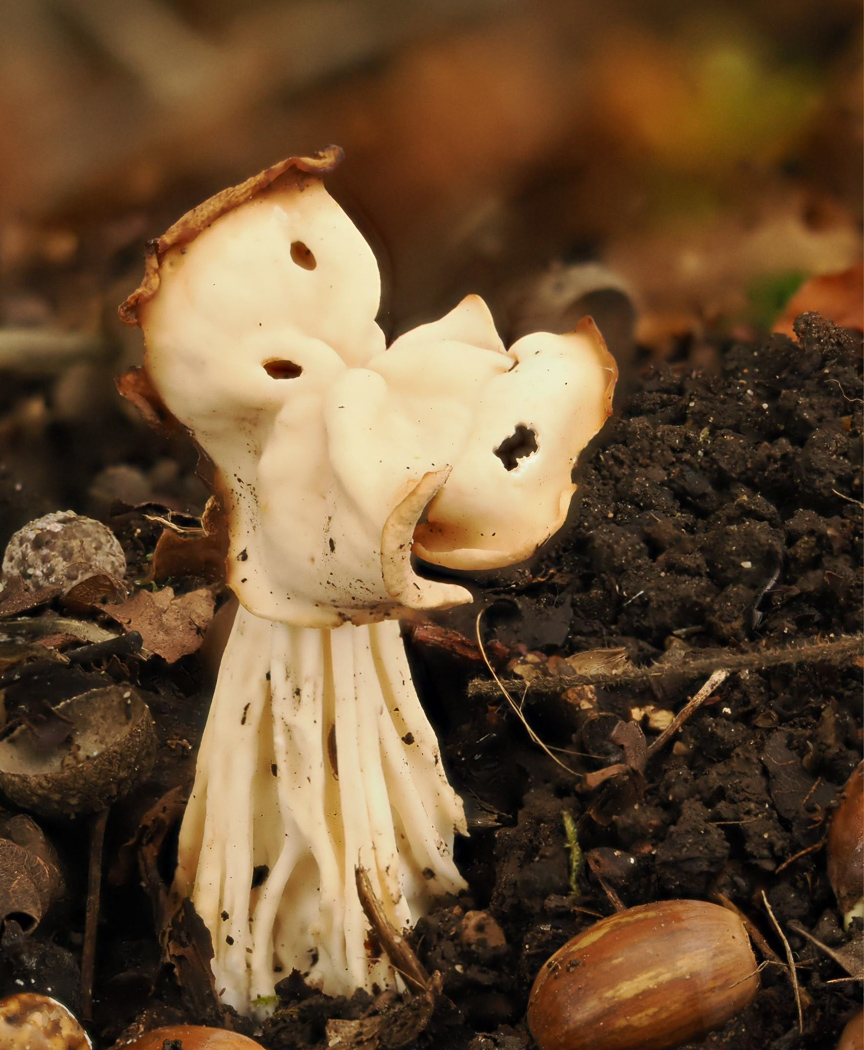
|
Oct 30, 2025. On Downley Common Claire Williams reports good numbers of this attractive asco now fruiting (and Penny also noticed it at Whiteleaf Cross in grassy path edges the following day). |
   |
Oct 17, 2023. In Summerheath Wood Jim Wills found this distinctive Ascomycete - one which is normally quite common but seems to have been few and far between so far this season. Easily recognised, the deeply ridged white stem with it irregularly shaped cream to white 'saddle' on top is typical, it can get to about 10 cms tall, often in grass path edges. Photos 2 and 3 were taken a couple of weeks late in Naphill Common by Sarah Ebdon. See the Masterlist for further images. |
 |
Oct 24, 2022. In Lott Wood Claire Williams found this normally quite common Ascomycete though so far this autumn it seems to have been very scarce. For an Asco it is a good size, standing often about 12 cms tall or even more, the ribbed stem being distinctive. |
 |
Nov 16, 2021. In Piggots Wood Claire Williams found quite a few examples of this attractive and distinctive Ascomycete - one we've not yet included here. The stem is decidedly ribbed in contrast to the smooth but irregularly lobed 'saddle', the colour being white to cream, becoming more ochre with age. This is a common species often in grassy glades in woodland / path edges, and always nice to see. |
  |
Oct 5, 2020. Penny Cullington found several fruit bodies of this beautiful but common Ascomycete growing in a grassy path edge in Common Wood. On the same day John Catterson found his collection in Naphill Common (photo 2). It's an easy one to recognise and can't really be mistaken for anything else, having a thick white distinctly ribbed stem topped with a saddle-shaped and irregularly lobed white head, the underside of which is creamy buff. Today's collection stood about 8 cm tall. |
| Helvella elastica (Elastic Saddle) |
 |
Aug 9, 2023. In a grassy path edge in Gerrards Cross Common Jesper Launder found this attractive ascomycete - not rare but not that common either. Its distinctive appearance makes it identifiable in the field though the top section starts out curled downwards, only flaring out as here later. We have one previous Finds Entry: 2022 November 23rd. |
 |
Nov 23, 2022. In grassy litter under Lime Penny found this nice little cluster of Saddles. This ascomycete species has a smooth stem in contrast to the markedly ridged stems of both H. crispa (White Saddle) and H. lacunosa (Elfin Saddle), both of which are taller and generally much more common. Though not rare - we've seen it several times this autumn - it is a new entry for Finds. |
| Helvella lacunosa (Elfin Saddle) |
 |
Aug 19, 2023. In Rushbeds Wood under Oak on a pile of rotting vegetation Penny spotted this singleton lurking amongst the collection of Scleroderma areolatum and but for the presence of that species would probably have missed it! (See photo 2 of the entry above.) This species can hardly be mistaken for anything else with its markedly ridged stem and dark 'saddle'. It occurs in mixed woodland litter quite commonly though is generally well camouflaged and easy to miss. See the Masterlist for further images. |
  |
Nov 10, 2022. In Round Spring Wood, Dancersend, in the Beech litter we found several examples of this fairly common species which were typically dark grey with the strongly ridged stem (as in photo 1 taken by Neil Fletcher), but then came across a pale brown specimen with a white ridged stem (photo 2 by Barry Webb) which it was hard to accept was the same species and will therefore be sequenced on the offchance that it might be something much less common. See the Masterlist for various other images of the species, none of which display the features of our photo 2. |
 |
Oct 24, 2022. In Lott Wood Claire Williams found this Ascomycete in Beech litter. It is usually a bit squatter - also less frequent - than White Saddle (see just below) and its dark colours often make it hard to spot. |
 |
Nov 16, 2021. In Beech litter at Ashridge Estate Richard Wright found this nice example of an Ascomycete species. Similar to H. crispa, also found today by Claire Williams, it is not only much darker, brownish to black, but tends to be more convoluted. Both species are quite common but this one is more frequently in woodland litter rather than grassy path edges. |
 |
Oct 31, 2021. In Widdendon Wood John Catterson found good numbers of this species of deciduous woodland, usually quite common though we've not had sightings of it reported from elsewhere this season. Similar in size and stature to the possibly more familiar H. crispa (White Saddle) it is obviously darker - usually greyish to black rather than brown as here, has an irregular 'saddle' and a very furrowed stem. |
   |
Oct 19, 2020. Claudi Soler found this singleton in Beech litter in Burnham Beeches (photo Penny C.) There is obvious similarity between this species and the much more common White Saddle (dated Oct 5th) though the dark grey colour makes it less easy to spot amongst the litter and it is generally slimmer with a smaller head - this particular example was rather paler than sometimes. Photo 2 shows a darker and younger specimen found here by Barry Webb on Sept 29th; photo 3 shows a specimen from Bradenham Woods found by Paul Goby on Nov 16th. |
| Helvella macropus (Felt Saddle) |
   |
Nov 23, 2023. In Bernwood Forest Chris Grimbly noticed this fungus emerging through thick moss (photo 1) and on turning it over was surprised to see no gills underneath (photo 2). This Helvella species is very different from the more common and larger Helvella crispa (White Saddle) and the stem - instead of the distinct ridges of that species - is long and ungrooved but covered in fine short hairs as is the cap's fertile undersurface (photo 3). This is an occasional species though not rare.
|
| Hemileccinum impolitum (Iodine Bolete) |
 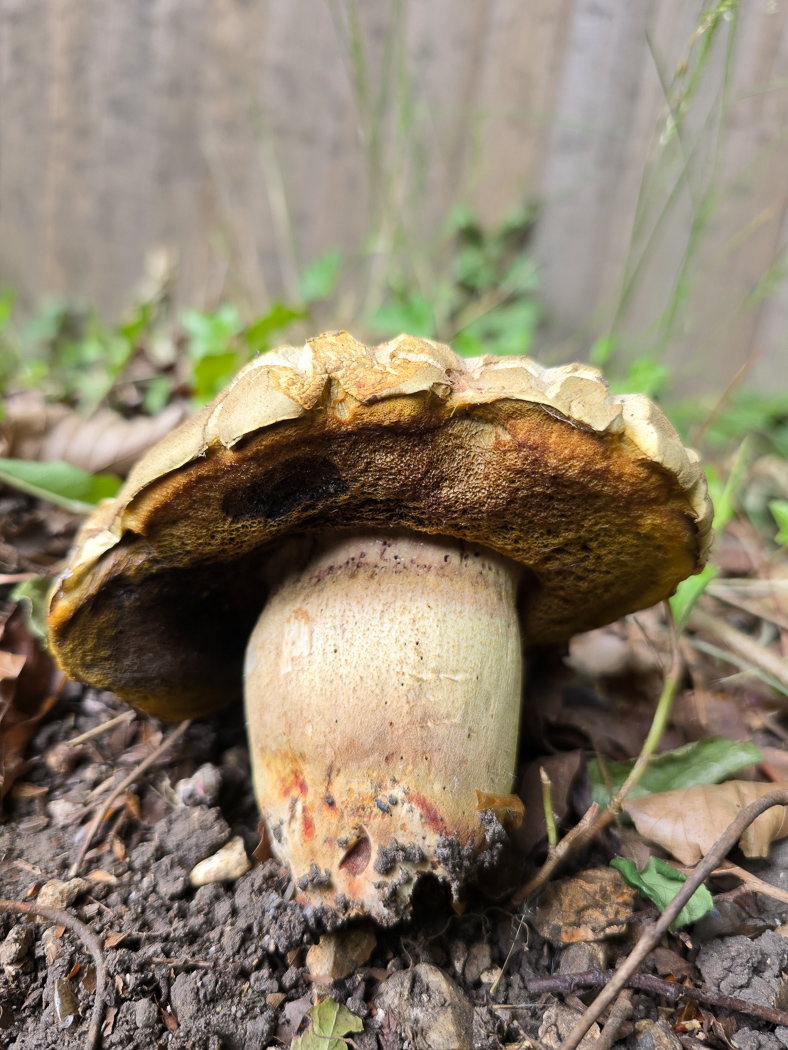
|
May 23rd
In Chalfont St. Peter Jesper Launder was astounded to come across this very early bolete which, though somewhat old and cracked, had somehow managed to force its way through the baked dry soil relatively unscathed. The species favours Oak and is one which has fine yellow pores which don't stain blue when pressed or damaged, but the most significant field character is its strong smell of iodine (hence its English name) best detected at the stem base and which Jesper noted was very evident today.
|
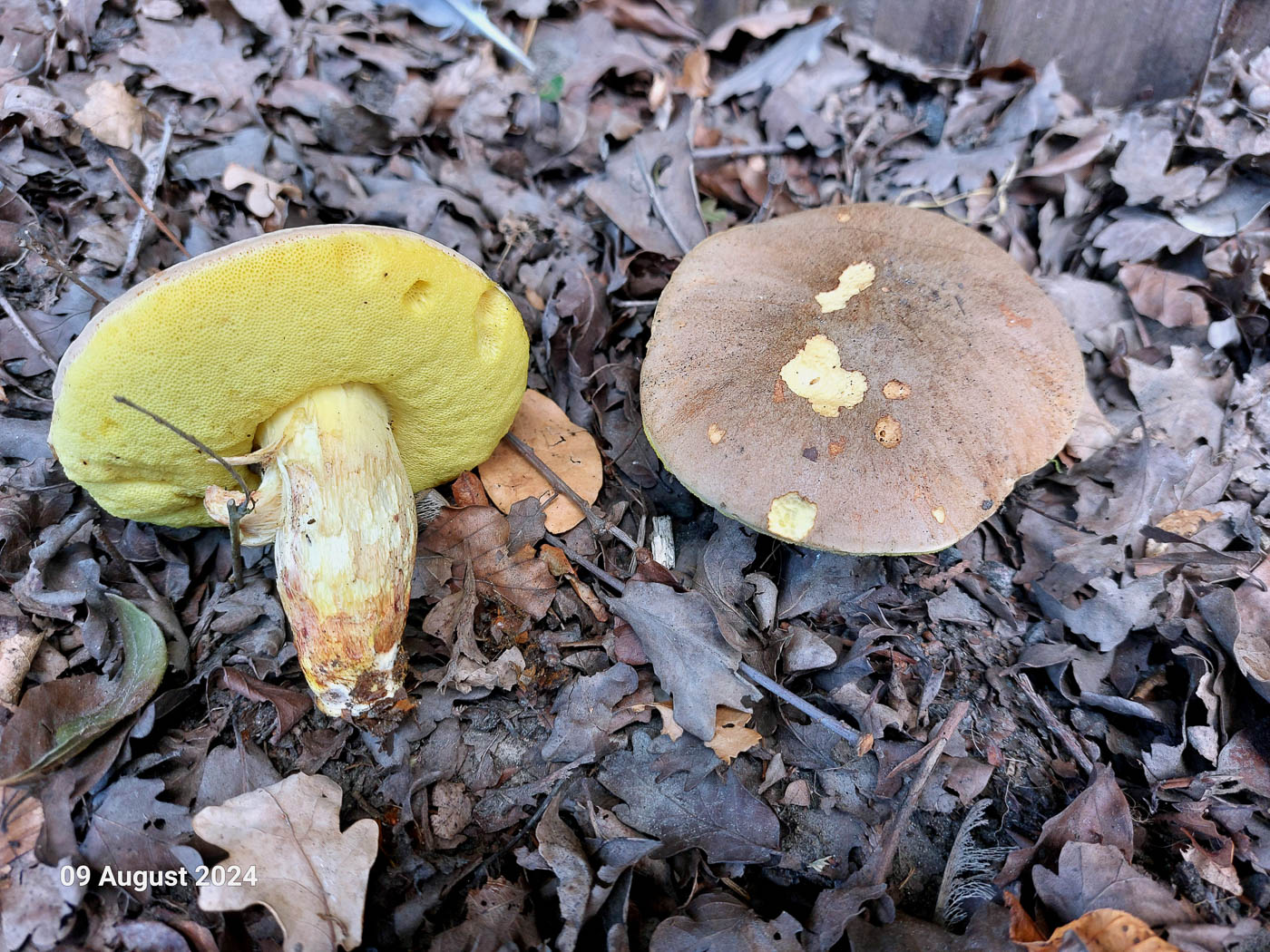 |
Aug 9, 2024. In a roadside verge under Oak in Gerrards Cross Jesper Launder found this smart pair of boletes despite the area being very dry. On picking one the strong smell of iodoform was immediately apparent (Jesper described them as reeking!) leaving him in no doubt as to the species, this confirmed with one press of the pores which then failed to show any sign of blueing. This is a large chunky solid species with a preference for sandy calcareous soils under Oak and should present no problems to identify if the smell and lack of blueing on the pores are noticed. |
  |
Jun 11, 2024. Under Oak in Beaconsfield Jesper Launder found this unusual Bolete and though still immature it was evident to which species it belonged. The reason for the link to the genus Leccinum in its name is the slight network on the stem - not visible here due to its immaturity. It also notably has pale yellow pores which don't turn blue when pressed, and when fresh a distinct smell of iodine at the stem base when first collected. It has a preference for Oak in sandy or chalky soils. |
    |
Jun 7, 2023. Under Oak in Gerrards Cross Jesper Launder found this 'whopper' (his description!) though badly nibbled - and no doubt much enjoyed - by slugs. This is a substantial Bolete with yellow pores which do not stain blue when pressed / damaged but its most distinctive feature is found at the rusty stem base which has a strong smell of iodine especially when cut. Today's specimen was apparently reeking of it on collection! Photos 3 and 4 were taken at the same spot three days later when a better specimen made an appearance - note the cracked cap presumably as a result of its exposed sunny position. (The species was moved from genus Boletus to the newly created Hemileccinum in recent years.) Boletes and Brittlegills (see also below) are both genera which tend to appear early in the season though June is considered pretty early. |
 |
Sep 16, 2022. In Seer Green under Oak Jesper Launder spotted this pair. This is a substantial species (previously in Boletus) with a palish cap and yellow pores and stem. Two features to note which separate it from the possibly similar B. radicans (see the entry from yesterday for comparison): the pores and flesh are unchanging when pressed and the cut flesh at the stem base reportedly has a smell of iodoform. It occurs usually under Oak in parks, grassy places rather than woodland and is considered an occasional fruiter. |
 |
Aug 15, 2021. Under Oak in Jordans village Jesper Launder noticed a sizeable bolete which had been dislodged but was not too badly damaged to identify. Previously known as Boletus impolitus and one of the Oak associates, it is notable in having solid flesh, bright yellow pores which don't stain blue when pressed and a strong smell of iodoform at the stem base particularly when cut or damaged - all three characters noted by Jesper. Though described as quite common, we have only a handful of records for the county. |
  |
Sep 21, 2020. Greg Douglas came across this somewhat unusual bolete (previously Boletus impolitus) growing in a grassy path edge under Oak in Little Kingshill. A chunky species with a firm feel to it, the key characters are the pale brown smooth cap (here cracking due to the recent hot sun), very small yellow pores which do not stain blue on pressing and the yellowish stem which tends to taper at the bottom. The common name refers to the unusual smell of iodine which should be checked for if the stem base is cut. |
| Hemimycena cucullata (Hooded Bonnet) |
  |
Aug 13, 2021.  On a pile of rotting mossy branches, probably Hazel, in Rushbeds Wood Penny noticed a few small mycenoid white caps, some clustered together, and took a couple home to work on. Caps were under 1 cm across, gills were somewhat crowded and tending towards decurrent, and stems were thin, finely pruinose and with straggly hairs at the base. At home the spores were long and thin, eliminating Mycena, and other microscopic features together with the field characters mentioned keyed out to H. cucullata, an unusual species which we've recorded just five times from three other sites, it being new for Rushbeds. On a pile of rotting mossy branches, probably Hazel, in Rushbeds Wood Penny noticed a few small mycenoid white caps, some clustered together, and took a couple home to work on. Caps were under 1 cm across, gills were somewhat crowded and tending towards decurrent, and stems were thin, finely pruinose and with straggly hairs at the base. At home the spores were long and thin, eliminating Mycena, and other microscopic features together with the field characters mentioned keyed out to H. cucullata, an unusual species which we've recorded just five times from three other sites, it being new for Rushbeds.
|
| Hemimycena mairei (Fanvault Bonnet) |
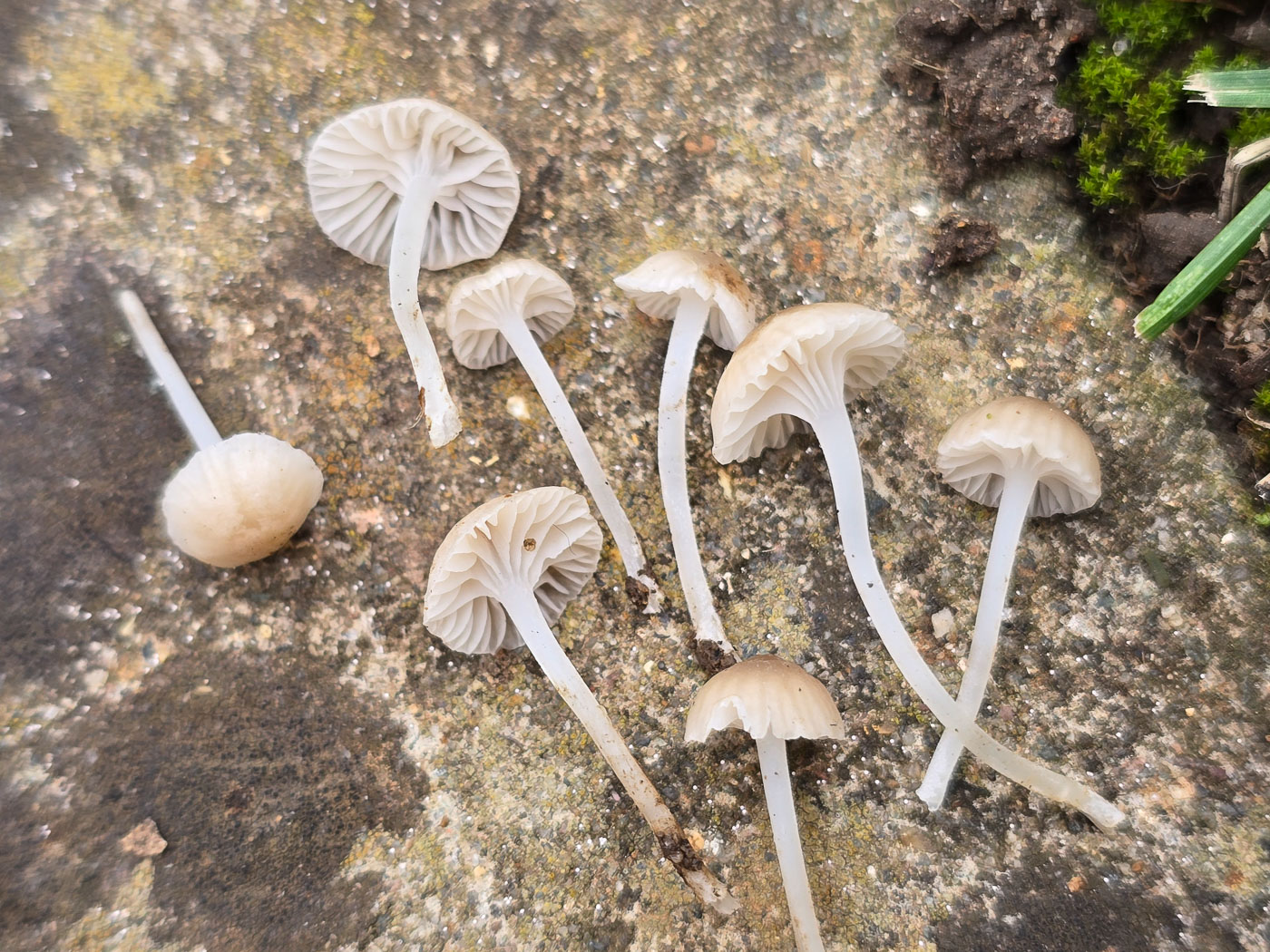
|
Sep 14, 2025.  In a grassy patch in Gerrards Cross Jesper Launder collected this little group and arranged them on a slab in order to show the distinctive rather distant gills with decurrent attachment as well as the pale cap colour. Any members of this genus need careful checking in order to make an ID and this is not a common species and favours mossy grass. We have 10 previous county records from just 3 sites. In a grassy patch in Gerrards Cross Jesper Launder collected this little group and arranged them on a slab in order to show the distinctive rather distant gills with decurrent attachment as well as the pale cap colour. Any members of this genus need careful checking in order to make an ID and this is not a common species and favours mossy grass. We have 10 previous county records from just 3 sites. |
Hemimycena tortuosa (Dewdrop Bonnet)  |
 |
Aug 9, 2023. At College Lake Gill Ferguson found two tiny white gilled mushrooms on damp woody remains, noticing the droplets on the short stem and cap. Derek then examined it and confirmed from the amazing corkscrew hairs which cover it and which act as a trap for the moisture droplets which are nearly always present and give a clue to its identity. The species is in fact quite common - certainly the commonest Hemimycena - and under a scope it is always a delight to see these unique hairs. The photo is Barry Webb's. |
  |
Nov 8, 2022. On a log pile of fallen Pear in his garden in Burnham Russell Ness found several specimens of this minute white Mycenoid species which favours damp deciduous logs. The first indication that you have this species rather than any other (there are many such to be found on wood) are the moisture droplets which tend to get trapped by the cells on the surface of the mushroom, some of which form unique miniscule corkscrews which Russell managed to locate with a scope. The species is not rare but easily overlooked or mistaken for some other white Mycenoid. |
  |
Dec 23, 2020. Barry Webb took these beautiful photos of a tiny little Mycenoid mushroom he found on an old Apple branch he keeps in his greenhouse in case interesting things come up on it! Derek and Penny have made this identification just from the photo, so it is not confirmed microscopically but surely can be nothing else, though neither of us have seen specimens so entirely covered in droplets. The cap surface has tiny corkscrew-shaped cells which trap the moisture, thus the dewdrop effect. Happy Christmas to all - photo 1 would make a good Christmas card! |
| Hemitrichia calyculata (a Slime Mould with no English name) |
 |
Aug 21, 2023. At Burnham Beeches Barry Webb found this quite unusual Myxomycete - one for which we have just his three previous records in the last few years, two of which are from this site. The distinctive conical 'cup' with frilly edge which forms underneath the now mature fertile part is typical of this particular species, making it recognisable on sight. |
 |
Mar 23, 2022. In Burnham Beeches this was the second of two fairly common slime mould species Barry Webb found on fallen rotting Birch. For more images see Barry's separate Finds page. |
 |
Mar 9, 2021. Barry Webb found this beautiful slime mould on fallen rotting Birch in Common Wood. Though described as a common species in the south, this appears to be our first county record - reflecting the general lack of local expertise and interest in slime moulds until Barry put this right and started producing his amazing photos.There are several very similar species, so Penny would have been happier to have checked the microscopic characters as it's a first for the county, but the dark solid stalk suddenly flaring out at the top together with the tear-drop shaped sporangium (spore bearing mass) having a shallow shiny cup with typically frayed edges is sufficiently diagnostic to confirm Barry's determination. |
| Hemitrichia serpula (a rare Slime Mould with no English name) |
 |
Dec 1, 2022. At Hedgerley Green Barry Webb was excited to find this rare species growing on a fallen Laurel leaf. Not only new to the county, it is a species with few UK records though with climate change it is beginning to occur naturally in woodland rather than in hothouses. Its shape and form certainly make it distinctive and to Penny it is reminiscent of a tiny Cadbury's 'Curly Wurly'!
|
| Henningsomyces candidus (White Tubelet) |
.jpg) |
Dec 4, 2024. At Burnham Beeches these tiny white beauties were spotted by Jesper Launder on some fallen Pine. Each miniscule tube is less than 1mm tall and the species tends to form swarms on conifer wood though a hand lens is needed to appreciate the detail. It is a basidiomycete belonging to the cyphelloids, and is not uncommon but easily overlooked for obvious reasons. The photo is Barry Webb's. |
 |
Nov 10, 2022. On the underside of a fallen branch at Round Spring Wood, Dancersend, a swarm of these tiny white tubes was spotted. A handlens is needed to be able to see their perfect shape because each tube is less than 1mm tall. Though easily overlooked it is not common but is clearly actively growing at the moment because we also found it on our Rushbeds walk a couple of days later. The photo is Neil Fletcher's. |
 |
Oct 7, 2020. Barry Webb focuses (literally!) on Slime Moulds but in doing so comes across interesting fungi growing on the same rotting wood frequented by those organisms. This rare and stunning little species is one of these, found on a piece of dead conifer wood collected from Burnham Beeches and kept in Barry's greenhouse to see what it might produce! The individual tiny tubes are here only about 0.5 mms tall and can get to 1 mm at most, and this amazing photo is a vast improvement on those available on line. It is not an Ascomycete but is a Cyphelloid species, listed together with the brackets etc and appears to be confined to rotting conifer wood. We have just one previous record in the county. |
| Hericium cirrhatum (Tiered Tooth) |
 |
Oct 22, 2023. In Captains Wood Chesham Greg Douglas had been watching this fungus develop on an old Oak log, felled many years ago, and eventually realised that it was developing 'teeth' underneath. Assuming, therefore, that it was one of the 'Hydnoid' species he sent his photo to Penny who has named it purely on the evidence of his photo but there can surely be little doubt over its identity. It ticks all the boxes for this species, one of three in the genus and all considered rare though this is perhaps the least rare but still an exciting find. It favours Beech - as do the other Hericium species - but also occurs on old wood of other deciduous trees, Ash and Elm also being mentioned. We have records from just 4 other sites, mostly Burnham Beeches, with one previous Finds entry: 2020 October August 31st |
 |
Aug 31, 2020. Claire Williams found this rare and beautiful fungus fruiting on the same fallen Beech trunk in Naphill Common as it was last year when it was recorded here for the first time. Not quite as rare as the similar H. erinaceus (which also occurs on this site) it is notable for having fine tubes (known as teeth) underneath in place of gills or pores. |
| Hericium coralloides (Coral Tooth) |
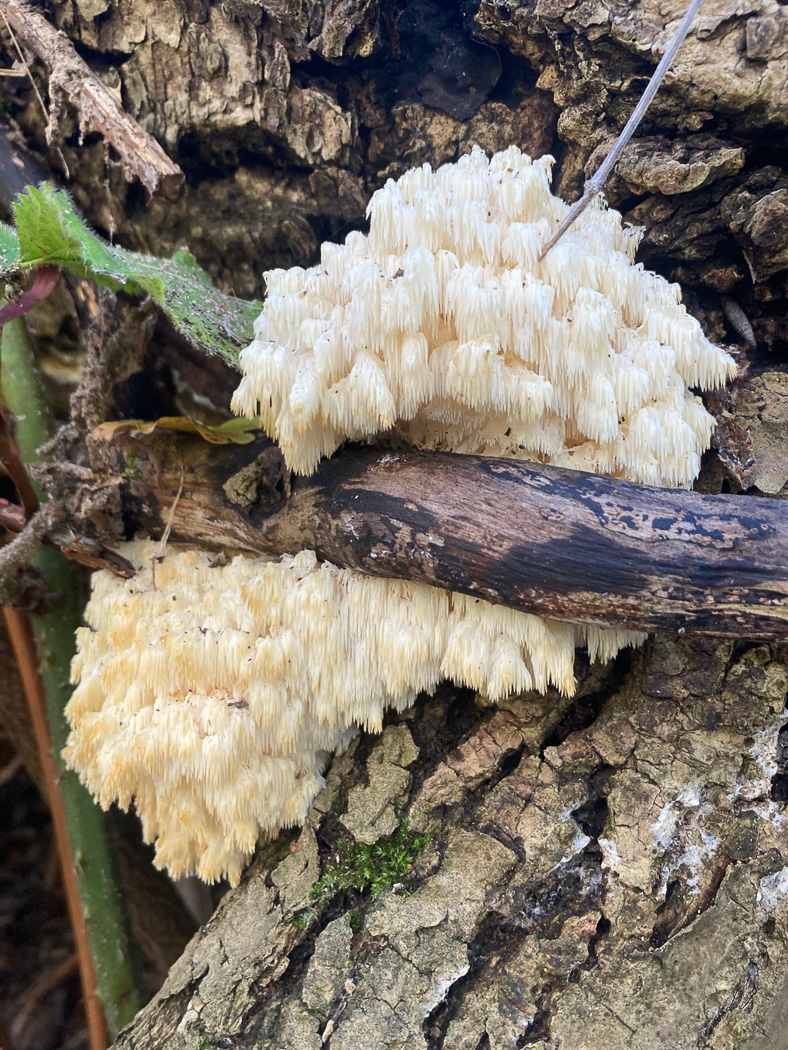
|
Nov 30, 2025. In Bunces Wood near Marlow Mark Harris was somewhat excited when he and his wife spotted this beautiful and rare species on a fallen trunk. He recalled seeing a similar species on our Hockeridge Wood walk in September so realised it was a close relative, so sent the photo to Penny who in turn checked it with Jesper Launder who was green with envy! With very few county records this is a special find at a new site, though Mark was unsure of the host trunk. From his photo it doesn't appear to be Beech so could possibly be Ash. |
   |
Nov 25, 2022. After a tip-off that this rare and special species had been found fruiting in Egypt Woods, Penny and Sarah Ebdon went in search and were successful! They found several fruiting bodies on an old rotting Beech trunk and in reasonable condition considering the recent weather. Though not quite as showy as the even rarer H. erinaceus, this is a stunning toothed fungus, categorised as Endangered in the 2015 Red Data List. This century our county records are restricted to two sites, one from Langley Park and two from nearby Burnham Beeches, with no records since 2009. Clearly this is a new entry for Find. Photo 1 is Penny's, photo 2 is Sarah's, and photo 3, taken the following day, is Russell Ness's when he also went to find the species.
|
| Hericium erinaceus (Bearded Tooth) |
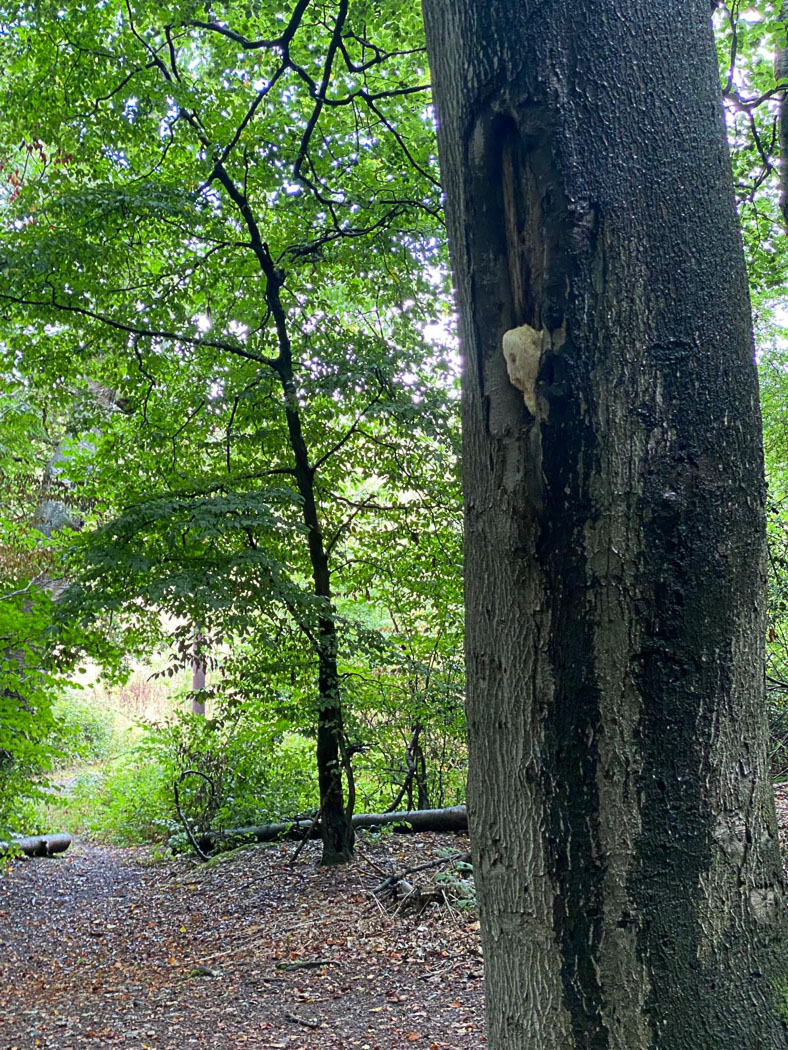   
|
Sep 3, 2025. Penny received an email plus three photos from a member of the public who had found this very rare fungus on a Beech trunk in a woodland in the outskirts of Amersham. The species being so unique in appearance there seems little doubt about the ID and it is great news that a new site for it has now come to light (though the site details are withheld here for obvious reasons!). The photos were sent in by Julie Harrison and the finder was her son Joey. Then 10 days later Paul Goby sent in photo 4 from Naphill Common where this charismatic species is now beginning to fruit again. |
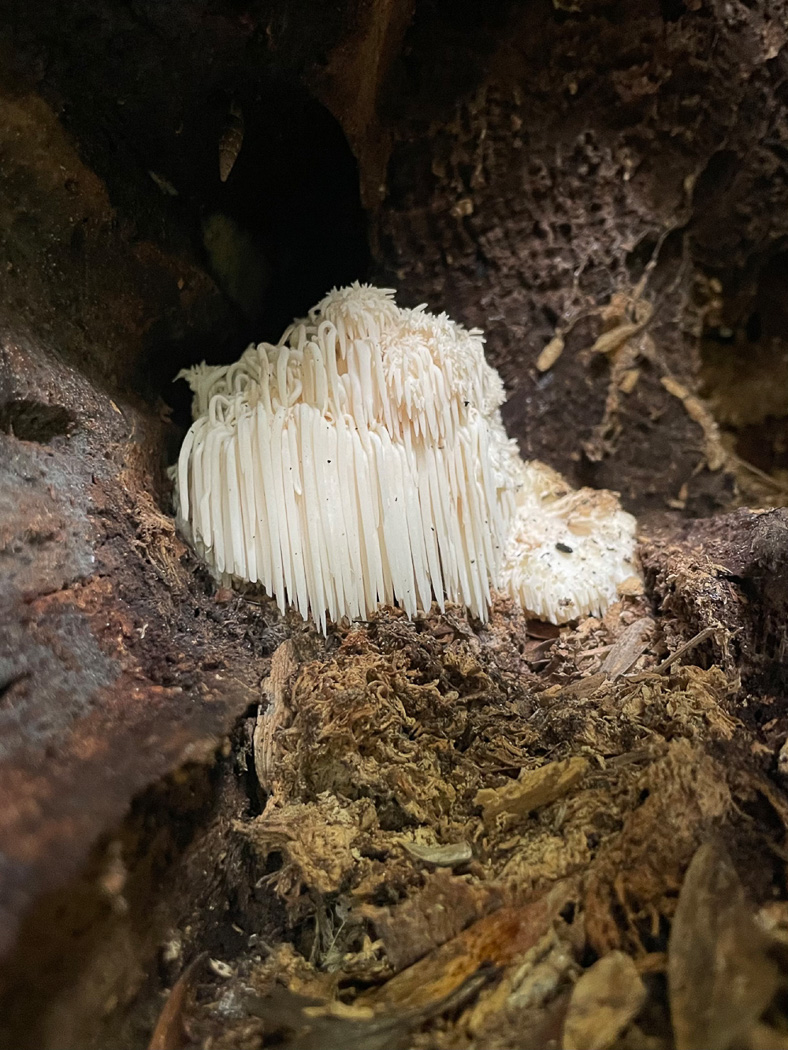 .jpg) |
Oct 19, 2024. After information from a member of the public of a sighting of this rare species in the Bucks part of the Ashridge Estate, Sarah Ebdon went to investigate. She managed to find it though it was apparently still only a few cms across and inside a fallen rotting Beech trunk. This is a beautiful and special fungus, protected by law, and has probably been fruiting on this tree for several years though unnoticed. Hopefully it will continue to do so - this is an important find. |
  |
Oct 14, 2021. Penny was delighted to receive information of a new county site for this rare and impressive fungus. She went to check it out and although still quite small it was unmistakable (photo 1). The beautiful Photo 2 is of the same specimen taken later in October but not sent in to Penny till April 2022 when Robert Corran joined BFG and also informed Penny of his find, describing the identical Beech trunk at the same site. (The site is not revealed here for obvious reasons!) |
 |
Oct 3, 2020. Sarah Ebdon and others had been watching out for the return of this amazing very rare fungus in Naphill Common and sure enough it has reappeared, much to everyone's delight and relief. A species found only on mature deciduous trees, especially Beech as here, it forms large white spiny circular masses growing to 20 cm across or more. (Compare also with H. cirrhatum dated Aug 31, a smaller relative and not quite so rare.) Sadly later this season this beautiful species was completely vandalised before coming to fruition. |
| Hesperomyces harmoniae (a recently described ascomycete ectoparasite) |
      |
Jun 24, 2024. Sarah Ebdon collected a ladybird in Princes Risborough and took it home to identify, noticing that some tiny yellowish fungal spikes were beginning to appear out of its back. With the help of Stephen Plummer, the ladybird was identified as Harmonia axyridis (Harlequin Ladybird), and she noted that by the next day the fungal spikes were increasing (photos 2 & 3). Intrigued by this somewhat gruesome development, she determined to identify the fungus if possible. Derek was able to point her to a useful paper online, and this led her to a more recent paper describing this new species separated from the Hesperomyces species complex known to parasitise many Ladybird species almost worldwide. The species is host specific to the Harlequin Ladybird and though this appears to be new to the UK (ie is not yet included in FRDBI or CBIB) the 2022 paper quotes a sequenced collection from Oxfordshire (2011). However, this is such an exciting find with excellent observation and detective work that it surely deserves a blue box - denoting new to the UK. After all, it is the first identified collection since the official publication of the species. It is hoped that a sample will be dried and sequenced. Congratulations to Sarah! Sarah took the final three photos a week later having been incubating the ladybird in her fridge and feeding it aphids. Meanwhile it produced literally hundreds of eggs!
|
| Heterobasidion annosum (Root Rot) |
  |
Nov 15, 2020. Penny C. noticed this quite common bracket on an unidentified stump in Penn Wood. It forms thick chunky semicircles which are hard and lumpy and has quite fine rounded cream pores underneath. Commonly on conifer but also found on deciduous trees, it is considered a dangerous parasite attacking living trees. It has a strong resinous fungoid smell.
|
| Heteroradulum (previously Eichleriella) deglubens (Blushing Crust) |
 |
Feb 13, 2021.  Jesper Launder found this apparently not uncommon but in Bucks much under-recorded 'corticioid' fungus fruiting on fallen Willow in Jordans village. Our database shows just three previous records, none since 2005, though it would appear to be quite distinctive in both colour and texture, becoming pinkish brown and developing isolated spines - visible in the photo. It can be found (often in Winter and early Spring) on fallen dead wood of many different deciduous trees but frequents Beech and Ash as well as Willow as here. One we should definitely find more often locally. Jesper Launder found this apparently not uncommon but in Bucks much under-recorded 'corticioid' fungus fruiting on fallen Willow in Jordans village. Our database shows just three previous records, none since 2005, though it would appear to be quite distinctive in both colour and texture, becoming pinkish brown and developing isolated spines - visible in the photo. It can be found (often in Winter and early Spring) on fallen dead wood of many different deciduous trees but frequents Beech and Ash as well as Willow as here. One we should definitely find more often locally.
|
| Hodophilus foetens (Stinking Fanvault) |
 |
Dec 9, 2023.  In a hotel car park in Gerrards Cross Jesper Launder was checking a patch of moss to see how his collection of the rare Tulostoma brumale - found at this spot a month earlier - was faring. It was apparently flourishing, but he was even more delighted to discover this species nearby - also rare. We have just three previous county records under its previously genus name Camarophyllopsis, and it is described as favouring grassy mossy areas at woodland edges but always scarce. Features to note are the widely spaced decurrent gills and strong unpleasant smell. This is a new entry for Finds. In a hotel car park in Gerrards Cross Jesper Launder was checking a patch of moss to see how his collection of the rare Tulostoma brumale - found at this spot a month earlier - was faring. It was apparently flourishing, but he was even more delighted to discover this species nearby - also rare. We have just three previous county records under its previously genus name Camarophyllopsis, and it is described as favouring grassy mossy areas at woodland edges but always scarce. Features to note are the widely spaced decurrent gills and strong unpleasant smell. This is a new entry for Finds.
|
| Hodophilus variabilipes (Flecked Fanvault) |
 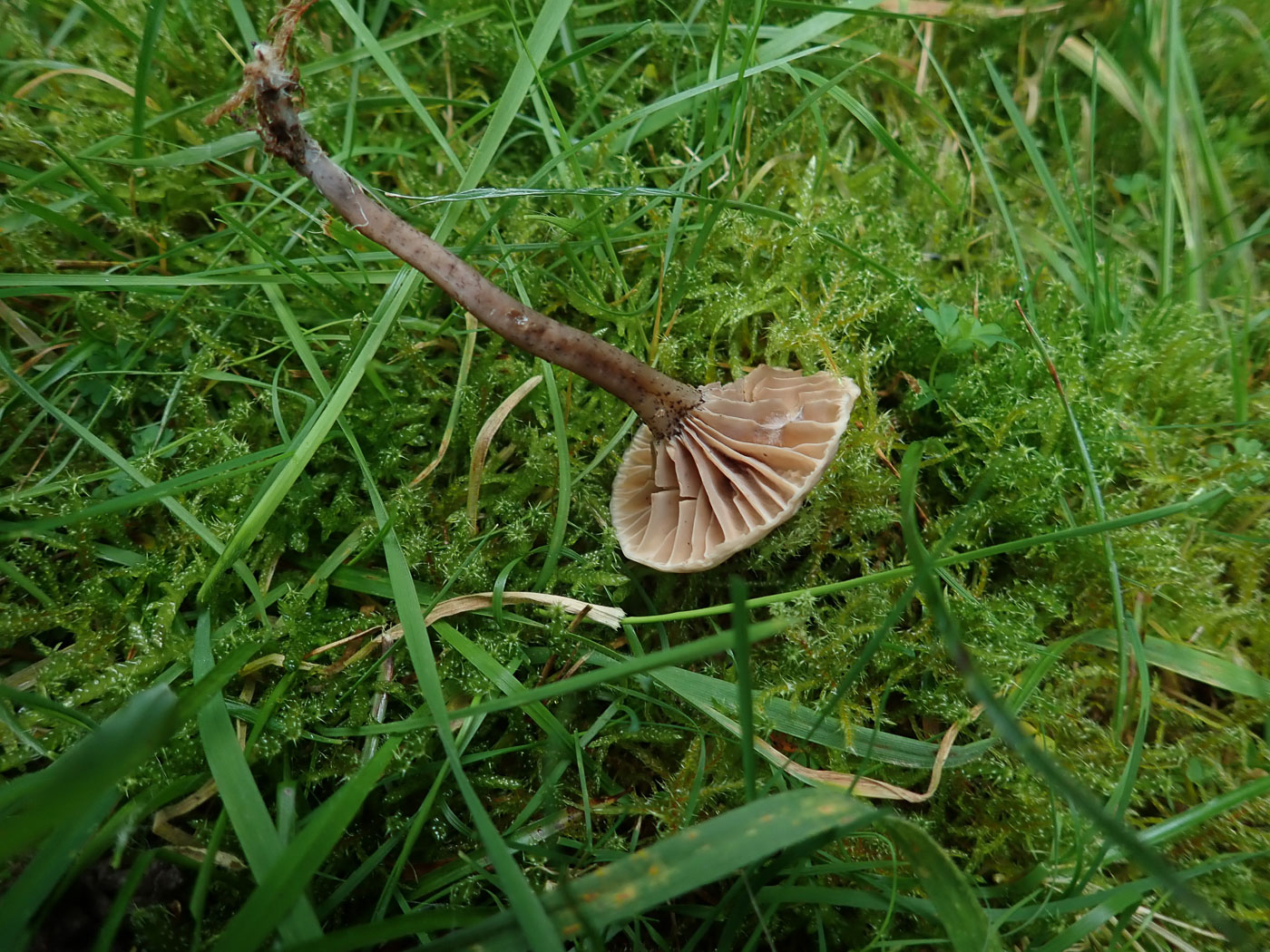 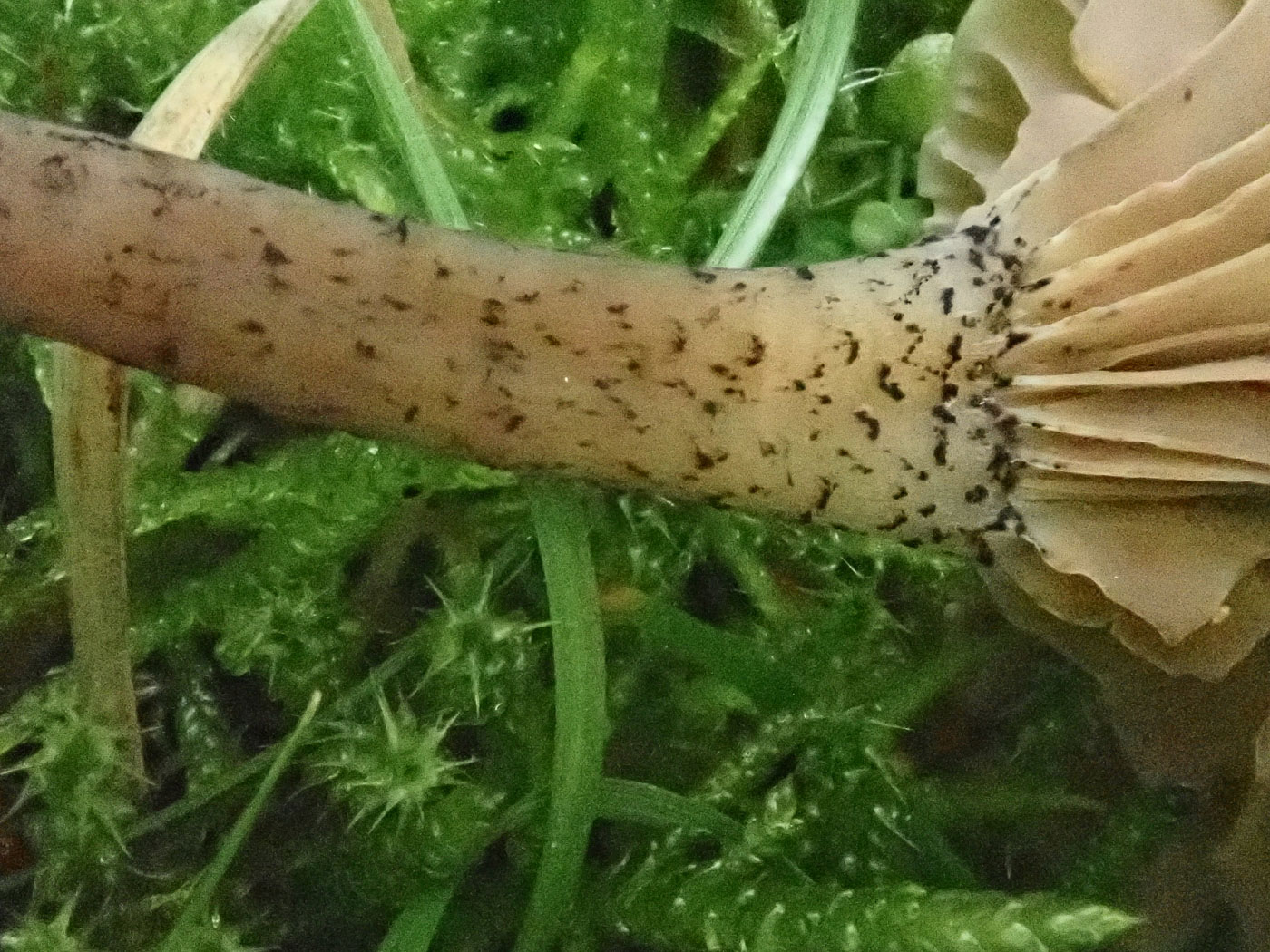 |
Nov 5, 2024.  Under a large Yew at Prestwood Churchyard Penny and Sarah spotted this singleton amongst the mossy grass. The cap was unfamiliar to them both and it was not until picked that the strongly decurrent and widely spaced gills together with black markings on the stem became apparent. They wondered at the time about the genus Arrhenia but later both guessed at the genus Hodophilus which the microscopic features seemed to fit. However, there are two very similar species which can have these black spots on the stem, both rare, and without access to more detailed descriptions they cannot be sure if this is the species suggested here or maybe H. atropunctus (Dotted Fanvault). Therefore for now this record should remain as H. cf. variabilipes and hopefully sequencing will remove the doubt. The photos are Penny's. Under a large Yew at Prestwood Churchyard Penny and Sarah spotted this singleton amongst the mossy grass. The cap was unfamiliar to them both and it was not until picked that the strongly decurrent and widely spaced gills together with black markings on the stem became apparent. They wondered at the time about the genus Arrhenia but later both guessed at the genus Hodophilus which the microscopic features seemed to fit. However, there are two very similar species which can have these black spots on the stem, both rare, and without access to more detailed descriptions they cannot be sure if this is the species suggested here or maybe H. atropunctus (Dotted Fanvault). Therefore for now this record should remain as H. cf. variabilipes and hopefully sequencing will remove the doubt. The photos are Penny's.
|
  |
Dec 28, 2023.  In soil under Yew at St. James's Churchyard Gerrards Cross, Jesper Launder found this extremely rare species - one which is new to the county with only three previous UK records. The following day he found this same species again, this time elsewhere in Gerrards Cross in a grassy verge under conifer. He at first identified it as H. hymenocephalus, extremely similar to H. variabilipes which was only described in 2017 and is therefore missing from available keys. Both species were previously in genus Camarophyllopsis. The Gerrards Cross area - often explored by Jesper - is proving particularly interesting for fungi, presumably owing to its unusual sandy gravelly soil conditions which set it apart from the typical chalky Chiltern conditions. Jesper has uncovered a range of different and unusual species here in the last few years. In soil under Yew at St. James's Churchyard Gerrards Cross, Jesper Launder found this extremely rare species - one which is new to the county with only three previous UK records. The following day he found this same species again, this time elsewhere in Gerrards Cross in a grassy verge under conifer. He at first identified it as H. hymenocephalus, extremely similar to H. variabilipes which was only described in 2017 and is therefore missing from available keys. Both species were previously in genus Camarophyllopsis. The Gerrards Cross area - often explored by Jesper - is proving particularly interesting for fungi, presumably owing to its unusual sandy gravelly soil conditions which set it apart from the typical chalky Chiltern conditions. Jesper has uncovered a range of different and unusual species here in the last few years.
|
| Hohenbuehelia cf. atrocoerulea (Indigo Oyster) |
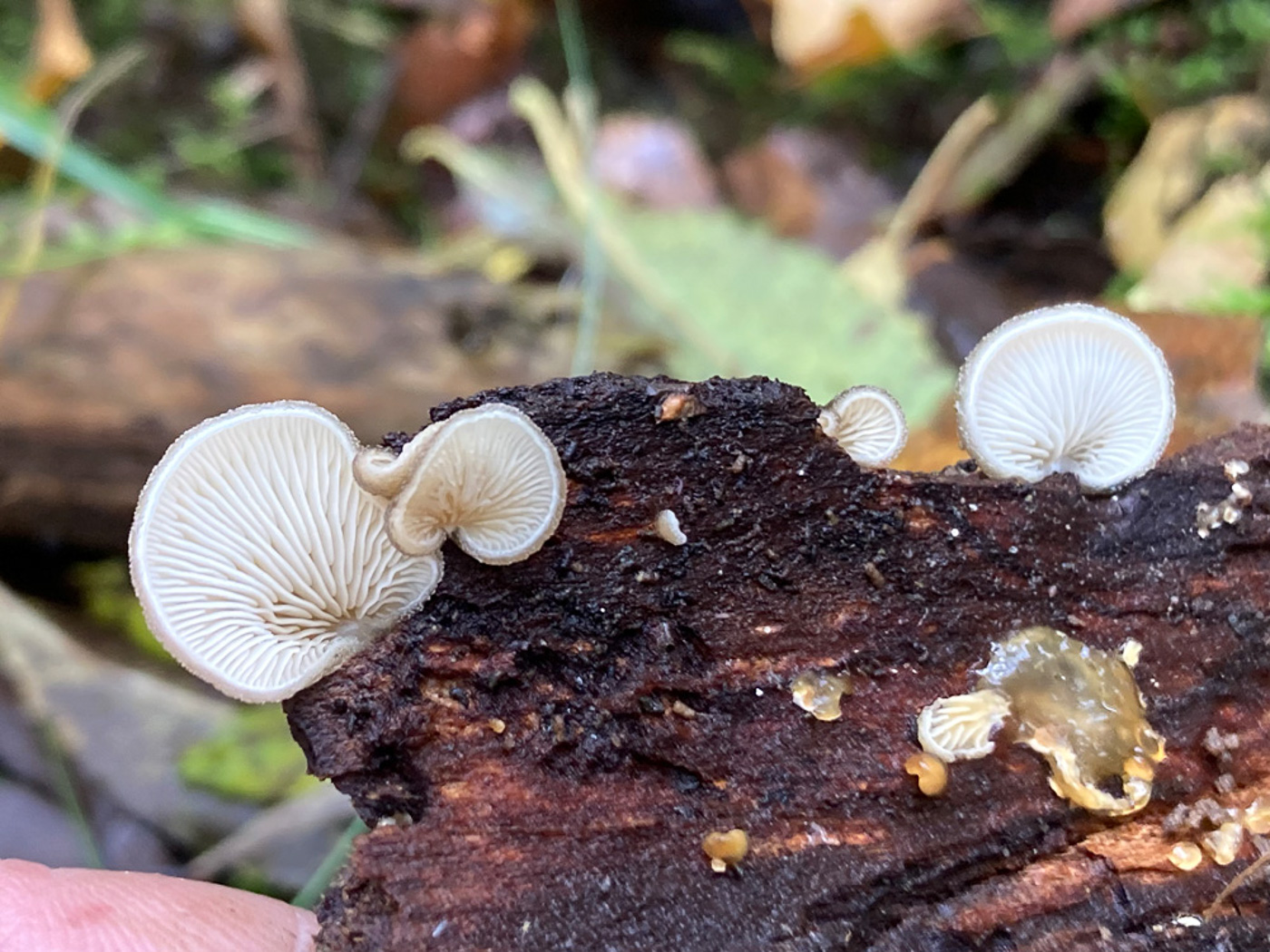 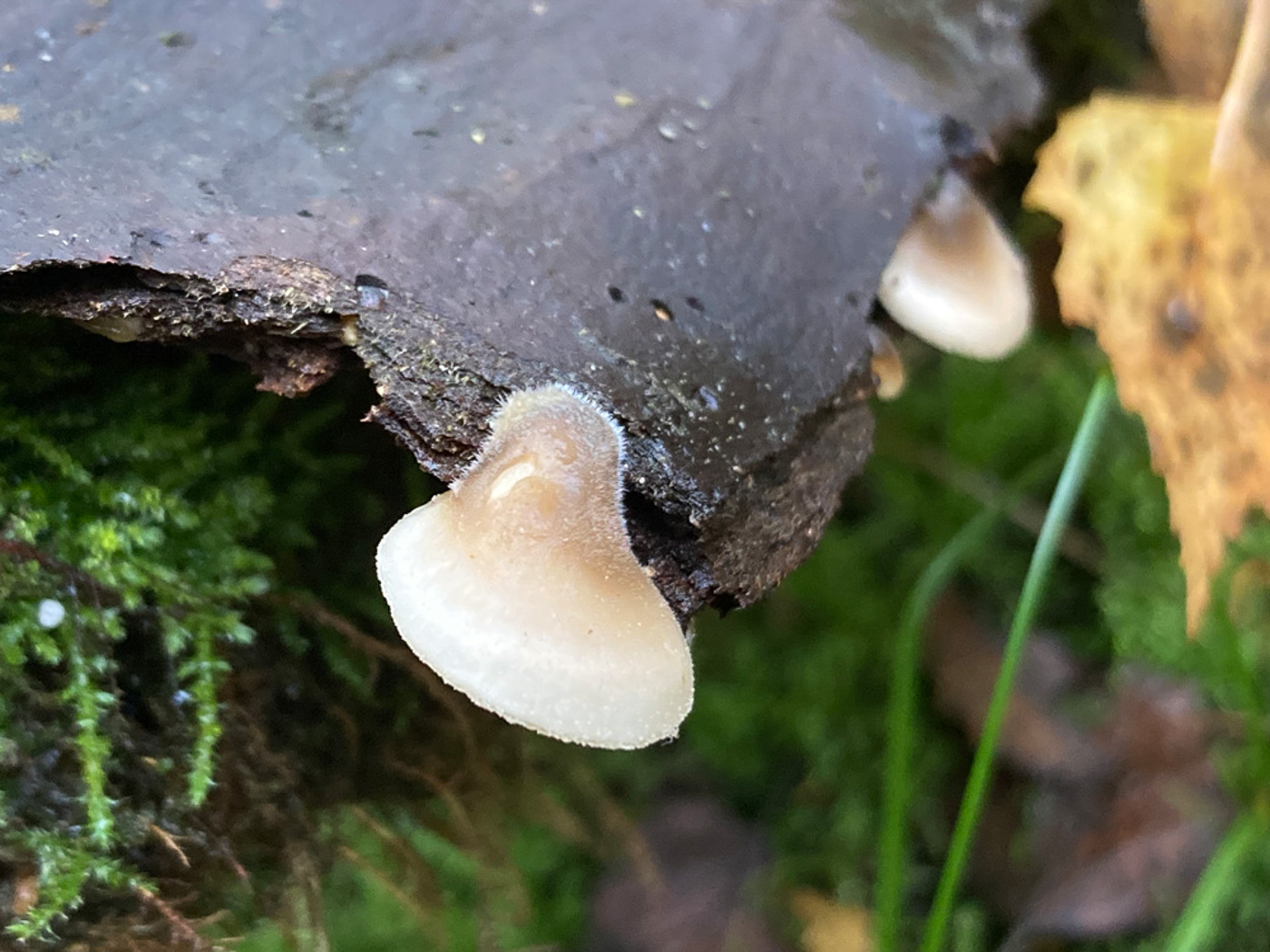 |
Oct 17, 2024.  In Burnham Beeches Russell Ness came across this small 'pleurotoid 'species on fallen Willow. Though superficially similar to some other small species having either no stem or an eccentric stem, this rare genus has very different microscopic features and rather gelatinous sticky texture (which enables it to trap nematodes which supply an extra source of nutrients). Russell keyed this collection out with care and found it fitted best with H. atrocoerulea despite the complete lack of blue - normally a distinctive feature. For this reason there has to be some doubt in the determination and we hope to get a sample sequenced. This is a new entry for Finds and we have just three previous county records. In Burnham Beeches Russell Ness came across this small 'pleurotoid 'species on fallen Willow. Though superficially similar to some other small species having either no stem or an eccentric stem, this rare genus has very different microscopic features and rather gelatinous sticky texture (which enables it to trap nematodes which supply an extra source of nutrients). Russell keyed this collection out with care and found it fitted best with H. atrocoerulea despite the complete lack of blue - normally a distinctive feature. For this reason there has to be some doubt in the determination and we hope to get a sample sequenced. This is a new entry for Finds and we have just three previous county records.
|
| Hohenbuehelia grisea (Grey Oyster) |
  |
Nov 19, 2023.   In Naphill Common near the border with Downley Common Sarah Ebdon came across a deciduous trunk liberally dotted with a 'pleurotoid' species which she quickly realised was not just a common or garden Oyster mushroom. This was later confirmed at home when a scope revealed thick walled crystal-tipped cells together with other equally unusual cells on the gill leading her to the rare genus Hohenbuehelia. Returning a week or so later for further material (though by then it was somewhat frozen), once thawed she was able to study it in much detail picking both Penny's and expert Carol Hobart's brains for help and then confirmed her thoughts that this keyed out to the very rare H. mastrucata (though she recalled later debating whether it might possibly be the even rarer H. grisea!). A sample was dried for sequencing and eventually the results came back with the surprising confirmation that it was indeed H. grisea, not only new to the county but with only one record on FRDBI. Interestingly this record was of a collection made in Herefordshire just four days after Sarah's find and later examined and confirmed by Martyn Ainsworth at Kew, making it possibly the first UK record, in which case Sarah's - now confirmed with sequencing - presumably over-rides it! Penny will check with Martyn if this is the case. This was certainly an exciting find - especially in such numbers seen in photo 1. (The more orange specimens on the lower left in photo 1 were Flammulina velutipes.) In Naphill Common near the border with Downley Common Sarah Ebdon came across a deciduous trunk liberally dotted with a 'pleurotoid' species which she quickly realised was not just a common or garden Oyster mushroom. This was later confirmed at home when a scope revealed thick walled crystal-tipped cells together with other equally unusual cells on the gill leading her to the rare genus Hohenbuehelia. Returning a week or so later for further material (though by then it was somewhat frozen), once thawed she was able to study it in much detail picking both Penny's and expert Carol Hobart's brains for help and then confirmed her thoughts that this keyed out to the very rare H. mastrucata (though she recalled later debating whether it might possibly be the even rarer H. grisea!). A sample was dried for sequencing and eventually the results came back with the surprising confirmation that it was indeed H. grisea, not only new to the county but with only one record on FRDBI. Interestingly this record was of a collection made in Herefordshire just four days after Sarah's find and later examined and confirmed by Martyn Ainsworth at Kew, making it possibly the first UK record, in which case Sarah's - now confirmed with sequencing - presumably over-rides it! Penny will check with Martyn if this is the case. This was certainly an exciting find - especially in such numbers seen in photo 1. (The more orange specimens on the lower left in photo 1 were Flammulina velutipes.)
|
Hohenbuehelia mastrucata (Woolly Oyster)  |
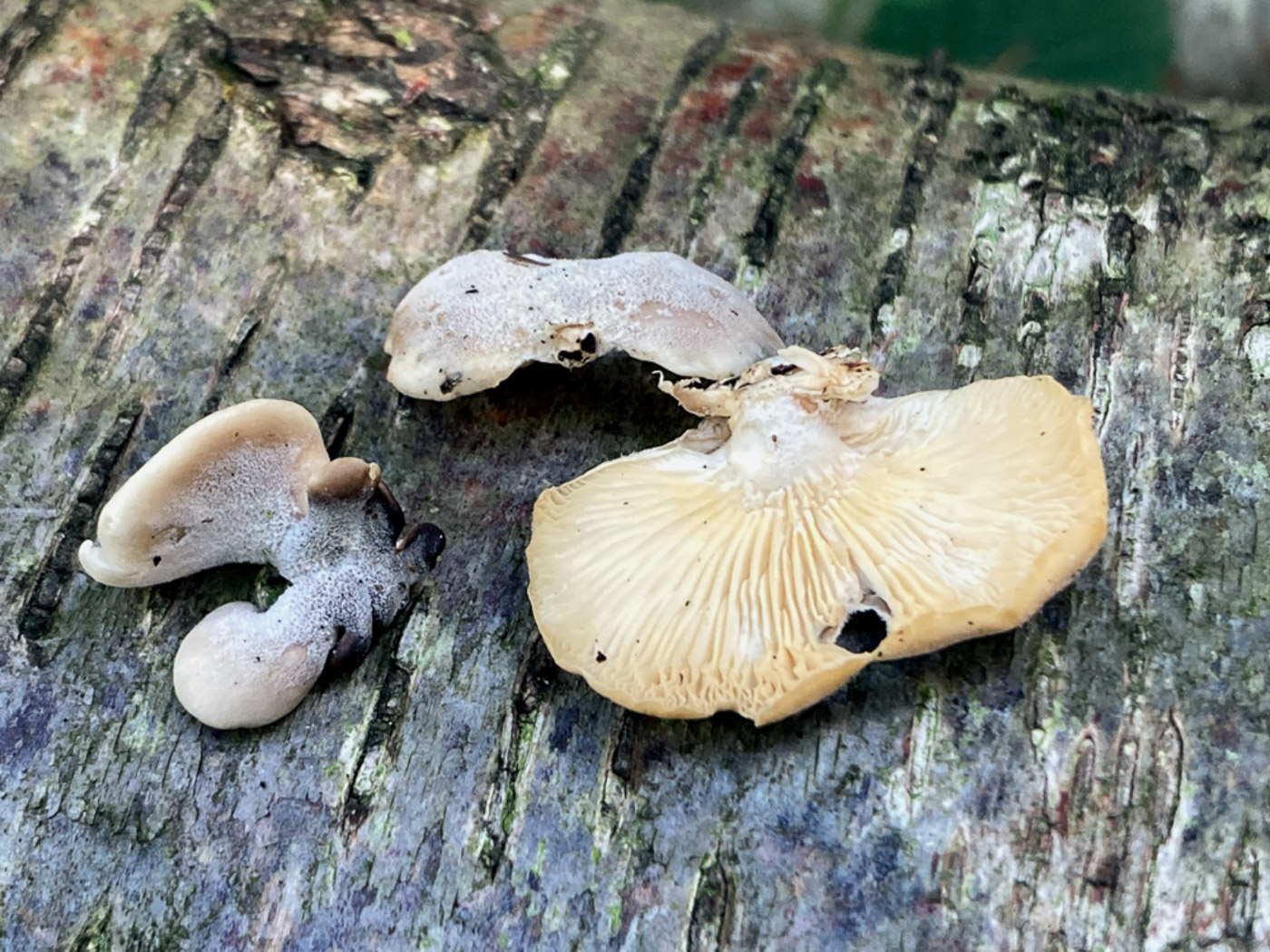
|
Sep 13, 2025.  In Stoke Common Russell Ness found this small and rare species on some fallen dead deciduous wood (from his photo possibly Birch) and took it home to work on. The shell-like shape, furry surface and greyish colour together with the very distinctive micro-characters found in this genus soon led him to the name. We have just a handful of previous records but it is a new find for Stoke Common; a sample will be sequenced. In Stoke Common Russell Ness found this small and rare species on some fallen dead deciduous wood (from his photo possibly Birch) and took it home to work on. The shell-like shape, furry surface and greyish colour together with the very distinctive micro-characters found in this genus soon led him to the name. We have just a handful of previous records but it is a new find for Stoke Common; a sample will be sequenced. |
   |
Feb 10, 2024. In Egypt Woods back in November Russell Ness found one fruitbody of this somewhat unusual pleurotoid mushroom on a huge fallen Beech at about the time that Sarah Ebdon identified and took images of a good display of it from Naphill Common. As the winter had been so mild Russell returned in February to check on it and found these fresh examples in the same spot. He comments that the Latin species name means sheepskin and that as it dries the woolly cap surface becomes much more apparent - almost like a whitish coating (seen in photo 3). |
   |
Dec 17, 2023. In Downley Common Sarah Ebdon found that the tree where she'd discovered this rare Hohenbuehelia a month ago was still fruiting away though now the fruitbodies were lower down and more accessible for photography. Clearly this particular trunk must be supporting the organism throughout its length for such a prolific display. Photo 3 shows its finely hairy cap surface. |
| Hohenbuehelia petaloides (Floury Oyster) |
 |
Oct 17, 2021.  In Jordans village a friend of Jesper Launder found this rare fungus in a hanging basket in her garden, hence the Begonia leaves in the background! Jesper then worked out the identification using reference books and a scope. The genus has very individual cells on the gill edge and all species are considered rare. We have just one authenticated county record, from Ibstone Common in 1979 made by Roger Phillips. So this was certainly a special find. In Jordans village a friend of Jesper Launder found this rare fungus in a hanging basket in her garden, hence the Begonia leaves in the background! Jesper then worked out the identification using reference books and a scope. The genus has very individual cells on the gill edge and all species are considered rare. We have just one authenticated county record, from Ibstone Common in 1979 made by Roger Phillips. So this was certainly a special find.
|
| Homophron (previously Psathyrella) spadiceum (Chestnut Brittlestem) |
 |
Nov 20, 2022.  On a rotting woodchip pile in Burnham Beeches our small group found a couple of mushrooms which at the time Penny guessed (incorrectly!) might be a species of Inocybe (Fibrecap). This is known to be a somewhat deceptive species and not a typical Brittlestem (having now been moved from genus Psathyrella) and has several features both macro- and microscopically similar to Inocybe, and it took Penny several hours of puzzling to work out its identity. There still remains some doubt as not all features were a perfect match and a specimen will be sequenced to confirm. It is not that rare but certainly not common and was new to the site today. (The photo is Penny's.) On a rotting woodchip pile in Burnham Beeches our small group found a couple of mushrooms which at the time Penny guessed (incorrectly!) might be a species of Inocybe (Fibrecap). This is known to be a somewhat deceptive species and not a typical Brittlestem (having now been moved from genus Psathyrella) and has several features both macro- and microscopically similar to Inocybe, and it took Penny several hours of puzzling to work out its identity. There still remains some doubt as not all features were a perfect match and a specimen will be sequenced to confirm. It is not that rare but certainly not common and was new to the site today. (The photo is Penny's.) |
  |
Dec 12, 2021.  In the grounds of Cliveden Estate Russell Ness found this singleton mushroom which puzzled him and took some to identify later. Previously in genus Psathyrella, there are a few species which have cells on the gill which differ considerably from the norm for the genus, i.e. having thick walls and often with crystals on top - these species have now been moved to the new genus Homophron, today's species being one of them. The gill cells are very distinctive but most Brittlestems need a scope to identify as field characters are rarely individual enough to be able to name without the added microscopic information. In the grounds of Cliveden Estate Russell Ness found this singleton mushroom which puzzled him and took some to identify later. Previously in genus Psathyrella, there are a few species which have cells on the gill which differ considerably from the norm for the genus, i.e. having thick walls and often with crystals on top - these species have now been moved to the new genus Homophron, today's species being one of them. The gill cells are very distinctive but most Brittlestems need a scope to identify as field characters are rarely individual enough to be able to name without the added microscopic information. |
Hortiboletus bubalinus (Ascot Hat)  |
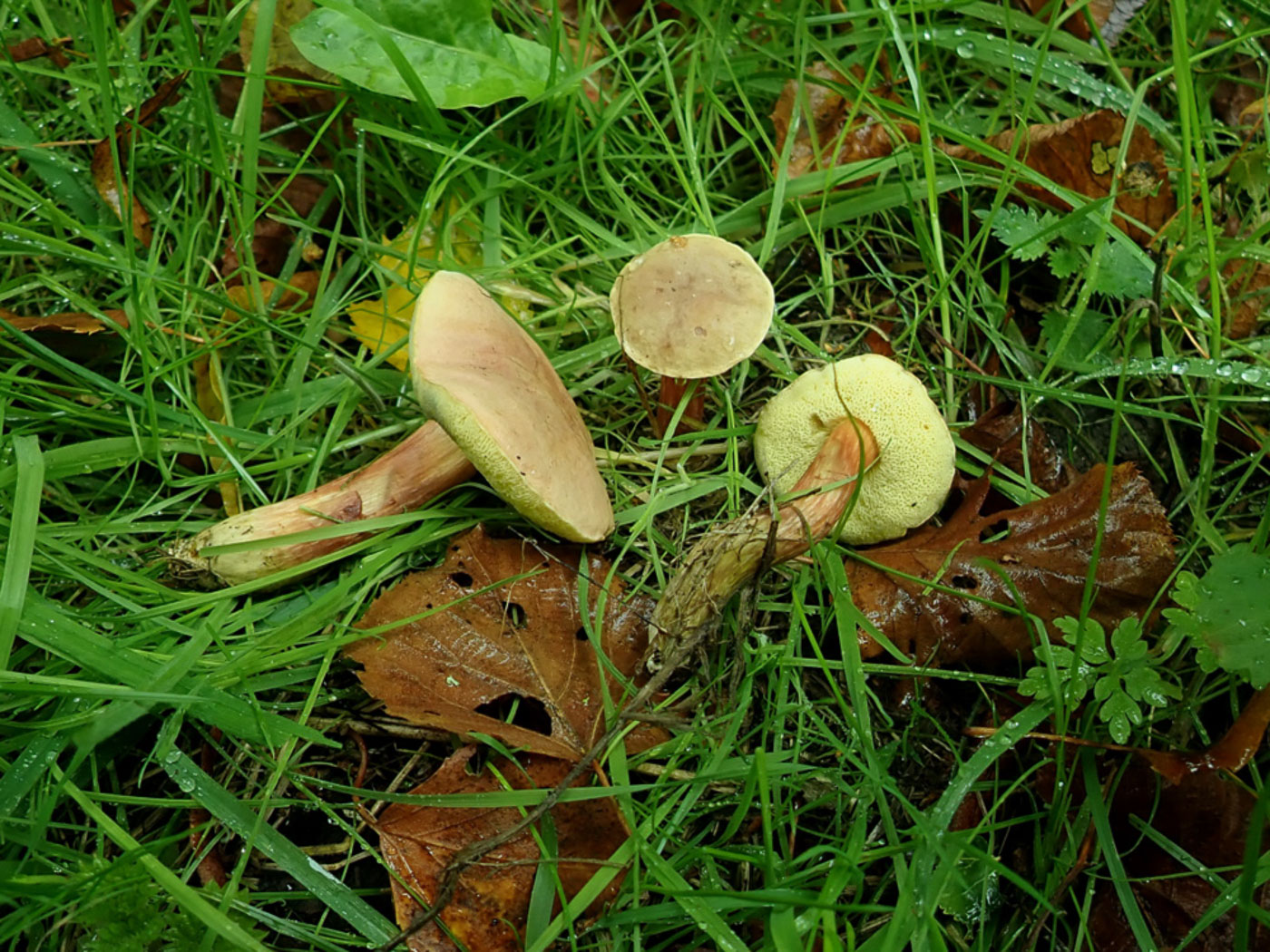 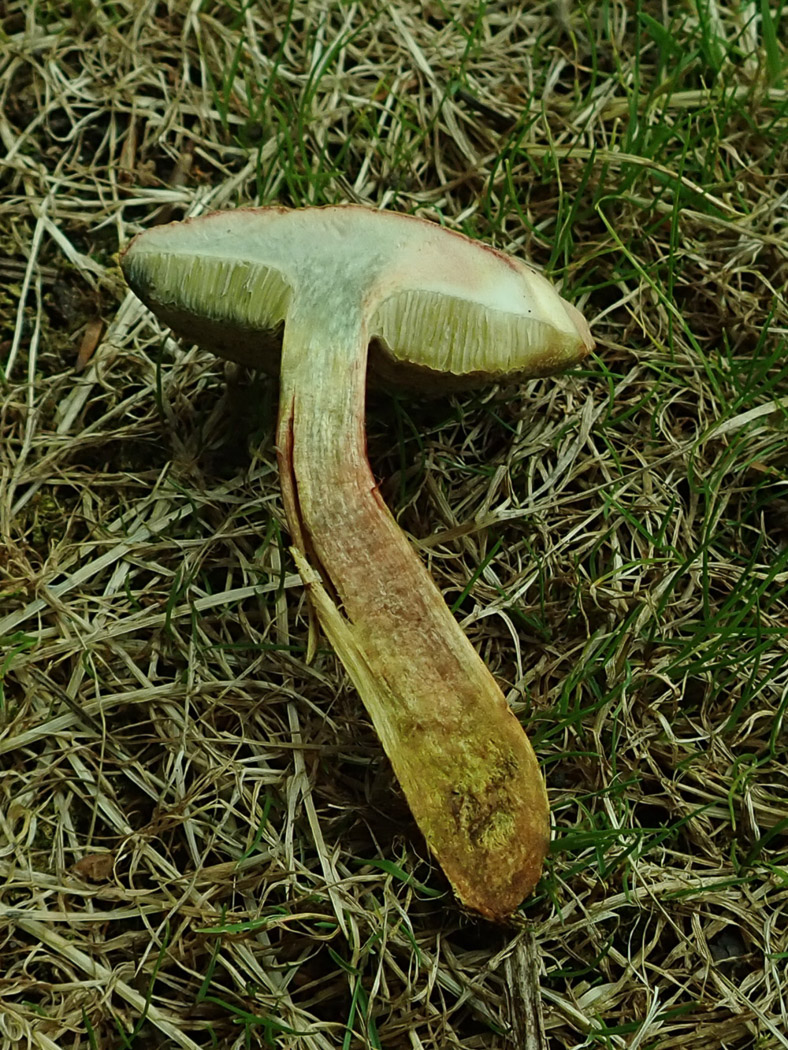
|
Sep 17, 2025. At Turville Heath there were literally hundreds of Xerocomellus–type boletes with red-cracking caps which Penny ignored - they aren't her favourite! But she spotted these three under the Limes which caught her eye because they appeared very different: cap with no cracking but rather a velvety surface, also with a soft peachy pink tinge. These she collected and was glad that she had because when at home she cut one in half lengthways the blue tinge to the cap flesh though pink just under the cuticle was a perfect match to this species which she'd never found before. The yellowish flesh in the lower stem also matched, and this together with its apparent preference for Lime clinched it for her. There are only around 20 FRDBI entries, all since 2016 as the species was not recognised as British until then. |
   |
Aug 5, 2023. In Chalfont St Peter in a grassy verge near Birch Jim Wills spotted this Bolete and thought the cap looked an interesting colour, so took it home to work on, noting that the soft yellowish pores blued when pressed. Slicing it in half lengthways revealed after a little time pink flesh immediately under the cuticle but above the tubes distinctly blue flesh - a unique feature of this particular species which is possibly quite common but goes unrecognised or misnamed as one of the very similar 'red-cracking' types of Xerocomellus. The cap colour is described as more buff - even apricot, but can also be pinkish as in our previous Finds entry - 2022 September 15th - when it was new to the county. It apparently favours Poplar and Lime, quite often in urban areas, but has also been recorded with Oak and Pine. |
 |
Sep 15, 2022. In his garden in Jordans village Jesper Launder found this lovely collection of boletes under Lime. This is a species very close to H. rubellus (compare with a collection found two days earlier) and has a subtle cinnamon to pinkish cap though the colour is variable, and when cut open the cap (also sometimes the stem) flesh stains pale blue, often with a pink zone just under the cap cuticle. The yellow pores also stain blue when pressed. It lacks the orange dots in the stem base seen in H. engelii (also in Finds today) and the cap is not the intense red seen in young fresh H. rubellus (though this colour fades in maturity). It occurs un Oak, Lime and Poplar though often on open parkland / gardens rather than woodland. This is a first for Bucks, though the species is not really rare but probably mistaken for other more familiar Boletes. Jesper's ID of this collection has now been confirmed with DNA sequencing and asample will be sent to Kew Fungarium. |
| Hortiboletus engelii (Orangefoot Bolete) |
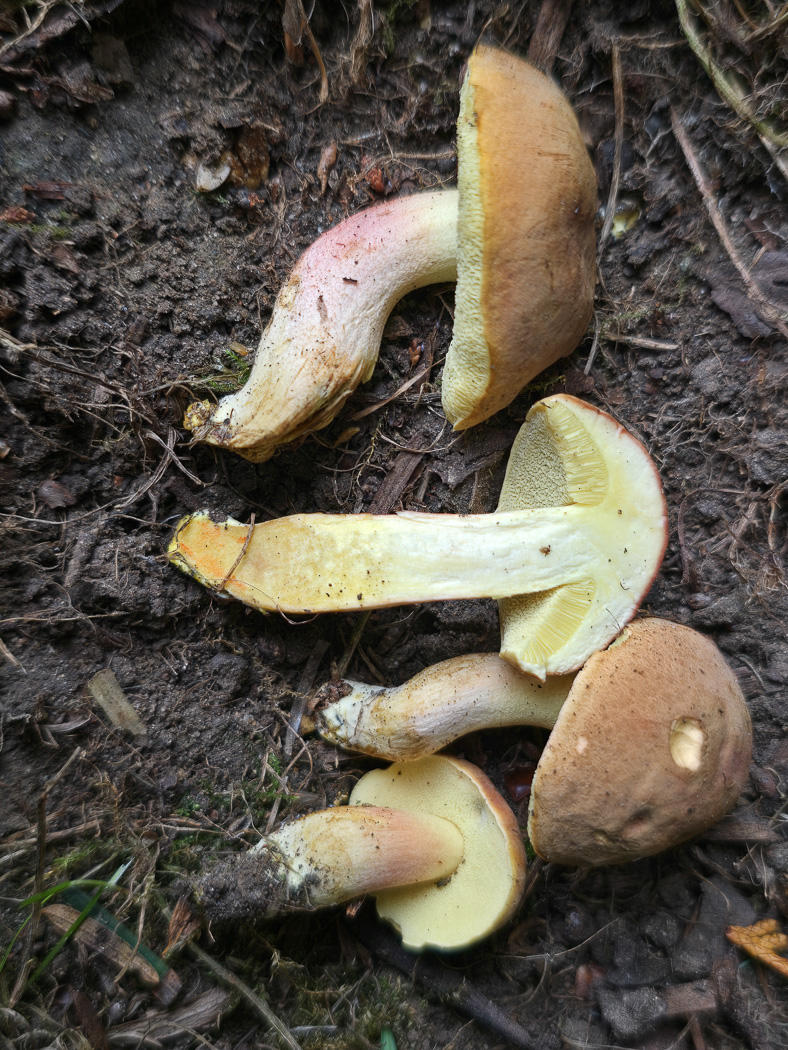
|
Sep 14, 2025. In Gerrards Cross under Oak Jesper Launder found a nicely typical group of this species which shows the diagnostic orange spotting on the flesh at the stem base of the central split specimen here. It makes life easier when this feature is as convincing as it is here, thus eliminating several other similar boletes with which the species can be confused, but this is not always the case - more's the pity! |
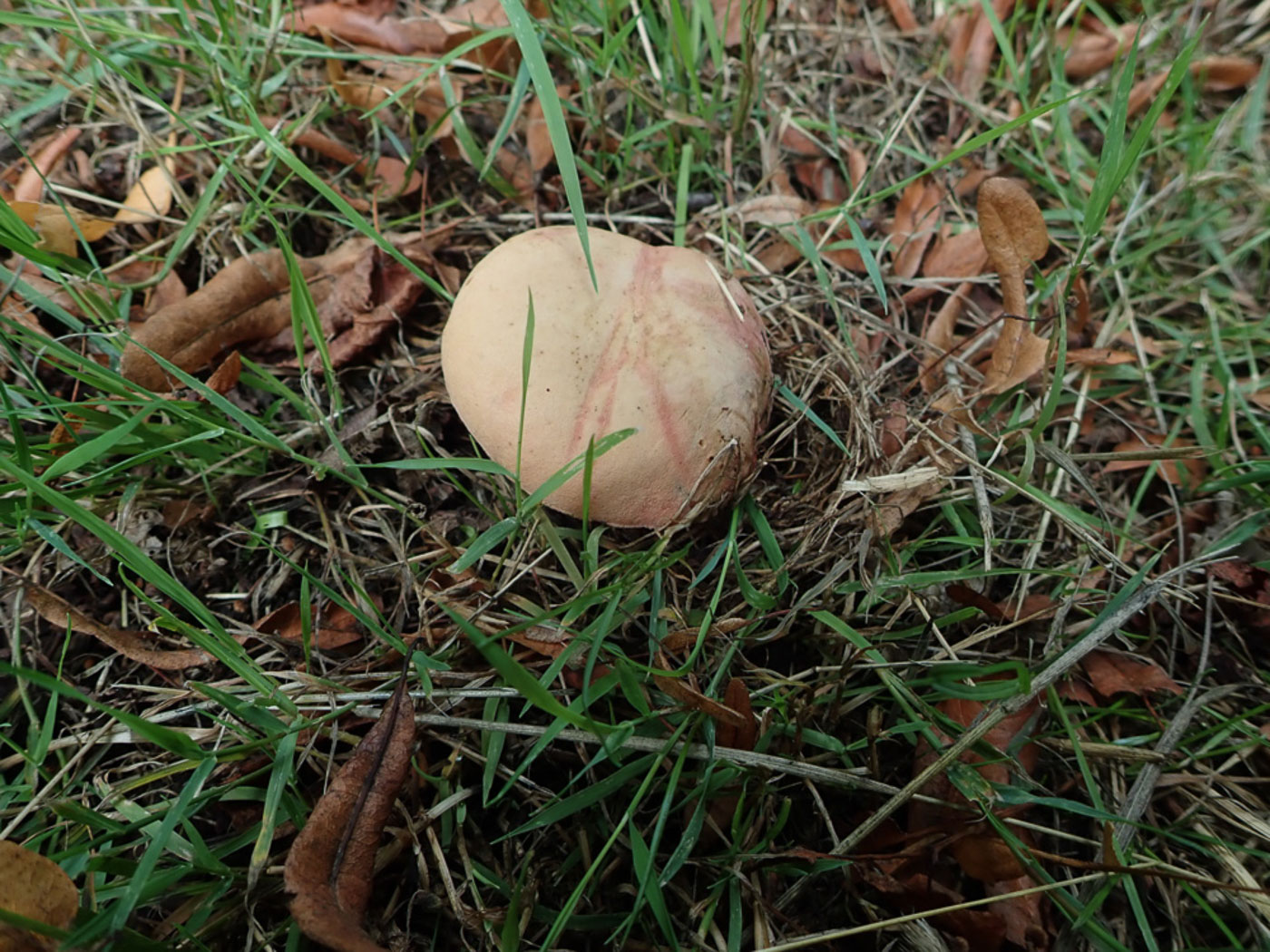 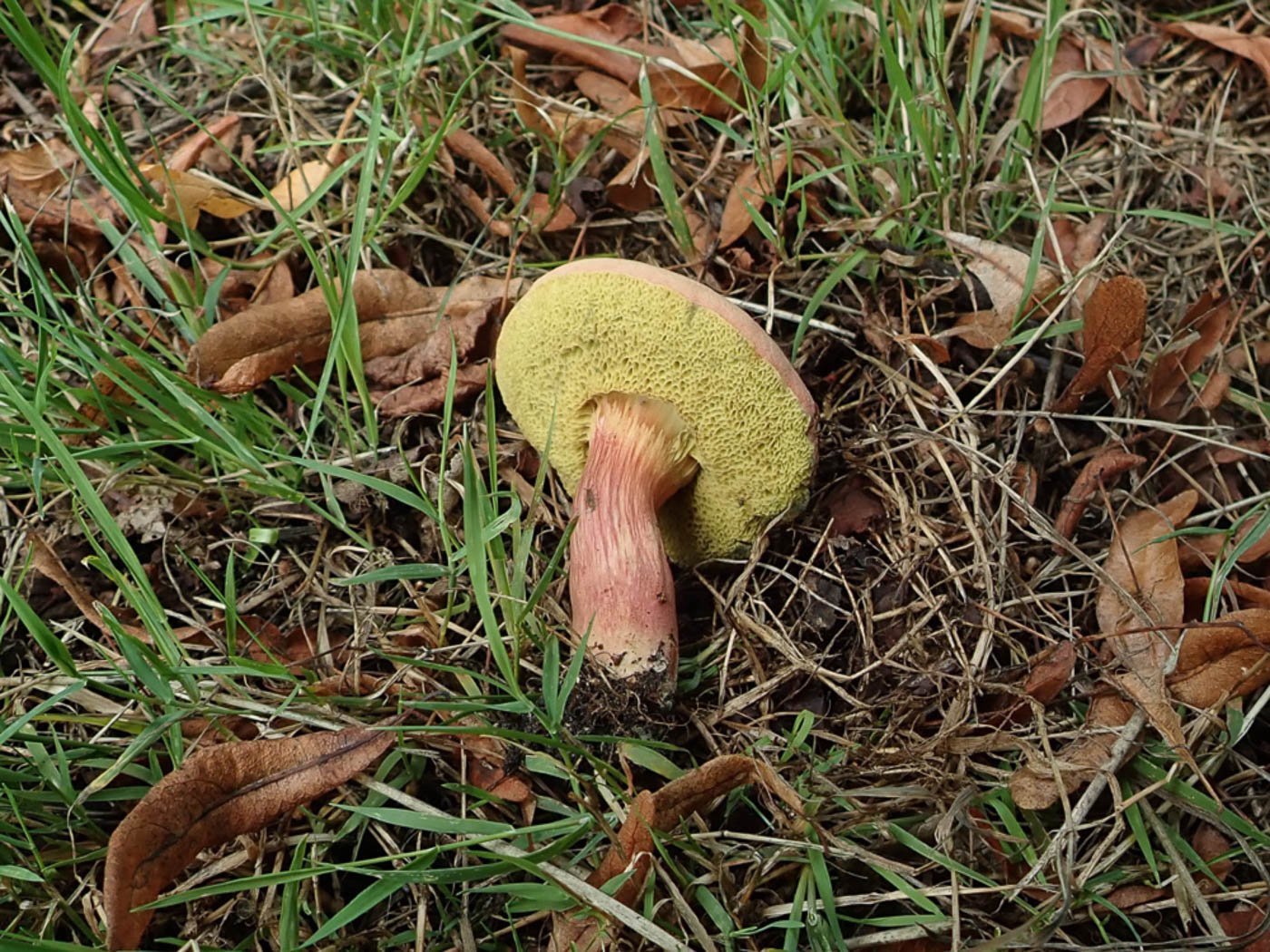
|
Aug 1, 2025. In a grassy roadside verge under Lime at Turville Heath Penny came across this unusual coloured cap, and took her photo in situ before turning it over to discover whether it had gills or pores. The distinctive pores of a Bolete were, however, not a surprise though this is her first Bolete of the season. She noted the pores blued only fairly slowly and this together with other clues checked later at home decided her on this ID. Images of both H. engelii and H. bubalinus show both can have this pinky peach buff matt appearance together with reddish stem (reminiscent of H. rubellus also). However, cutting open the whole fruitbody lengthwise revealed the telltale carrot-red dots at the stem base and the lack of any blue tints in the cap flesh which eliminated H. bubalinus. |
   |
Jul 17, 2023. In Gerrards Cross Jesper Launder found this common species under Oak - it's most usual host. Very similar to members of the Xerocomellus genus (though now moved apart from them) it has one redeeming feature found at the stem base when dissected. Seen well in photo 3, it has fine orange dots / staining which are not seen in any other species. |
  |
Sep 15, 2022. Whilst around Jordans village Jesper Launder found this common bolete - better known as Boletus or Xerocomellus communis. This is yet another lookalike soft yellow-pored bolete but distinguished in the field - if split lengthways - by the orange 'dots' usually visible at the stem base (seen here in photo 2). it is common under Oak. |
    |
May 26, 2022. Bob Simpson deserves a prize for finding the first Bolete of the year! He found these nice specimens growing in a polytunnel in his garden where apparently they come up every year, being near a large Oak which was originally in woodland where he lives at Salden Wood, not far from Milton Keynes. He'd tentatively named it Xerocomus subtomentosus (Suede Bolete) but Penny is confident from his photos that the general 'jizz' together with the tapering stem (see photo 3) with clear orange dots / stains at the base (see photo 2 - a unique feature of the species) and its early fruiting under Oak all point to what was at one stage known as Boletus communis, then Xerocomus/ellus communis, then X. engelii and now Hortiboletus engelii! Photo 4 shows the felt-like cap cuticle with underlying pink, confusingly a feature of Xerocomellus pruinatus as well. The earliest month we've a record of this species seems to be July, so Bob's beaten that quite considerably. Could this be a sign that things are going to start fruiting really early this year? |
  |
Aug 12, 2021. Under Oak in Jordans village Jesper Launder found this quite common species of bolete, previously known as Boletus or Xerocomus communis but one of a cluster of very similar species easily misnamed as Xerocomus chrysenteron (Red-cracked Bolete). Gone are the days when we can so name all soft-fleshed dull brown to pinkish capped boletes as that species with hardly a second glance! It is thought now that X. chrysenteron grows not under Oak but under conifers and occasionally Beech, whereas H. engelii is clearly an Oak associate. Photo 2 shows (as well as a very maggotty stem!) the diagnostic characteristic orange-red dots at its base which can coalesce, as here, into a distinct patch. |
  |
2021. On Beaconsfield Golf Course, Jesper Launder found this collection of Boletes under Oak, one of which he described as a whopper so presumably with a cap more than 10 cms across! Cutting open the stem lengthways revealed the telltale orange spotting at its base which separates this typical 'Red-cracked Bolete' type from others. It is common under Oak but rather surprisingly still lacks a common name. |
  |
Sep 18, 2020. Penny Cullington found this collection under Oak at Hodgemoor Wood. Previously known as Boletus (also Xerocomus) communis, it is closely related and extremely similar to a range of tricky boletes which many mycologists now shy away from naming to species. The name Red Cracked Bolete of old is not necessarily Xerocomellus chrysenteron as many think: several other species can develop a similar cracked cap, including today's species. Furthermore, blueing pores and flesh are helpful pointers but in themselves are not sufficient to ascertain the species. H. engelii, despite having no English name, is a common species under Oak, the cap is often flat and café-au-lait in colour. If sliced lengthways the stem base shows varying degrees of orange as dots or patches - a feature which helps to separate it from others. Penny felt sufficiently happy about this particular determination but, as many of you know, she regularly declines to commit to a specific name with this group of mushrooms |
| Hortiboletus rubellus (Ruby Bolete) |
    |
Jul 23, 2023. Having just received from Sarah Ebdon photo 3 taken a day earlier in the tipping rain at Naphill Common, Penny then found this same species at Turville Heath in a grassy verge under Lime and luckily considerably more photogenic! The combination of intensely red cap, rather dirty yellow soft pores which turn blue when pressed, and red stem help to separate this from other similar species, though Penny later read that when dissected it shares the fine orange dots seen in the stem base flesh with H. engelii, a species to which it is closely related. Both species reportedly favour Oak despite today's collection being clearly under Lime. A day later in came photo 3, even more photogenic and found by Bob Simpson in Milton Keynes. |
   |
Sep 13, 2022. In Naphill Common Claire Williams found this lovely collection of boletes which we're fairly confident in naming H. rubellus (previously in genus Boletus). The combination of this distinctive bright red cap, yellow pores which only slowing and faintly stain blue when pressed, and red stem are pretty well diagnostic, but DNA has shown that there are other species in the UK which can appear very similar. Cutting one open when fresh to view the flesh colour can reveal significant differences. We have just a handful of previous county records of this species though all pre the DNA era so it will be useful to have Claire's collection sequenced (using our Science Fund). This is a first for Finds. |
| Humaria hemisphaerica (Glazed Cup) |
 |
Jun 8, 2024. Under Oak in Little Chalfont whilst searching for truffles Jesper Launder spotted these tiny cups. Not a rare species but certainly a beautiful one with its off-white smooth inner surface and brown hairy outer surface. It remains well under 1 cm across so is easily missed and favours damps woody debris, sometimes occuring in clusters. |
 |
Nov 2, 2023. In Stoke Common Memorial Gardens Sarah Ebdon found this delightful little cup fungus in the woodchip which abounds at this site. These were only small examples, the cups being less than 1 cm across, but showed the diagnostic features of a white smooth interior with the exterior covered in fine brown hairs. it is the inner surface which contains the spores. (The photo here is Claire Williams') |
 |
Aug 6, 2023. In Ragpits Reserve Phil Townsend noticed these small cups on bare chalky soil at a path edge. On seeing his photo Penny was able to identify it from the regular cup shape having a pale cream inner surface with the brown outer surface and rim covered in sharp pointed hairs. He'd noticed this same species fruiting here in early Spring also. The species is not that common - best described as occasional. |
 |
May 11, 2023. In woody litter in Gerrards Crosss Jesper Launder spotted these two tiny brown hairy cups which were just opening out. The inside was suitably pale and shiny to confirm his ID on the spot. This is an occasional species and our 20 odd BFG records reflect fruiting on and off throughout the year though this is the first for May. |
  |
Nov 10, 2022. At Stoke Poges Memorial Gardens Sarah Ebdon found this attractive Ascomycete in woodchippings under Oak. Having found another of this genus new to the UK at Dancersend a few weeks earlier (see on October 12th) she was pleased to be able to compare the two species including their microscopy. Today's species is not rare though we don't find it that often, but it's quite an easy one to recognise because the dark brown coating of hairs on the outer surface mark it out as different from other similar cups and are also feature in H. solisequia just mentioned though that species is a very different colour. |
  |
Nov 21, 2020. In rotting woodchip at Stoke Poges Memorial Gardens Russell Ness noticed these small brown hairy cups. We have a previous photo dated Sept 11th but this is quite a while ago now! The species is an easy one to identify if you notice the smooth white interior surface which contrasts strongly with the outer surface; cups are usually gregarious and can get to about 2 cm across but are often much small than that. |
 |
Sep 11, 2020. Two for the price of one in Bradenham Woods found by Sarah Ebdon September 9th. The cups in the foreground are similar to the genus Peziza but have a fringe of fine hairs around the rim and on the outer surface. They are found in damp woody litter. The Horn of Plenty is quite common in deciduous woodland but is easily missed among the surrounding litter. It seems to prefer sloping ground. |
| Aurantiolachnea (previously Humaria) solsequia (Orange Glazed Cup - the first British Record) |
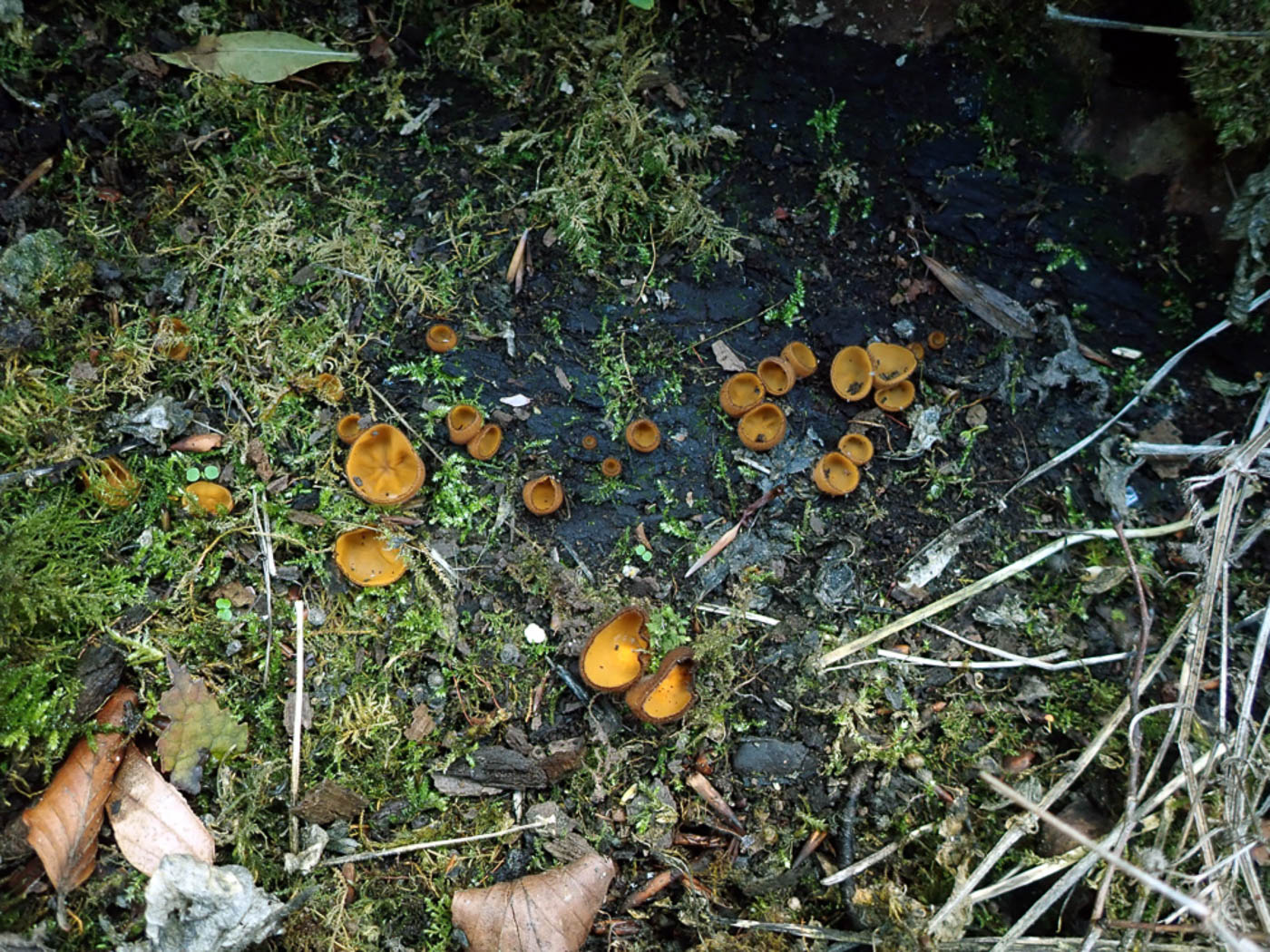  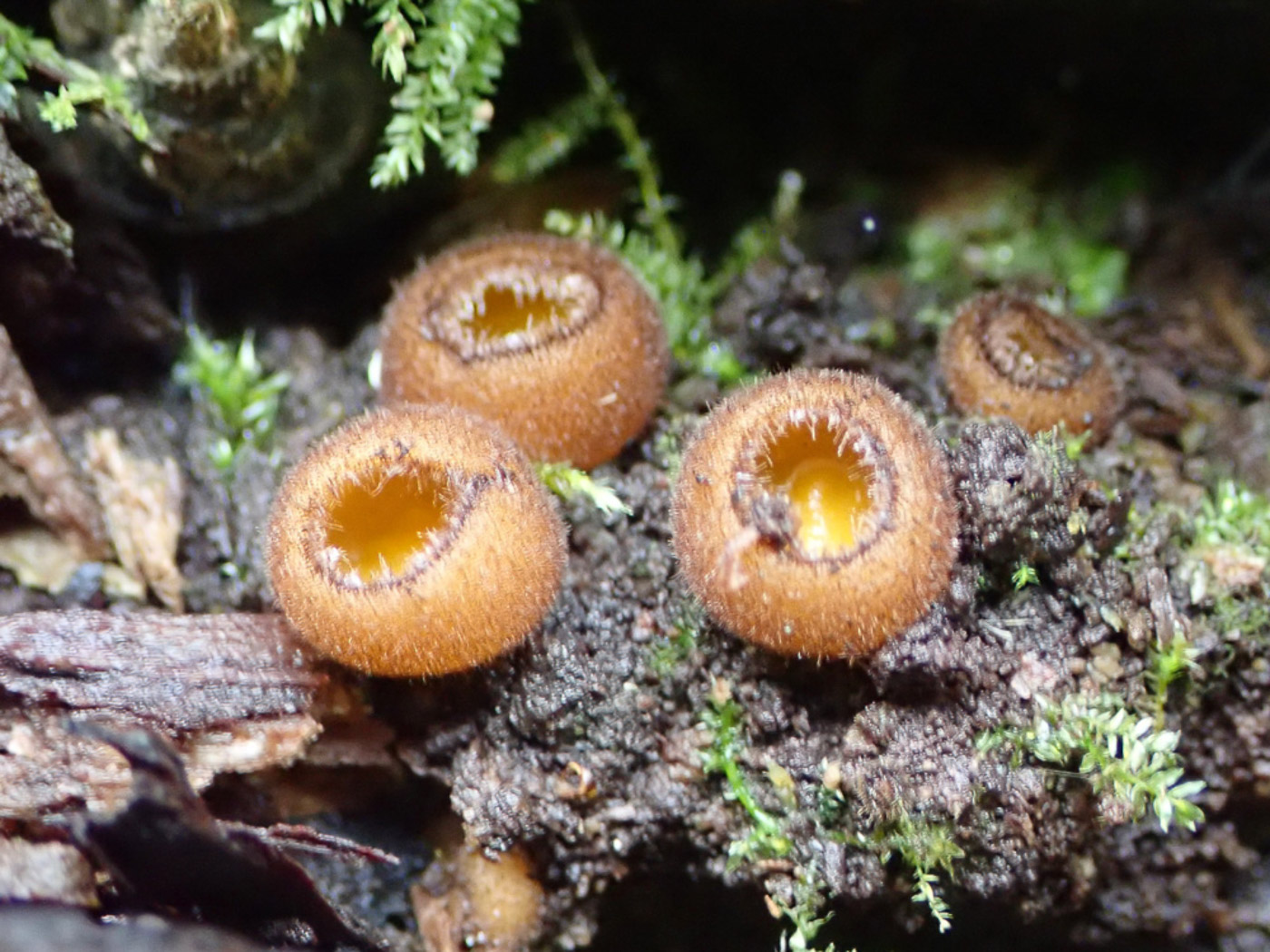 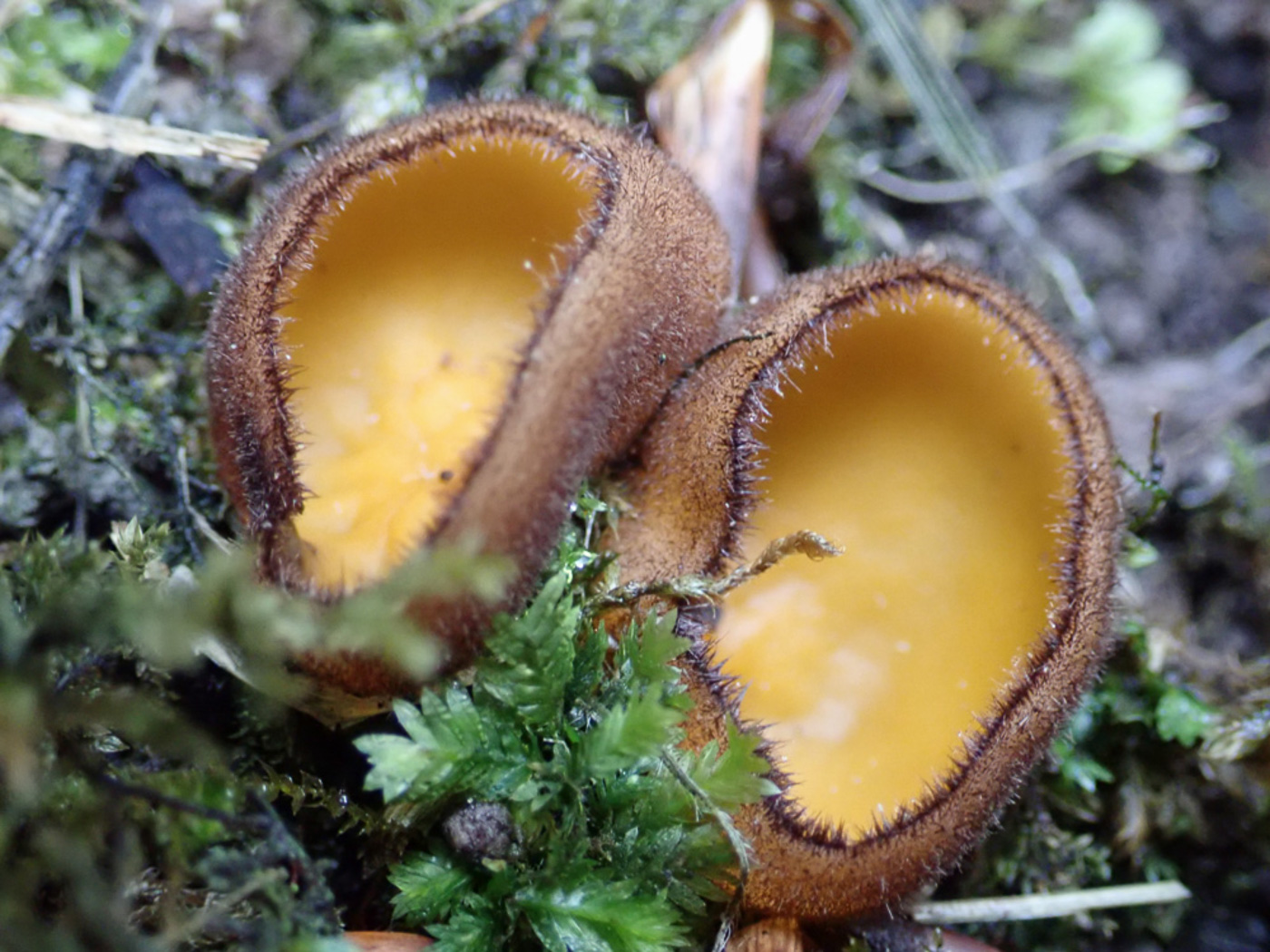
|
Sep 21, 2025. 10 days earlier Mick Jones had alerted me to the fact that this rare and beautiful cup fungus, new to the UK when we found it here in 2022) was up and fruiting again (photos 1 and 2). So a small group of us, keen to see it again, enjoyed this stunning species today – together with some other interesting species. It was on an old rotting Cherry trunk on the same bank where we'd first found it and in quite good numbers too. What is so remarkable is that this distinctive species - hardly mistakable for anything else - should still apparently have gone unnoticed anywhere else in the UK. It is not one of your tiny little ascos and when fully open is around 2-3 cms across, also it seems to fruit quite plentifully and the substrate is not unusual. |
   |
Oct 12, 2022.   On a wooded bank at Dancersend Sarah Ebdon noticed these unfamiliar orange cups which were growing on both soil and woody debris in good numbers. Closer inspection revealed they were coated in fine dark hairs, and to Derek and Penny they were somewhat reminiscent of the genus Humaria though both known British species of that genus are pale beige. At home later both Sarah and Derek independently located a likely candidate in a reference book, compared notes and Derek was able to confirm that this must be our species, so far known in southern and eastern Europe but rare. This was an exciting find and, having now been confirmed with sequencing and examined by asco expert Paul Cannon, this collection is the first for the UK. Photo 1 is Barry Webb's; photos 2 and 3 are Claire Williams's On a wooded bank at Dancersend Sarah Ebdon noticed these unfamiliar orange cups which were growing on both soil and woody debris in good numbers. Closer inspection revealed they were coated in fine dark hairs, and to Derek and Penny they were somewhat reminiscent of the genus Humaria though both known British species of that genus are pale beige. At home later both Sarah and Derek independently located a likely candidate in a reference book, compared notes and Derek was able to confirm that this must be our species, so far known in southern and eastern Europe but rare. This was an exciting find and, having now been confirmed with sequencing and examined by asco expert Paul Cannon, this collection is the first for the UK. Photo 1 is Barry Webb's; photos 2 and 3 are Claire Williams's
|
| Hyaloperonospora dentariae (a downy mildew with no English name) |
    |
Apr 24, 2021.  In Layters Green Wood near Chalfont St Peter Jesper Launder found this rare species, not often recorded because the plant it occurs on is also quite rare in the UK but favours mature dry Beech woodlands where it may be locally abundant as it was here. The host plant is Cardomine bulbifera (Coral Root Bittercress) and the fungus occurs in Spring. (More familiar to many and closely related is the plant Cardomine pratensis (Cuckoo Flower / Lady's Smock - much more common and found in damp meadows, often near streams.) Jesper took photos of the plant as well as the mildew, so both the plant and the fungus are worth looking out for now in local Chiltern woodlands. We have just one previous county record from Hodgemoor Woods where it was found by the mildew expert Elizabeth Mordew 20 years ago on the BMS Spring Foray in May. The final photo is of another find from near Little Marlow made 10 days later by Russell Ness, taken at x 100 magnification and showing the beautiful crystals. In Layters Green Wood near Chalfont St Peter Jesper Launder found this rare species, not often recorded because the plant it occurs on is also quite rare in the UK but favours mature dry Beech woodlands where it may be locally abundant as it was here. The host plant is Cardomine bulbifera (Coral Root Bittercress) and the fungus occurs in Spring. (More familiar to many and closely related is the plant Cardomine pratensis (Cuckoo Flower / Lady's Smock - much more common and found in damp meadows, often near streams.) Jesper took photos of the plant as well as the mildew, so both the plant and the fungus are worth looking out for now in local Chiltern woodlands. We have just one previous county record from Hodgemoor Woods where it was found by the mildew expert Elizabeth Mordew 20 years ago on the BMS Spring Foray in May. The final photo is of another find from near Little Marlow made 10 days later by Russell Ness, taken at x 100 magnification and showing the beautiful crystals.
|
| Hyaloscypha aureliella (an Ascomycete with no English name) |
 |
May 5, 2021.  In the Mire at Burnham Beeches Russell Ness turned over a piece of soggy Pine and noticed these tiny cups. Identified in the field (and confirmed later with a scope) by expert Kerry Robinson, the cups are not dissimilar to the very common Lachnum virgineum, often having droplets between the very fine hairs around the rim (seen in Claudi Soler's photo), but they are smaller (less than 4mm across), lack the hairy stem of the Lachnum and occur only on bare rotting Pine as here. Though not considered rare this was a new species to the site. In the Mire at Burnham Beeches Russell Ness turned over a piece of soggy Pine and noticed these tiny cups. Identified in the field (and confirmed later with a scope) by expert Kerry Robinson, the cups are not dissimilar to the very common Lachnum virgineum, often having droplets between the very fine hairs around the rim (seen in Claudi Soler's photo), but they are smaller (less than 4mm across), lack the hairy stem of the Lachnum and occur only on bare rotting Pine as here. Though not considered rare this was a new species to the site.
|
| Hydnangium carneum (Pink False Truffle) |

|
Nov 30, 2025.  In Gerrards Cross Jesper Launder went to look for truffles under a particular Eucalyptus tree which has been rewarding in previous years. He found not only quantities of Laccaria fraterna but reports there must have been around 50 of these unusual truffles which are host specific with Eucalyptus. Having cleared away the fallen leaves etc he could see good numbers erupting through the soil and with a small amount of digging down an inch or so there were obviously plenty more. What an amazing crop! Originally described from Australia, this species has now spread worldwide and occurs wherever Eucalyptus occurs. False Truffles are so named because they are not ascomycetes (the true Truffles) but basidiomycetes - one of many examples of convergent evolution in the fungal kingdom. In Gerrards Cross Jesper Launder went to look for truffles under a particular Eucalyptus tree which has been rewarding in previous years. He found not only quantities of Laccaria fraterna but reports there must have been around 50 of these unusual truffles which are host specific with Eucalyptus. Having cleared away the fallen leaves etc he could see good numbers erupting through the soil and with a small amount of digging down an inch or so there were obviously plenty more. What an amazing crop! Originally described from Australia, this species has now spread worldwide and occurs wherever Eucalyptus occurs. False Truffles are so named because they are not ascomycetes (the true Truffles) but basidiomycetes - one of many examples of convergent evolution in the fungal kingdom. |
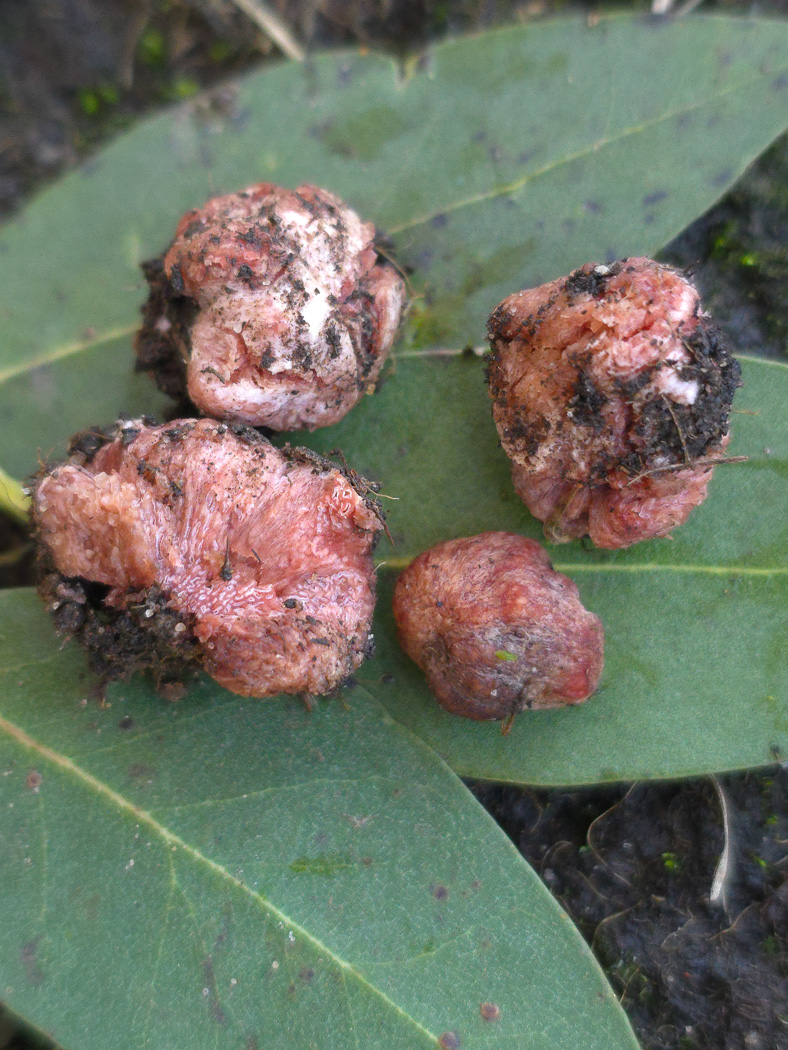 |
Jan 2, 2025.  In a roadside verge in Gerrards Cross Jesper Launder's attention was drawn to a Eucalyptus tree where he'd previous found interesting fungi, and on then discovering Laccaria fraterna (see entry below) he searched about for signs of truffle activity - ie dig holes, because he knew of a rare species which associates with this tree, one he'd been hoping to find for years. To his amazement and delight he spotted a single pinkish truffle protruding through the soil and on further investigation was rewarded with several more. At home a scope confirmed it was likely to be this species but he feels it is well worth getting a sample sequenced because he knows there are several other Hydnangium species found under this tree in Australia which are not yet known to be British. This is a new to the county with just 27 previous UK records. What an exciting find to start the new year off! In a roadside verge in Gerrards Cross Jesper Launder's attention was drawn to a Eucalyptus tree where he'd previous found interesting fungi, and on then discovering Laccaria fraterna (see entry below) he searched about for signs of truffle activity - ie dig holes, because he knew of a rare species which associates with this tree, one he'd been hoping to find for years. To his amazement and delight he spotted a single pinkish truffle protruding through the soil and on further investigation was rewarded with several more. At home a scope confirmed it was likely to be this species but he feels it is well worth getting a sample sequenced because he knows there are several other Hydnangium species found under this tree in Australia which are not yet known to be British. This is a new to the county with just 27 previous UK records. What an exciting find to start the new year off! |
| Hydnellum cf concrescens (Zoned Tooth) |
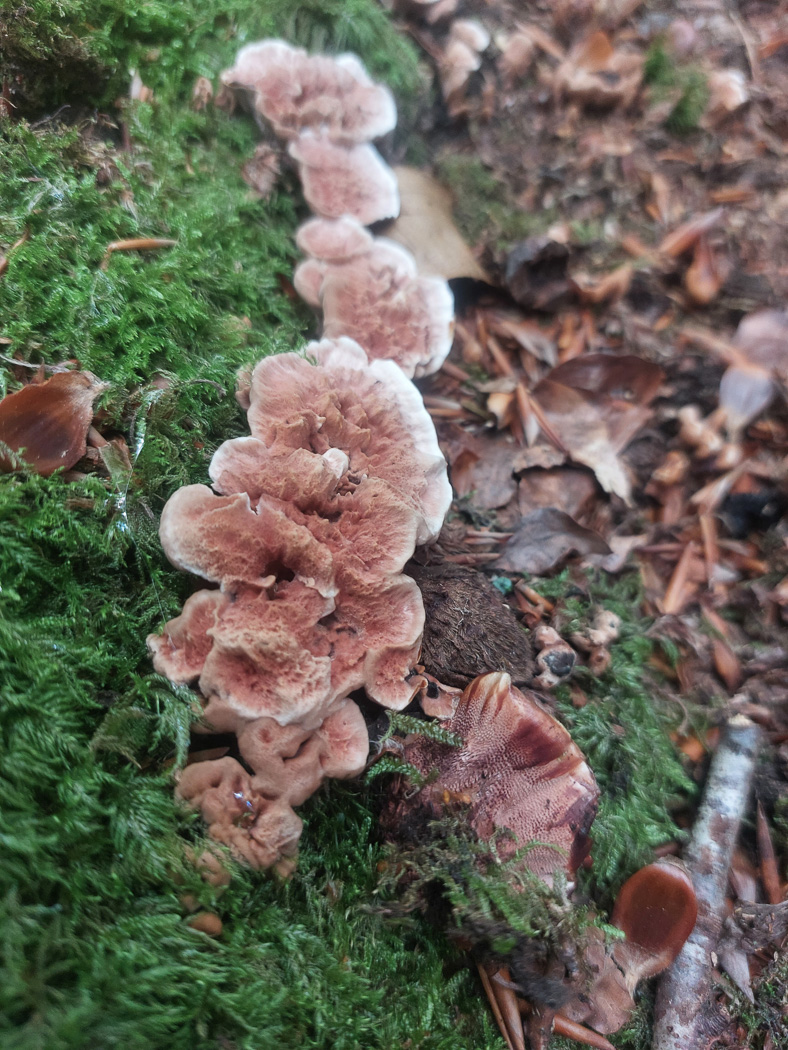 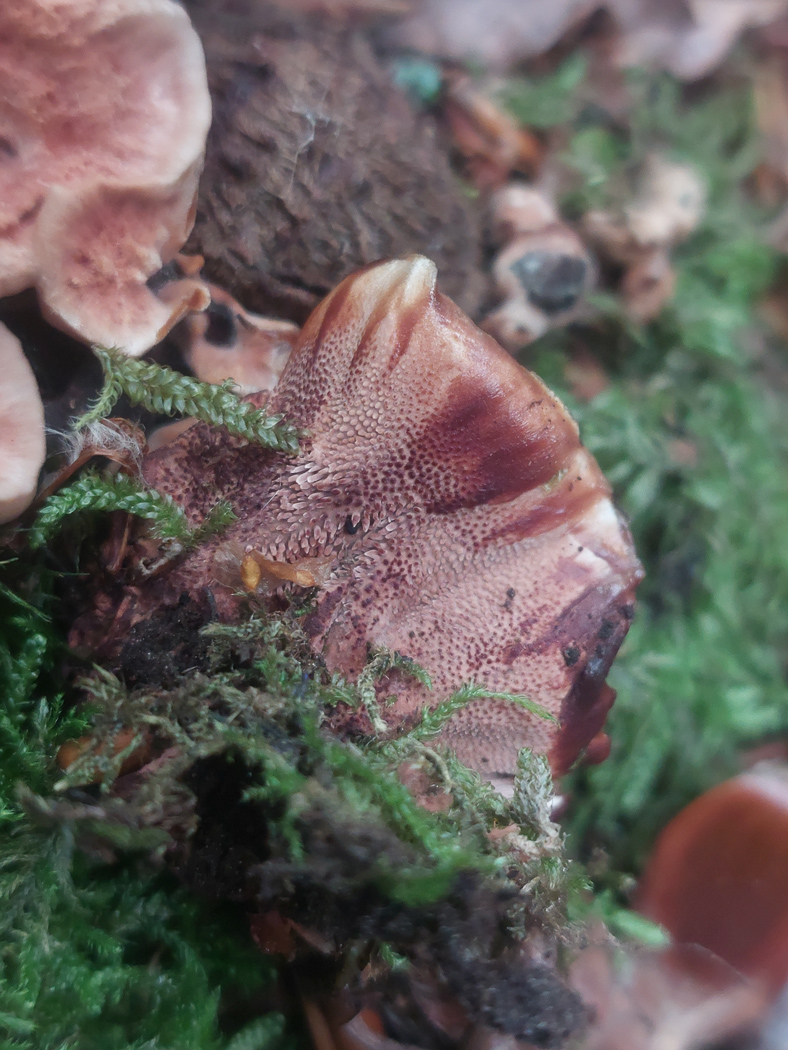
|
Oct 11, 2025. On visiting Pullingshill Wood Jesper Launder had been asked to check a particular spot under Beech where this rare Hydnoid (fungus having spines, not gills or pores) is known to fruit. Though there was no sign of it there a week or so earlier, today it was showing nicely. The two Hydnoid genera Hydnellum and Phellodon are considered rarities and are always special to find, being indicator species of genuine ancient forest. If found, they and their habitat should be left undisturbed as much as possible. |
   |
Oct 10, 2023.  In a bank on the edge of Pullingshill Wood under Beech Noel Murray noticed this small patch of fungus which was new to him. On receiving photo 1 Penny at first thought it was Abortiporus biennis (Blushing Rosette) - a species regularly mistaken for one of the rare Hydnoid (toothed) fungi and which can often have red droplets, one of which is visible here. Geoffrey Kibby also glanced at this photo and concurred. However, when Penny visited the site the following day she found this same clump (photos 2 and 3) and was convinced it was indeed a rare Hydnoid species after all! A sporeprint overnight revealed the correct tiny nobbly spores which fitted the rare Hydnellum concrescens though this is known to be a difficult species complex still not fully understood - hence the 'cf' here - and the material when dried will go to RBG Kew for further analysis. Checking our records Penny found we have just a few from Burnham Beeches and also one from nearby Marlow Common in 2017. This is our first Hydnellum for Finds. In a bank on the edge of Pullingshill Wood under Beech Noel Murray noticed this small patch of fungus which was new to him. On receiving photo 1 Penny at first thought it was Abortiporus biennis (Blushing Rosette) - a species regularly mistaken for one of the rare Hydnoid (toothed) fungi and which can often have red droplets, one of which is visible here. Geoffrey Kibby also glanced at this photo and concurred. However, when Penny visited the site the following day she found this same clump (photos 2 and 3) and was convinced it was indeed a rare Hydnoid species after all! A sporeprint overnight revealed the correct tiny nobbly spores which fitted the rare Hydnellum concrescens though this is known to be a difficult species complex still not fully understood - hence the 'cf' here - and the material when dried will go to RBG Kew for further analysis. Checking our records Penny found we have just a few from Burnham Beeches and also one from nearby Marlow Common in 2017. This is our first Hydnellum for Finds.
|
| Hydnocystis bombycina (Pungent Truffle) |
 |
Jun 7, 2024. ( In Beaconsfield Jesper Launder was delighted with this find - a species he's long been on the lookout for. Under Lime and Oak he found the remains of three tiny truffles in an animal's 'dig hole', and though expecting to discover they were Tuber rufum - a species he quite often finds when truffle-hunting - a scope revealed they were the rarely recorded H. bombycystis (previously in genus Stephensia) with only 12 records in FRDBI, the most recent being from 2008 in Worcs. No, they weren't in the greatest nick as can be seen but there was sufficient material to allow a firm ID to be made. This was indeed an exciting find. In Beaconsfield Jesper Launder was delighted with this find - a species he's long been on the lookout for. Under Lime and Oak he found the remains of three tiny truffles in an animal's 'dig hole', and though expecting to discover they were Tuber rufum - a species he quite often finds when truffle-hunting - a scope revealed they were the rarely recorded H. bombycystis (previously in genus Stephensia) with only 12 records in FRDBI, the most recent being from 2008 in Worcs. No, they weren't in the greatest nick as can be seen but there was sufficient material to allow a firm ID to be made. This was indeed an exciting find.
|
Hydnotrya tulasnei (Red Fold Truffle)  |
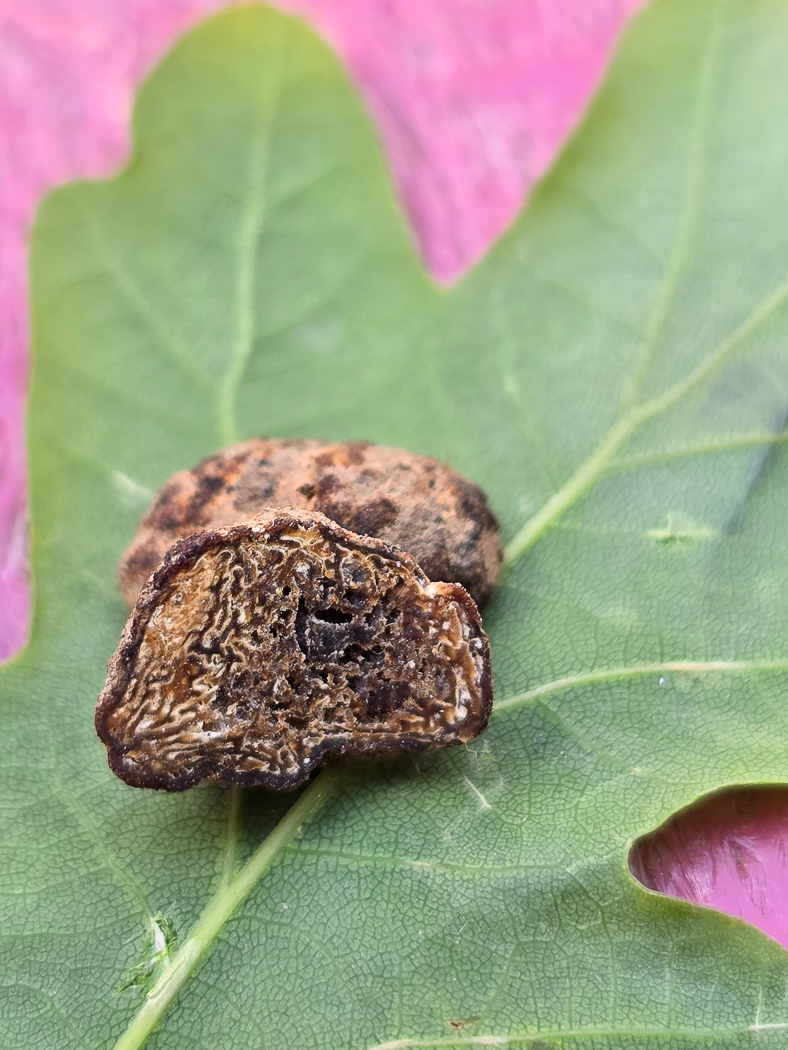
|
Mar 18, 2025. Jesper Launder paid a visit to one of his favourite truffle spots, under an Oak in Little Chalfont, and was rewarded with a rare species he found here new to the county last June. (See the notes on that entry for more about its rarity.) The genus name apparently stems from the Greek for truffle: Hydnon - though Penny doesn't follow the link from this stem to those hydnoid basidiomycetes which are above ground with spines rather than gills?! This is one of the 'true' truffles, ie ascomycetes (the 'false' truffles being basidiomycetes) and is separated microscopically from the other three species in the genus by its virtually round spores housed within an ascus which can be either conventionally shaped - like a sausage - or irregularly sacate - rounder. Luckily, as today's specimen failed to yield useful microscopic detail, Jesper was from experience able to identify it securely from its macro-characters. It can apparently occur under a range of different trees, both deciduous and conifer.
|
 |
Jun 19, 2024. Jesper Launder visited his new-found truffle site in Little Chalfont and was rewarded yet again. Under a massive Oak he noted that three different truffle species he'd already recorded here were still fruiting, but a fourth was new and an exciting find for him - only the third time he'd found it. H. tulasnei is rare and is one of four species within this ascomycete genus, new to Bucks and with under 50 FRDBI records - none since 2016, the previous 5 all from Scotland with the last English record back in 2008. Jesper reports that he's now found 5 different truffle species under this tree in the space of a few weeks - remarkable.
|
Hydnum repandum (Wood Hedgehog) |
 |
Aug 23, 2023. In Mousells Wood under Beech Penny and Geoffrey Kibby found two different species of Hedgehog (see also the entry below) and knowing of the fairly recent additions to the species within this genus it was necessary to check the spores to confirm which we'd found. Gone are the days when pale Hedgehog species can be named H. repandum and darker more orange collections H. rufescens - the sequencing era frequently makes our life more complicated rather than easier! In both collections today, however, the spores matched the two common and familiar species. (The photo is Penny's.) |
  |
Oct 12, 2020. We have this species already on our list but just a singleton (dated Sept 06), so this nice collection is worth including again, found in Beech litter in Gussetts Wood by Paul Cullington. The caps were a good size, about 10 cms across, and though quite clearly darker than our previous specimen, still not dark or orange enough for the very similar H. rufescens. |
.jpg) |
Sep 6, 2020. This was found by Margaret Bolton at Moorend Common growing in deciduous litter. Turning this species over once collected and seeing its 'teeth' underneath instead of gills or pores always brings a smile. |
| Hydnum rufescens (Terracotta Hedgehog) |
  |
Aug 23, 2023.  This was the second Hedgehog collection made by Penny and Geoffrey Kibby at Mousells Wood, and though less common than the paler H. repandum, this was fruiting much more prolifically here today. (See the entry above for further comments.) It always brings a smile when you turn over the first one of these mushrooms and find not gills or pores but tiny sharp spines underneath, giving away the genus instantly. This was the second Hedgehog collection made by Penny and Geoffrey Kibby at Mousells Wood, and though less common than the paler H. repandum, this was fruiting much more prolifically here today. (See the entry above for further comments.) It always brings a smile when you turn over the first one of these mushrooms and find not gills or pores but tiny sharp spines underneath, giving away the genus instantly. |
  |
Sep 27, 2020.  This rather emaciated collection was growing in vegetation in Mousells Wood, found by Penny Cullington. Almost as common as the paler capped Wood Hedgehog (compare with photo dated Sept 06), from above this might be mistaken for a number of gilled fungi, but turning one over reveals all. Note that not just the cap is a darker colour than H. repandum but also the characteristic spines below (see second photo). There are other much rarer similarly coloured Hydnum species recently described which have differently shaped spores. This rather emaciated collection was growing in vegetation in Mousells Wood, found by Penny Cullington. Almost as common as the paler capped Wood Hedgehog (compare with photo dated Sept 06), from above this might be mistaken for a number of gilled fungi, but turning one over reveals all. Note that not just the cap is a darker colour than H. repandum but also the characteristic spines below (see second photo). There are other much rarer similarly coloured Hydnum species recently described which have differently shaped spores. |
| Hydropisphaera peziza (Yellow Spot) |
 |
Sep 10, 2022.  On our BFG Walk at Ivinghoe Common a large colony of tiny bright pale orange cushions was found on a fallen Beech trunk by Barry Webb. Penny collected some to attempt an ID and got as far as the genus Nectria (as in the common Coral Spot) but was then defeated so sent a dried sample to expert Kerry Robinson. Previously in Nectria, the species is not particularly rare but appears to be new to the county, and Kerry commented that when received the dried 'cushions' had collapsed and were looking more disc-like - a characteristic of the species, hence its species name. The photo is Neil Fletcher's. On our BFG Walk at Ivinghoe Common a large colony of tiny bright pale orange cushions was found on a fallen Beech trunk by Barry Webb. Penny collected some to attempt an ID and got as far as the genus Nectria (as in the common Coral Spot) but was then defeated so sent a dried sample to expert Kerry Robinson. Previously in Nectria, the species is not particularly rare but appears to be new to the county, and Kerry commented that when received the dried 'cushions' had collapsed and were looking more disc-like - a characteristic of the species, hence its species name. The photo is Neil Fletcher's.
|
| Hydropodia (previously Hydropus) subalpina (Chipolata Bonnet) |
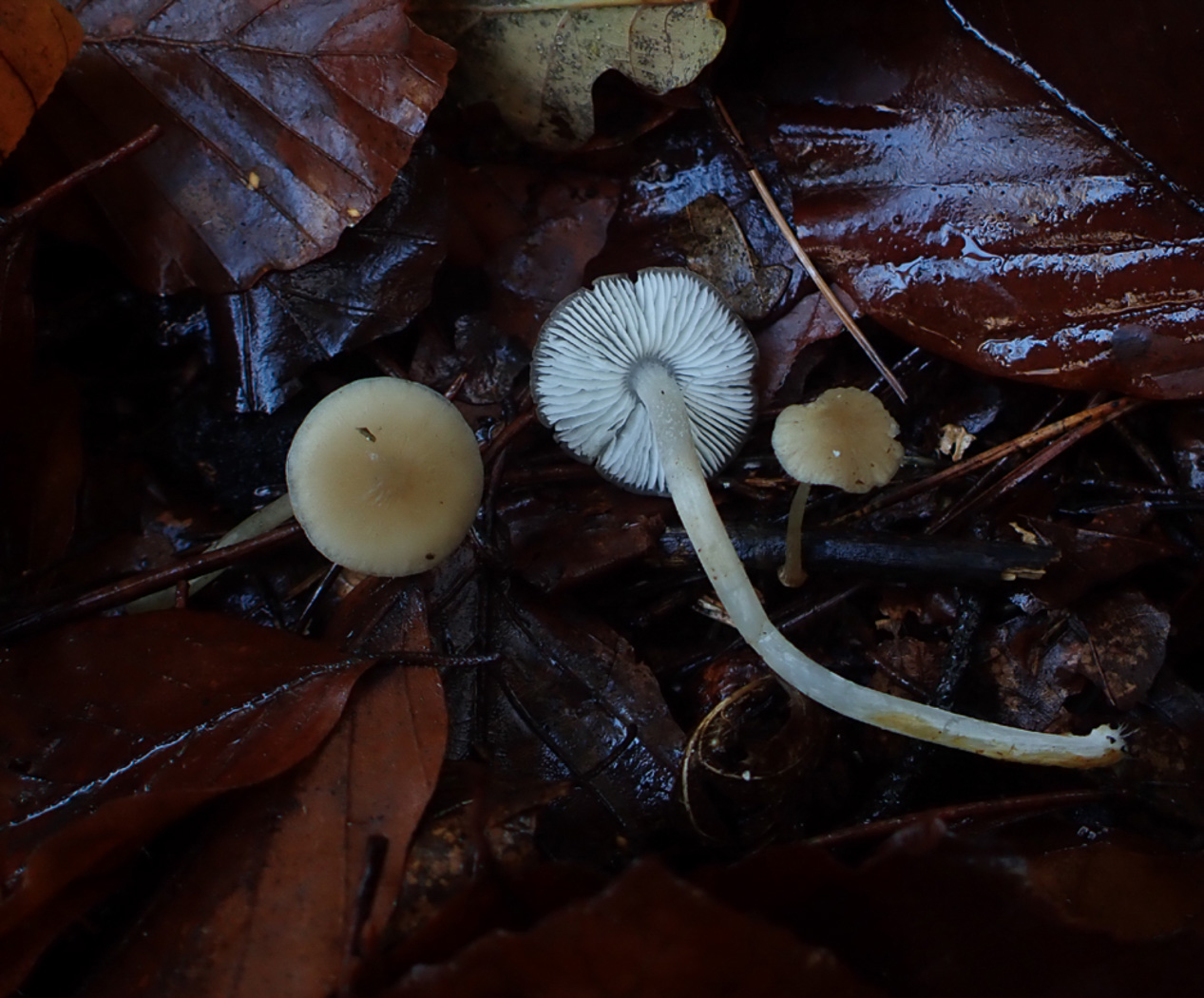

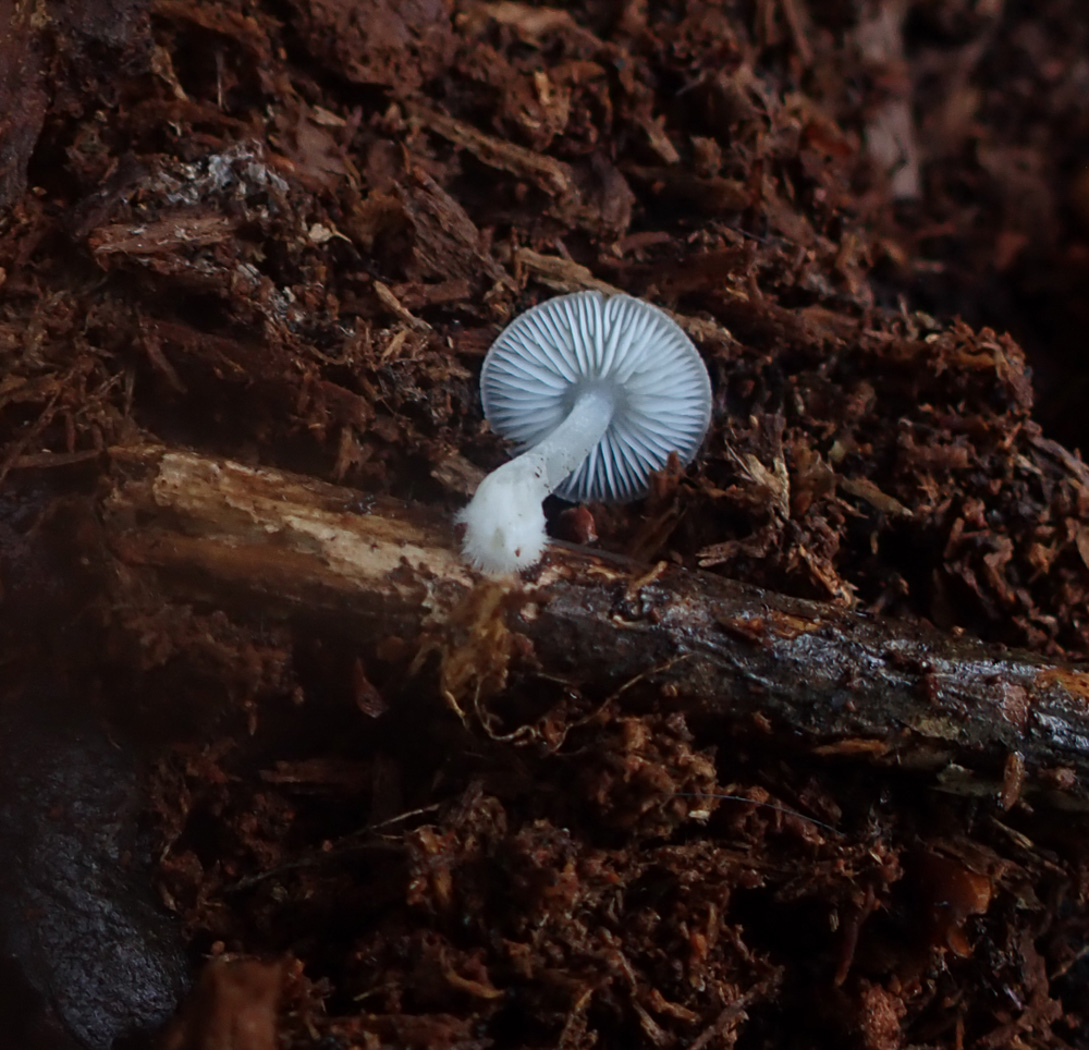
|
Dec 3, 2025.  At Burnham Beeches Penny noticed first one then three more of these small Mycenoid mushrooms in woody litter, a mix of Pine and deciduous, and at first glance thought they might be Clitocybe fragrans singletons - often a late fruiter. However, the gills appeared to be almost free and investigation showed them to be growing on wood, so was this perhaps a small Pluteus? At home the light dawned that they might just be a species which seemed relatively common last autumn but had been completely absent from our species list this year. She nicked a stem with a razor blade noticing the instant plentiful watery fluid, then a microscope revealed the huge swollen cystidia and very distinctive allantoid (sausage-shaped) spores. Bingo! Here at last was the elusive Hydropodia subalpina, the English name describing the unusual spore shape - pretty well unique amongst mushrooms though more often occurring amongst both ascomycetes and corticioids. The species was until last year in genus Hydropus. Though we have images of this species in last year's walk reports it appears to be a new entry for Finds. At Burnham Beeches Penny noticed first one then three more of these small Mycenoid mushrooms in woody litter, a mix of Pine and deciduous, and at first glance thought they might be Clitocybe fragrans singletons - often a late fruiter. However, the gills appeared to be almost free and investigation showed them to be growing on wood, so was this perhaps a small Pluteus? At home the light dawned that they might just be a species which seemed relatively common last autumn but had been completely absent from our species list this year. She nicked a stem with a razor blade noticing the instant plentiful watery fluid, then a microscope revealed the huge swollen cystidia and very distinctive allantoid (sausage-shaped) spores. Bingo! Here at last was the elusive Hydropodia subalpina, the English name describing the unusual spore shape - pretty well unique amongst mushrooms though more often occurring amongst both ascomycetes and corticioids. The species was until last year in genus Hydropus. Though we have images of this species in last year's walk reports it appears to be a new entry for Finds. |
Hydropus inopinatus (a species NEW TO SCIENCE from Burnham Beeches - no English name)   |
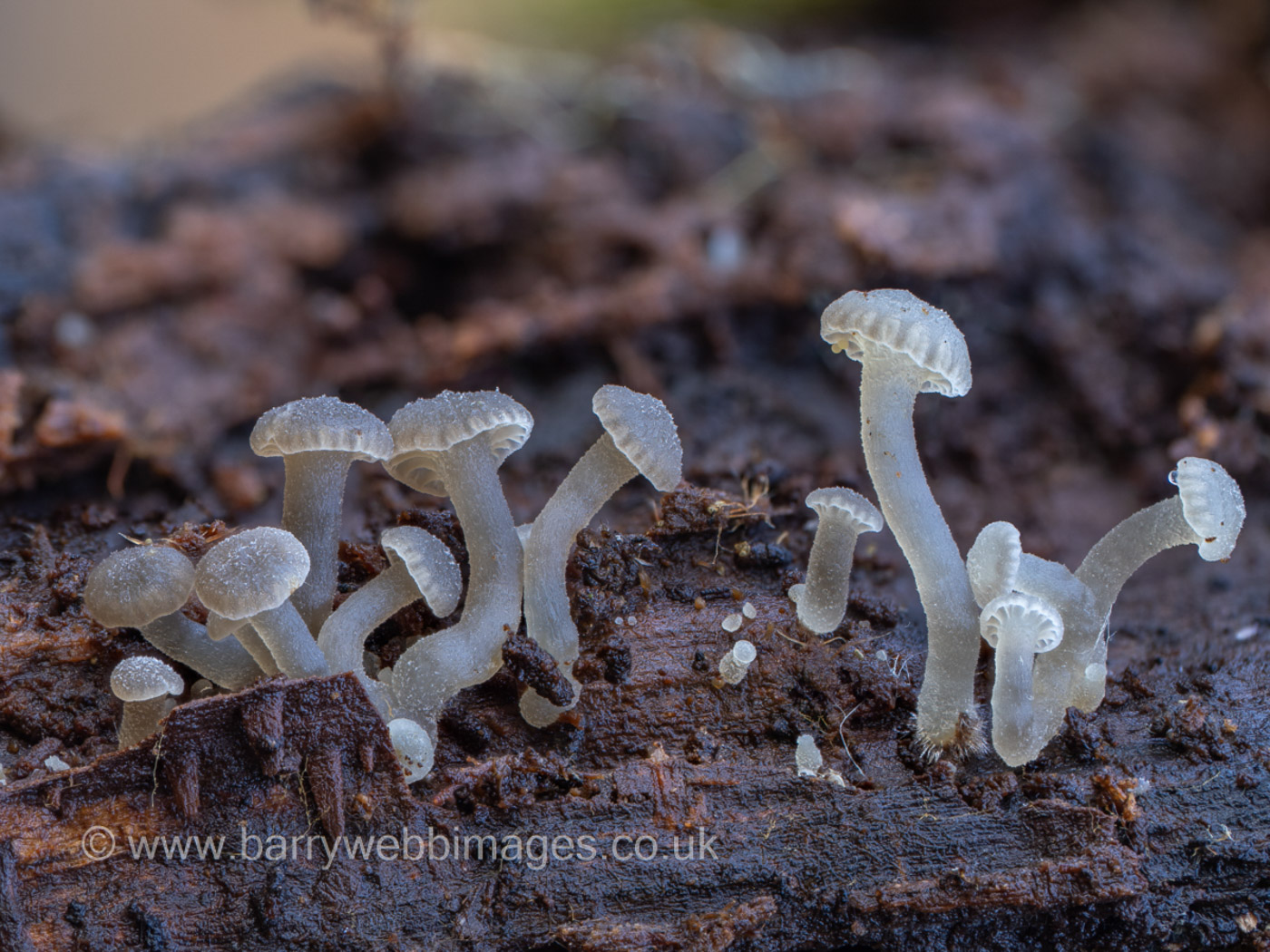
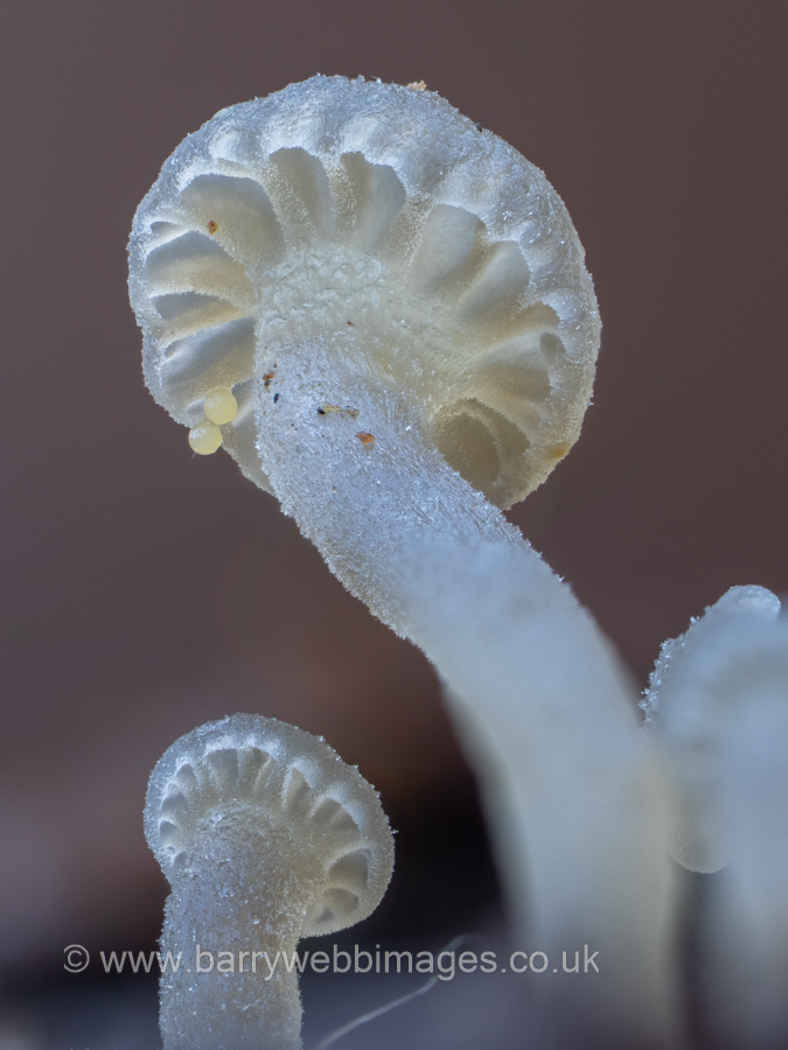
|
Dec 20, 2025. At Burnham Beeches whilst in an area with Pine Barry Webb came across these tiny but familiar mushrooms which were growing clustered on rotten mossy fallen wood - back in 2021 (see previous Finds entries for more on this) and has taken virtually all existing photos of it since then, so when spotting it again today he recognised it despite the fact that he was in a different location at Burnham Beeches and it was not at the base of a rotting Pine stump as previously. Penny agrees that his photos here look spot on though the material is yet to be checked microscopically, and we will also be having a sample sequenced. |

|
Aug 5, 2025 Near a stream in Burnham Beeches only feet away from where Barry Webb first discovered this species, he was pleased to find it fruiting again on a very rotten old Pine stump. This site appears to be the stronghold for this tiny insignificant-looking mushroom which has yet to be reported occurring elsewhere other than the collections mentioned in our original official description in 2024 in the magazine Field Mycology. We found it here last year also on our autumn walk (see my report for more images) so it hasn't missed a year since its first discovery.
|
    |
July 10, 2023. This tiny Mycenoid mushroom was first found in 2021 on a piece of Pine collected from Burnham Beeches by Barry Webb and, following sequencing, described for the first time in the magazine Field Mycology vol 24 (1) earlier this year. Its reappearance has been eagerly awaited in order that sufficient material could be collected for further study and drying, and on July 2nd Barry rediscovered it on the same rotting Pine stump from which his original piece of wood was taken (photo 1). Bingo!! It had also been found in Hampshire back in 2021 and in Kent in 2022, the sequence of both collections matching ours from Burnham Beeches. So a second article has since appeared (in 2024, Field Mycology vol 25 (3)) - the official publication of this species now with a name and full description. The name inopinatus meaning a surprise was thought to be particularly appropriate. All the photos here are Barry's, photo 2 taken on July 5th, photos 1 and 2 are of his original find on a piece of Burnham Beeches Pine on July 31st 2021. See the publication online for further information. |
| Hygrocybe acutoconica (Persistent Waxcap) |
  |
May 7, 2024. On the Grangelands at Pulpit Hill Penny found this singleton waxcap, one better known by its previous name H. persistens. It is often one of the first waxcaps to appear in the year (though this year has been exceptional with several very early fruitings of waxcaps). It is not unlike H. conica (Blackening Waxcap) sharing its yellow colour and conical shape but doesn't blacken. Surprisingly this is a new entry for Finds. (The photos are Jesper Launder's.) |
  |
Sep 28, 2023. At Prestwood Churchyard in short grass this was one of five Waxcap species Penny found here today, this one being the least surprising as it often fruits in Summer or early Autumn. Its common name relates to it previous species name: H. persistens. Quite similar in shape to H. conica (Blackening Waxcap) it is quite big, also strongly conical to start with though later becomes more flattened (as here), never blackens and often has orange colours on the stem and / or cap. The gills are yellow. |
   |
Jul 28, 2023. In Ragpits Reserve Phil Townsend reports good numbers of this early season Waxcap coming up now. Previously H. persistens - hence its common name - this is probably a species complex and is somewhat variable in appearance with colour ranging from greenish lemon yellow through to orange as here; it has a marked umbo especially when young. Unlike H. conica and related species, however, it does not blacken in maturity. |
 |
Aug 15, 2021. In short grass in Prestwood Churchyard Penny found this grassland species (better known by its previous name H. persistens). We've had quite a few Waxcaps fruiting early this year but this one fruits regularly at this time. Quite similar to H. conica in shape and often this lemon yellow, it differs in not blackening as always occurs in that species. |
Hygrocybe calciphila (Limestone Waxcap)  |
 |
May 7, 2024. On the Grangelands at Pulpit Hill Jesper Launder found this little collection of a small but bright waxcap and was hopeful that it would check out to be this unusual species. It is very similar - and in fact closely related - to H. miniata (Vermillion Waxcap) but is restricted to calcareous grassland sites such as this and also has differently shapes spores. Like the species below, it tends to fruit earlier than most other waxcaps though May is still fairly exceptional! We have records from a just few other county sites which have similar chalky conditions. |
  |
Oct 12, 2022. In a grassy very chalky area of Dancersend several small reddish to orange or yellow Waxcaps were found and thought at the time to be H. miniata (Vermillion Waxcap) on account of their scurfy dry cap surface and small size. However, on checking the spores later Derek found them incorrect for that species and recalled a collection back in 1997 from this same spot which he'd taken to a Waxcap workshop tutored by David Boertmann who'd identified it as the very similar H. calciphila. We have a handful of previous county records (including Derek's) though it is new for Finds. The photos are Barry Webb's. |
| Hygrocybe cantharellus (Goblet Waxcap) |
  |
Sep 27, 2023. At Stampwell Farm Jackie Ewan noticed this unusual Waxcap in a grassy area - a species she's found here before though not last year. One of several small red Waxcap species, it is notable for its rough dry cap surface and distinctive decurrent gills - hence its species name. We have only two county records other than this site for it. |
 |
Jul 12, 2021. In a grassy area at Stampwell Farm and near to other Waxcap species Jackie Ewan found a patch of this attractive species, one for which we have only four previous county records though it is not classed as rare. The dry orange cap and strongly decurrent gills make the species recognisable in the field so it would be good to find more sites for it. Our list of early fruiting Waxcaps is growing steadily at the moment! |
| Hygrocybe ceracea (Butter Waxcap) |
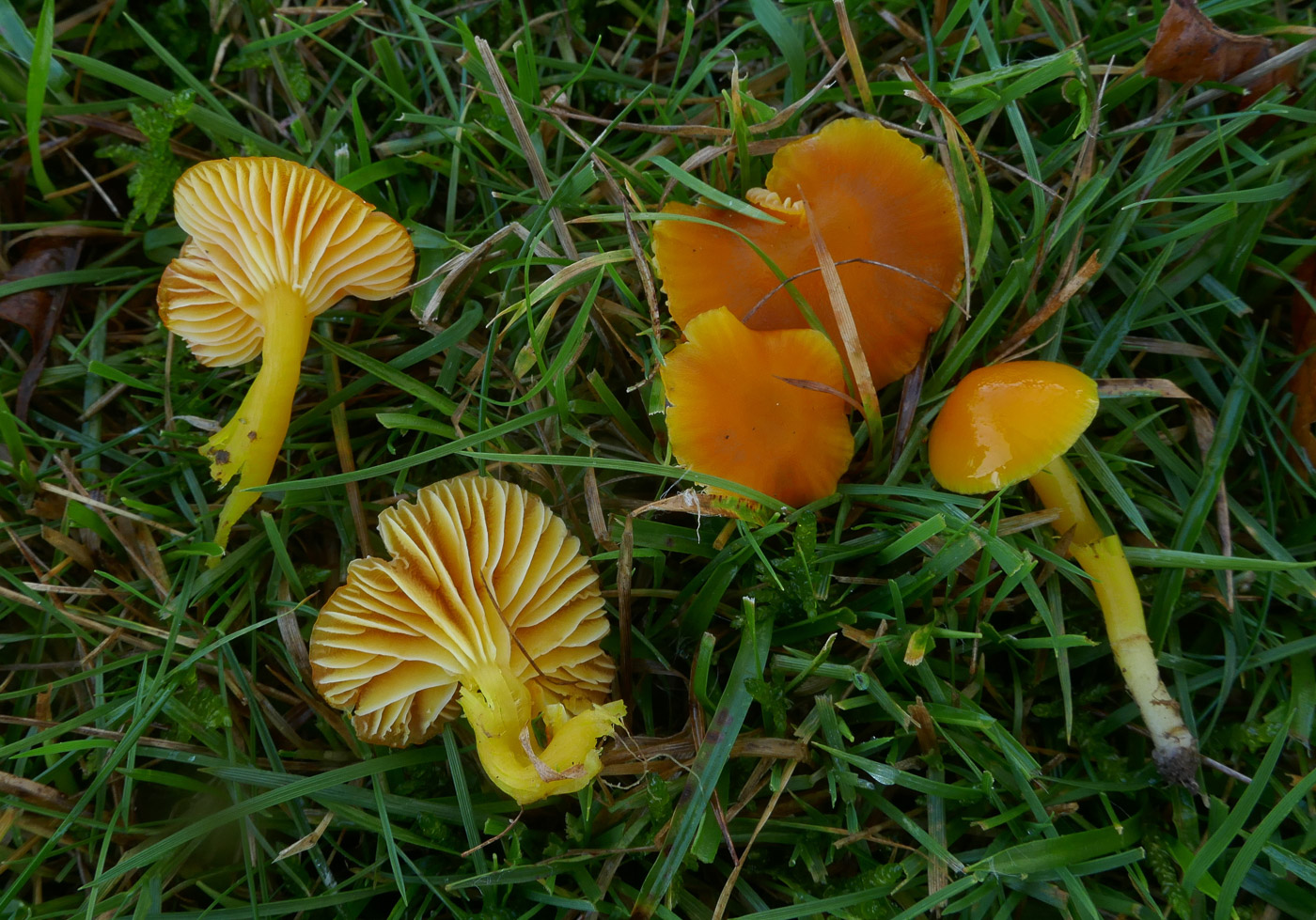 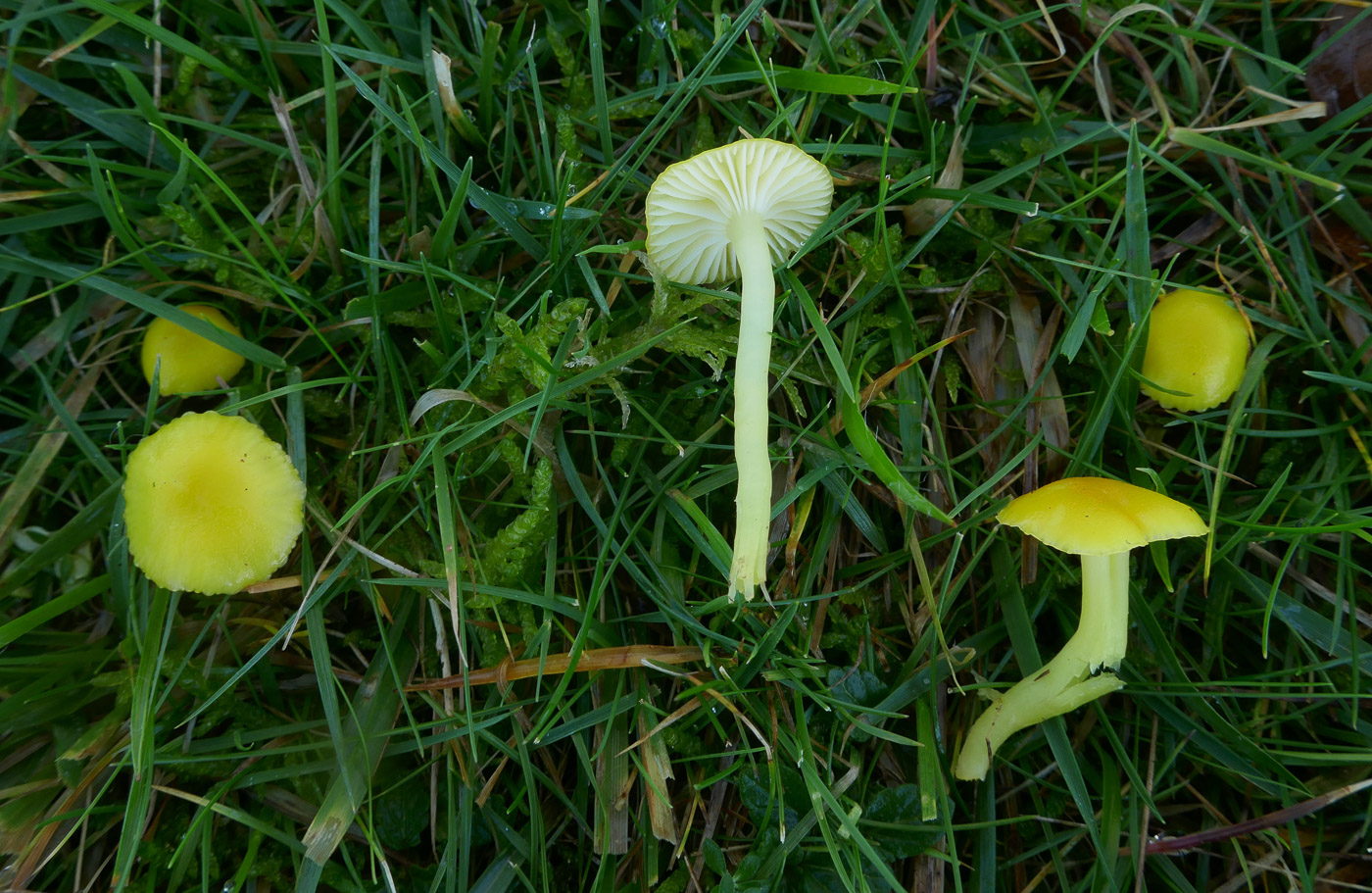 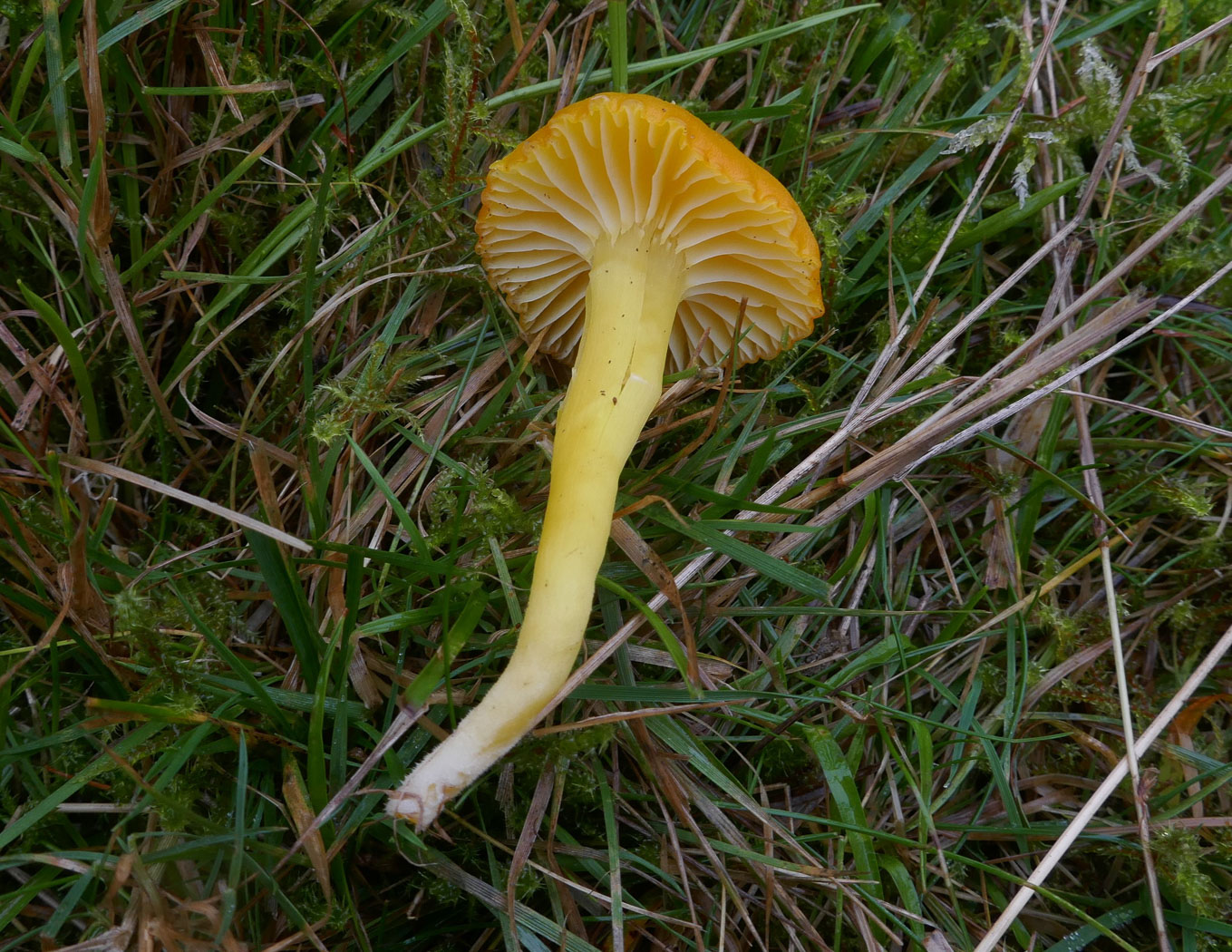 |
Dec 14, 2024.  At Stampwell Farm Jackie Ewan found several examples of this small to medium yellow Waxcap which is a regular at this site. Easily confused with H. chlorophana (Golden Waxcap) which can be very similar in colour though is medium to large, in the field the smaller species has a greasy cap but a dry stem as opposed to both cap and stem feeling greasy. There are also clear microscopic differences which should help to confirm if in doubt. Photos 1 and 2 show a variation in colour tone and photo 3 was taken in the same spot on Boxing Day where it was still fruiting. At Stampwell Farm Jackie Ewan found several examples of this small to medium yellow Waxcap which is a regular at this site. Easily confused with H. chlorophana (Golden Waxcap) which can be very similar in colour though is medium to large, in the field the smaller species has a greasy cap but a dry stem as opposed to both cap and stem feeling greasy. There are also clear microscopic differences which should help to confirm if in doubt. Photos 1 and 2 show a variation in colour tone and photo 3 was taken in the same spot on Boxing Day where it was still fruiting. |
  |
Mar 16, 2024.  Penny was surprised to receive details of this species from Jackie Ewan, found at Stampwell Farm in grassland. Waxcaps occur most often in latish autumn though we also have summertime records, but the earliest we have for this particular species is one doubtful record in August 20 years ago! The similar but larger H. chlorophana was found last year in May (see in Finds) which was also an exceptionally early record. Glancing through the first half of the 2500 odd national records, Penny found just a few for January - presumably late autumn season fruiters - but none from February to July. Penny was surprised to receive details of this species from Jackie Ewan, found at Stampwell Farm in grassland. Waxcaps occur most often in latish autumn though we also have summertime records, but the earliest we have for this particular species is one doubtful record in August 20 years ago! The similar but larger H. chlorophana was found last year in May (see in Finds) which was also an exceptionally early record. Glancing through the first half of the 2500 odd national records, Penny found just a few for January - presumably late autumn season fruiters - but none from February to July. |
 |
Nov 25, 2023.  At Stampwell Farm Jackie Ewan found this yellow Waxcap species amongst several others still fruiting. Quite similar to the much more common H. chlorophana (Golden Waxcap) it is smaller and more delicate, the other species lacking the tendency to show red shades as seen here. At Stampwell Farm Jackie Ewan found this yellow Waxcap species amongst several others still fruiting. Quite similar to the much more common H. chlorophana (Golden Waxcap) it is smaller and more delicate, the other species lacking the tendency to show red shades as seen here. |
 |
Oct 23, 2021.  At Stampwell Farm Jackie Ewan found this nice collection of one of the smaller yellow Waxcaps. It is not always easy to separate from the larger and more common H. chlorophana, especially when still small! Today's species tends to have orange colours mixed in with yellow and has a greasy but not sticky cap and a dry and not sticky stem, but the safest way to split them if in doubt is with a scope. At Stampwell Farm Jackie Ewan found this nice collection of one of the smaller yellow Waxcaps. It is not always easy to separate from the larger and more common H. chlorophana, especially when still small! Today's species tends to have orange colours mixed in with yellow and has a greasy but not sticky cap and a dry and not sticky stem, but the safest way to split them if in doubt is with a scope. |
  |
Nov 1, 2020.  Another Waxcap Penny C. found on the Penn Street Cricket Pitch was this one - just these three tiny specimens! Like a smaller version of H. chlorophana (see photos dated Oct 03 and 28) and very possibly often misidentified as that species, caps get no larger than 3 cms across (H. chlorophana can be up to 7 cms across), gills are quite crowded and often decurrent as seen here and stems are seldom grooved as in H. chlorophana. Both species have sticky bright yellow caps but H. ceracea has a dry stem and in the larger species stems are often greasy though not really sticky. There are further microscopic differences to confirm which of these two you have. Another Waxcap Penny C. found on the Penn Street Cricket Pitch was this one - just these three tiny specimens! Like a smaller version of H. chlorophana (see photos dated Oct 03 and 28) and very possibly often misidentified as that species, caps get no larger than 3 cms across (H. chlorophana can be up to 7 cms across), gills are quite crowded and often decurrent as seen here and stems are seldom grooved as in H. chlorophana. Both species have sticky bright yellow caps but H. ceracea has a dry stem and in the larger species stems are often greasy though not really sticky. There are further microscopic differences to confirm which of these two you have. |
| Hygrocybe chlorophana (Golden Waxcap) |
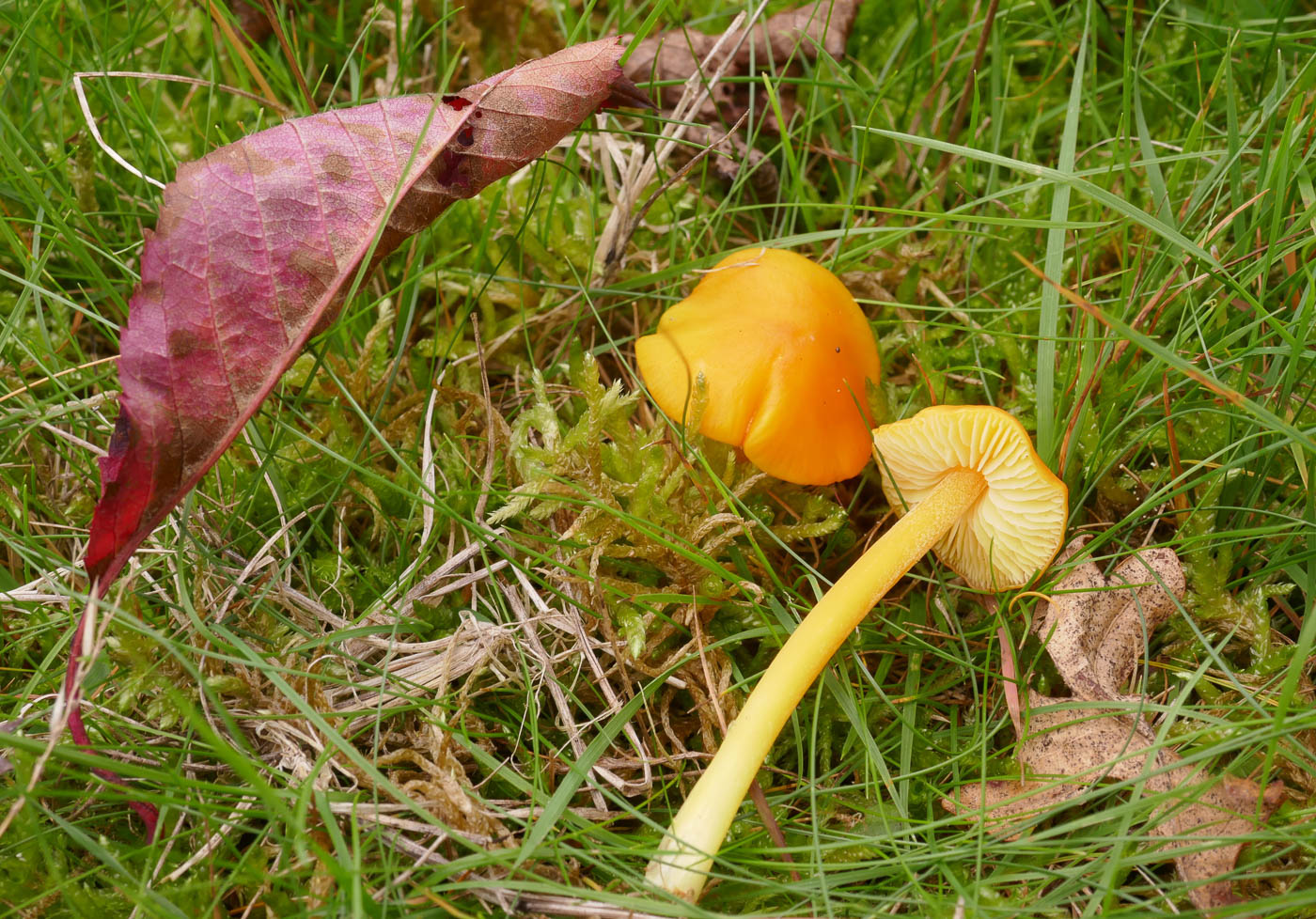
|
Oct 10, 2025.  At Stampwell Farm Jackie Ewan noticed that waxcaps are now beginning to make an appearance though in a new area here where she's not seen them before. This common species was not as sticky as she was expecting due to the dry conditions, but the spores confirmed her iD. At Stampwell Farm Jackie Ewan noticed that waxcaps are now beginning to make an appearance though in a new area here where she's not seen them before. This common species was not as sticky as she was expecting due to the dry conditions, but the spores confirmed her iD. |
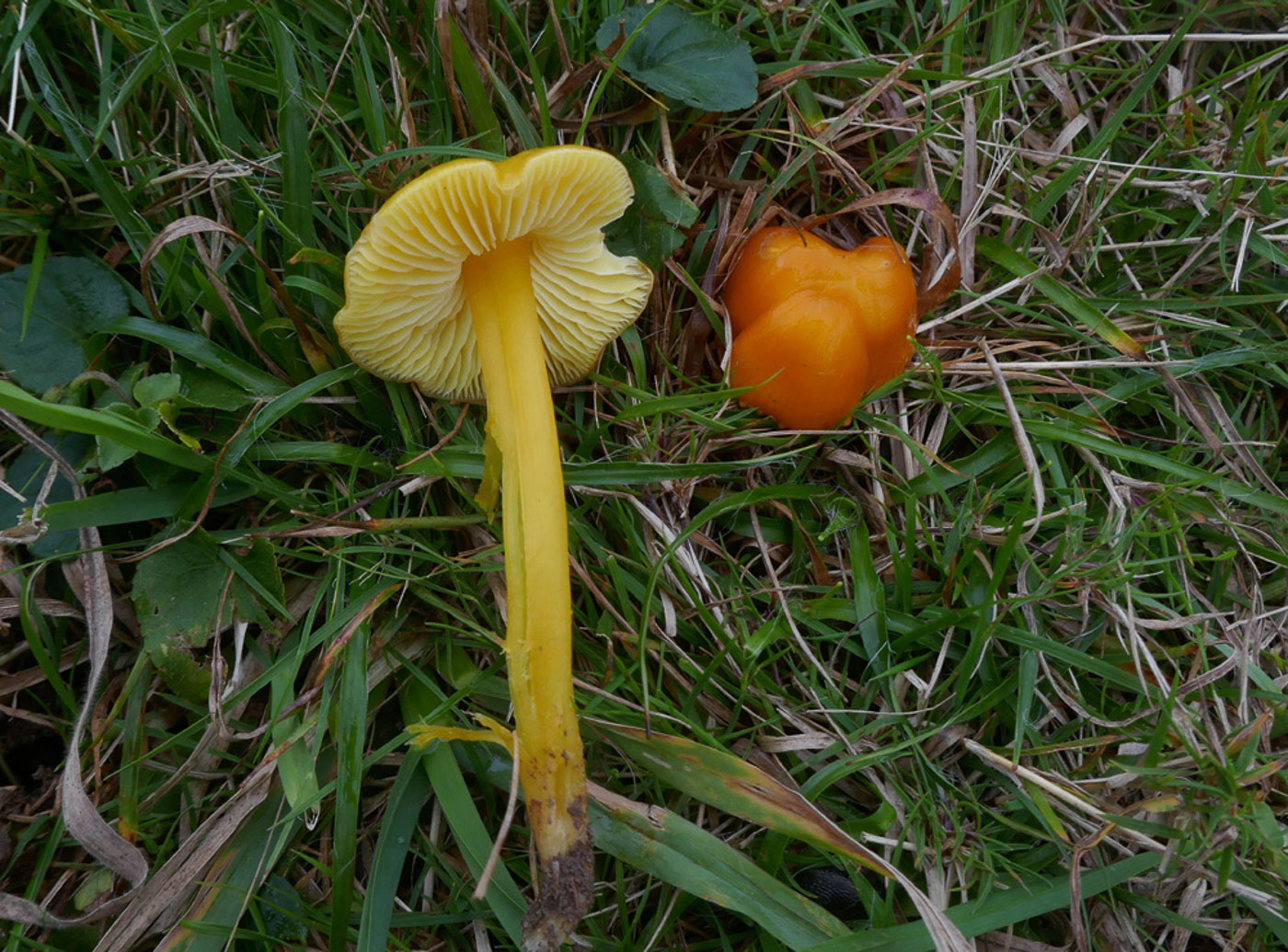 |
Sep 25, 2024. At Stampwell Farm Jackie Ewan found this bright mushroom in a grassy area - one she knows well from this site and often finds. When small it can be tricky to distinguish from other yellow waxcaps but when full size it is bigger than the other lookalikes. If in doubt a scope is needed to check the length of the gill trama - much longer in this species than many others. |
 |
Apr 26, 2024. In the lawns at Stoke Poges Memorial Gardens Jesper launder found first one, then several more, of these stunning beauties. Penny, he and Sarah were not at all sure which of the yellow / orange species it might be; the depth of colour here made us wonder about H. quieta but it entirely lacked any typical oily smell, so we were left with the possibilities of H. chlorophana or ceracea though the general 'jizz' didn't seem quite right for either. However, at home Penny found the amazingly long gill trama (strands of hyphae) which typifies H. chlorophana and the spores size and shape matched also. This is the second spring appearance of the species within a month - amazing! (The photo is Sarah's.) |
   |
Mar 30, 2024. From the grassland at Stampwell Farm comes yet another unseasonal Waxcap, found by Jackie Ewan. She at first suspected it was H. quieta (Oily Waxcap) on account of its rather orange colour and oily smell, but the microscopic characters matched H. chlorophana - which is also by far the commoner of the two species - so we have to assumed it must be that despite the uncharacteristic smell. |
   |
Oct 14, 2023. Jackie Ewan reports that the Waxcaps are massing at Stampwell Farm! This particular species is one of our commonest and gets to a good size though when smaller is not always easy to separate from other yellow capped species. It has a sticky cap, gills are not decurrent and the stem is also greasy to sticky and often grooved as seen in photo 3. |
 |
May 9, 2023. Richard Donnelly was amazed to find this Waxcap on his lawn in Bourne End today which he correctly identified. This is a common late Autumn species, one for which we have many county records on our database - virtually all of them from October and November. Penny found two records of hers from May, however, from Penn St Cricket Pitch in 2003 so today's find was not quite unique! |
  |
Dec 6, 2022. In the lawns at Stoke Poges Memorial Gardens Penny and Claire Williams found quite a few specimens of this species showing quite nicely. This was one of only 5 Waxcap species today which was somewhat disappointing compared to other years here. (The photos are Claire's.) |
  |
Oct 28, 2020. We have a previous photo of this species dated October 03 but Paul and Penny C. were spoilt for choice today on the lawns at Stoke Poges Memorial Gardens so took the opportunity to show both young and mature collections. See previous notes for more but note the typical grooved stem and gill which are paler than the cap especially when mature. |
 |
Oct 3, 2020.  This collection was in mown grass in the Penn Street churchyard, found by Penny Cullington. Waxcaps are predominantly grassland fungi, many are brightly coloured and this common species is one of quite a few which are yellow and sticky - especially after rain as today. Note the gills which are slightly paler than the cap and the typical grooved and hollow stem, both good pointers for the species. This is a medium to large Waxcap with caps up to 7 cm across and has no noticeable smell. This collection was in mown grass in the Penn Street churchyard, found by Penny Cullington. Waxcaps are predominantly grassland fungi, many are brightly coloured and this common species is one of quite a few which are yellow and sticky - especially after rain as today. Note the gills which are slightly paler than the cap and the typical grooved and hollow stem, both good pointers for the species. This is a medium to large Waxcap with caps up to 7 cm across and has no noticeable smell. |
Hygrocybe citrinovirens (Citrine Waxcap)  |
 |
Oct 7, 2024. At Prestwood Churchyard Penny was delighted to see this unusual waxcap which she saw here last year but prior to that had not seen since 2005 - both here and at Stowe Landscape Gardens, our only two sites for it. The conical shape together with distinctly greenish yellow colour - very different from other yellow waxcaps - were enough to confirm it, furthermore it was in the identical spot to last year! |
  |
Sep 28, 2023. In grass at Prestwood Churchyard Penny spotted these beauties and quickly realised that despite their conical shape, large size and yellow colour they had too green a tint to be one of the commoner larger yellow species. At home she checked the microscopic details which fitted well with this rare Waxcap, then checking in the BFG database found just three previous county records - two from Stowe Landscape Gardens (where we visit later this autumn) and one from this site back in 2005 also found by Penny! This is a new entry for Finds. |
| Hygrocybe coccinea (Scarlet Waxcap) |
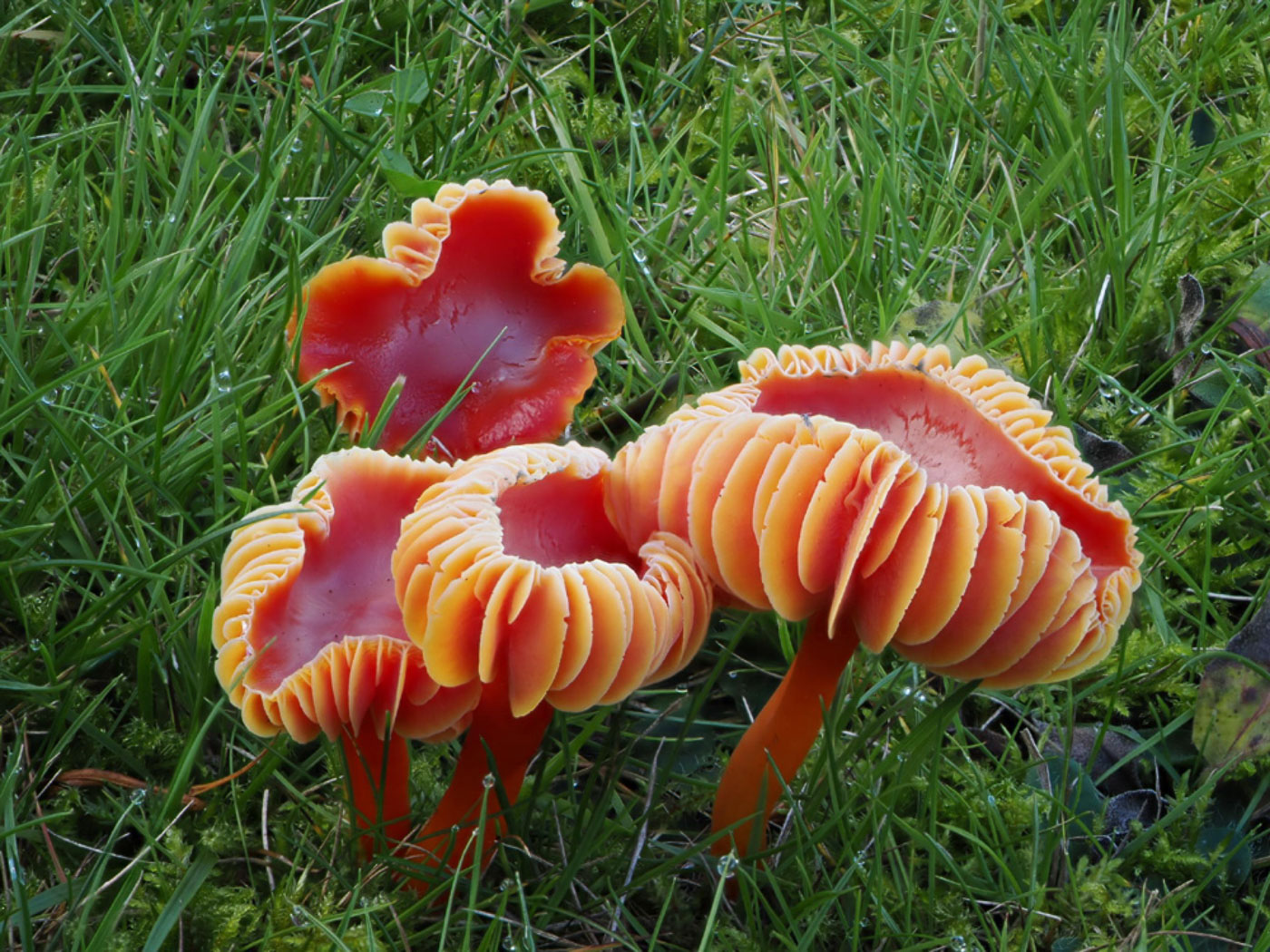
|
Nov 8, 2025. In Prestwood Churchyard Claire Williams went to check how the waxcaps and other grassland species were faring as they seemed to be in short supply elsewhere. Here she found just a few nice examples this species which is often very common and abundant. |

|
Nov 6, 2025. In St Giles Churchyard, adjacent to Stoke Poges Memorial Gardens, this beautiful singleton was the sole example of one of the mere five waxcap species we struggled to find here today (and that was three more than in the Gardens next door). Claire Williams's photo captured it perfectly. |
 |
Dec 12, 2023. Inspired by Sarah's recent visit to Prestwood Churchyard Penny went to St Giles Churchyard, Stoke Poges to see what grassland fungi were still fruiting now the weather has turned milder again. Disappointingly no Earthtongues were found and the only Waxcaps on show were Cuphophyllus virgineus and this nice collection of H. coccinea which she couldn't help setting up for a photo despite it not being at all unusual, though it doesn't seem to have been nearly as common as usual this autumn. |
 |
Nov 1, 2023. Churchyard Penny saw her first examples of this common Waxcap just emerging in a grassy bank where they usually grow at this time. It is one of our commonest Waxcaps and has one of the brightest red caps too - always a joy to find. |
 |
Dec 6, 2022. In the lawns at Stoke Poges Memorial Gardens Penny and Claire Williams found just a few examples of this normally very common Waxcap which seems to have been quite scarce this autumn. (The photo is Claire's.) See the Masterlist for further examples.
|
 |
Nov 4, 2022. At Stampwell Farm Jackie Ewan found the first fruiting of this common Waxcap alongside a grassy path. This is our first report of it this year though we have three images for 2020 and two for 2021 in Finds. |
 |
Dec 30, 2021. In Bradenham Churchyard Penny found just a couple of this species till fruiting though it is certainly late to be finding it. It's not often one can take a photo of a Waxcap and a Primrose together! |
 |
Oct 30, 2021. In Prestwood Churchyard Penny found a nice clump of this brightly coloured common Waxcap though this was the first time she'd seen it this year. There are several quite similar species but this one is usually easy to spot and normally one of our commonest: small to medium in stature, cap greasy but not sticky and evenly bright red (not orange), gills red or sometimes yellowish, stem dry and red - sometimes orange towards base, no smell. |
  |
Nov 19, 2020. Whilst walking on Brill Common Joanna Dodsworth found these very large and stunning Waxcaps. The caps were up to 6.5 cms across and stems were chunky and described by Joanna as somewhat twisted and compressed, concolorous with the vivid red caps though yellowish at the base. She was hopeful that this might be the rare Hygrocybe splendidissima, a species rather like an overgrown H. coccinea which as it dries develops a smell of honey similar to H. reidii. We sent a sample for sequencing because if confirmed it would have been new to the county. Sadly, however, its sequence matched that of the common H. coccinea (Jan 2021) despite its impressive size. See also collections dated Nov 1st and 12th for more 'normal' sized specimens. |
 |
Nov 1, 2020. This common and stunningly intense red Waxcap is usually in good numbers on the Penn Street Cricket Pitch at this time but today Penny C. struggled to find it, eventually coming across just a couple of clusters in the longer grass. Caps can get to 5 cms across and are greasy but not sticky, likewise the stem. Gills can be red of yellow as here and are quite widely spaced. This is another species lacking a distinctive smell. |
| Hygrocybe coccineocrenata (Bog Waxcap) |
    |
Jul 21, 2022. In the Mire at Burnham Beeches amongst thick Sphagnum Andy McVeigh noticed this singleton, the photos of which were taken by Helen Read and sent to Penny asking if it might be anything interesting. On Penny's reply to the affirmative they returned and found a second fruitbody, and the collection was then conveyed by Barry and Gill Webb to Penny and Derek at the BFG microscope workshop the next day. The specimens were dead ringers for the image in Boertman's Hygrocybe book, the habitat being spot on too, the species having been seen over 20 years ago by Penny and Derek in Scotland. This is a nice find, new to the county and with extremely few records south of Scotland. Photos 3 and 4 are Derek's, taken once we'd realised its identity and showing the characteristic decurrent gills and scurfy cap surface.
|
| Hygrocybe conica (Blackening Waxcap) |
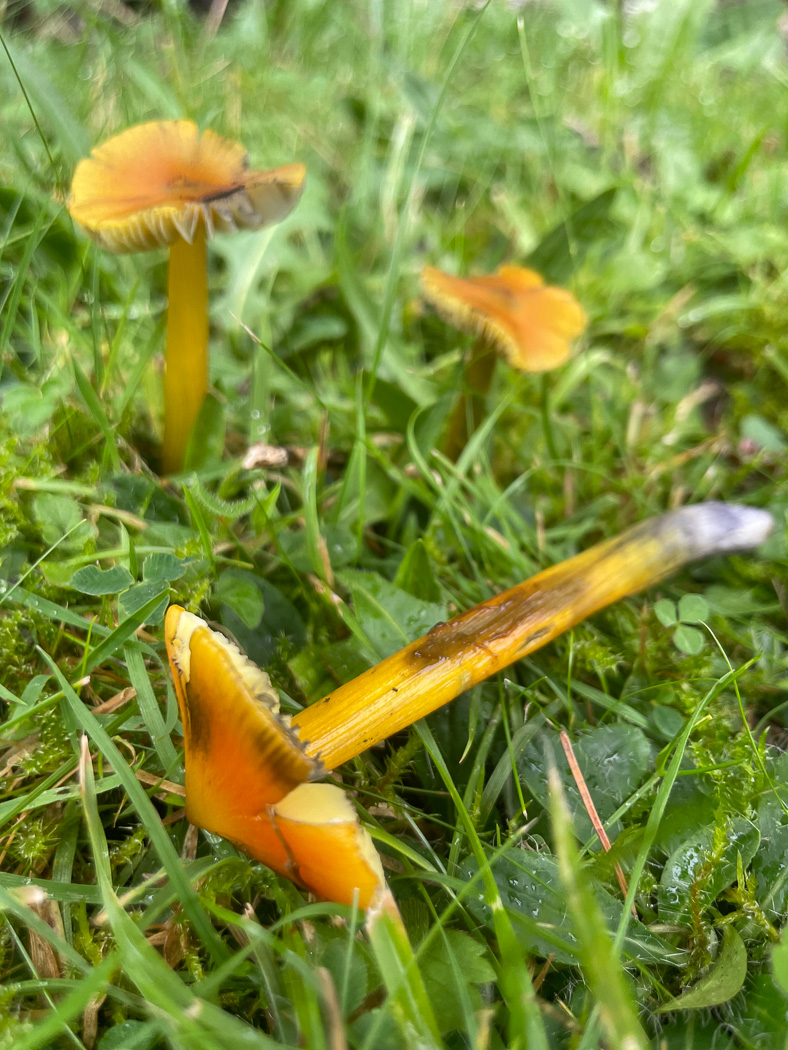 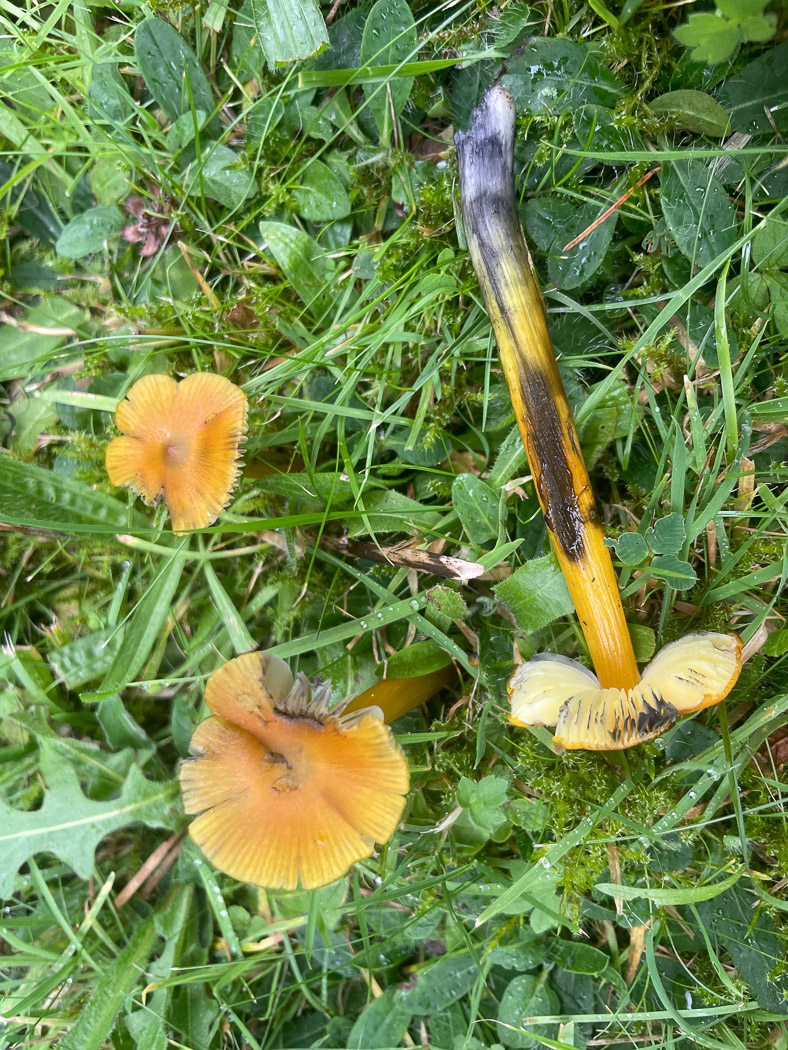 |
Sep 23, 2024. In Prestwood churchyard Sarah Ebdon found several waxcaps which she thought were probably H. conica though the typical blackening was hardly apparent. However, after scratching the stem and waiting 30 minutes (photo 2) it became obvious that her first thoughts were correct. This is quite a variable species, known to be a complex, so no doubt will in time be further split up. |
 |
Aug 7, 2023. At Stampwell Farm Jackie Ewan found this common species - one of the easiest Waxcaps to recognise once it starts to blacken. Though the cap colour is variable between red / orange / yellow, its combination of strongly conical shape, with both cap and stem viscid together with the blackening, should present no problems in ID - unless you're in dunes when there are other similar contenders! |
  |
Dec 3, 2022. At Ragpits Reserve Penny found quite a few of this common species, including some well past their sell-by date but at least showing just how black the species can become! Diagnostic features are the slightly streaky (acutely) conical cap varying between red, orange or yellow, and the longish stem often yellowish but soon blackening especially when handled. |
 |
Jul 9, 2021. In a grassy area at Stampwell Farm Jackie Ewan found this species, the first example of which was found on July 8th - yet another case of a particular species showing up in one place and promptly appearing elsewhere. This is obviously no coincidence and happens time and time again - something which has come to light since we introduced our series of Members' Finds. |
  |
Jul 8, 2021. In Rushbeds Wood Joanna Dodsworth was surprised to find this very early fruiting singleton just emerging in a grassy ride - it was only 3cms tall but even at this stage is showing signs of the telltale blackening typical of the species. Glancing through our many records, most are were made in October or November but we do have a smattering from earlier months including one on July 1st, so although it's an unusual find at this time it's not unheard of and presumably reflects the unseasonal weather we've been experiencing recently. As regularly happens, this same species was found by Jackie Ewan at Stampwell Farm the following day (photo 2). |
  |
Sep 9, 2020. This eye-catching species was found fruiting on the lawn in a private garden in Tylers Green by Sarah Ebdon - yet another early showing of a species which usually fruits mid to late season. So it's worth looking at lawns and grassland for other waxcaps which may well be following suit at the moment. |
 |
Oct 16, 2020. Paul Cullington found this collection in longish grass at Burnham Beeches (photo Penny C.). We have this species already (dated Sept 09) but today's collection shows the typical conical shape and colours of the species with the blackening just beginning on the damaged stems. It's worth noting that the gills, white here, can be yellow or even red in some collections. |
| Hygrocybe flavipes (Yellow Foot Waxcap) |
  |
Sep 24, 2020. This rare Waxcap was found by Tony Marshall in unimproved grass in a churchyard near Gt. Missenden. Churchyards are good places to look for Waxcaps together with other grassland loving genera. We have just one previous county record for this particular species. There are a few greyish capped Waxcaps, all very rare except for H. irrigata (Slimy Waxcap) - easily recognised because the stem is so slimy one can hardly pick it up! No other Waxcap has a yellow base to the stem (as seen in the second photo), note also the decurrent (sloping gills) and dry stem though the cap is sticky.
|
| Hygrocybe glutinipes (Glutinous Waxcap) |
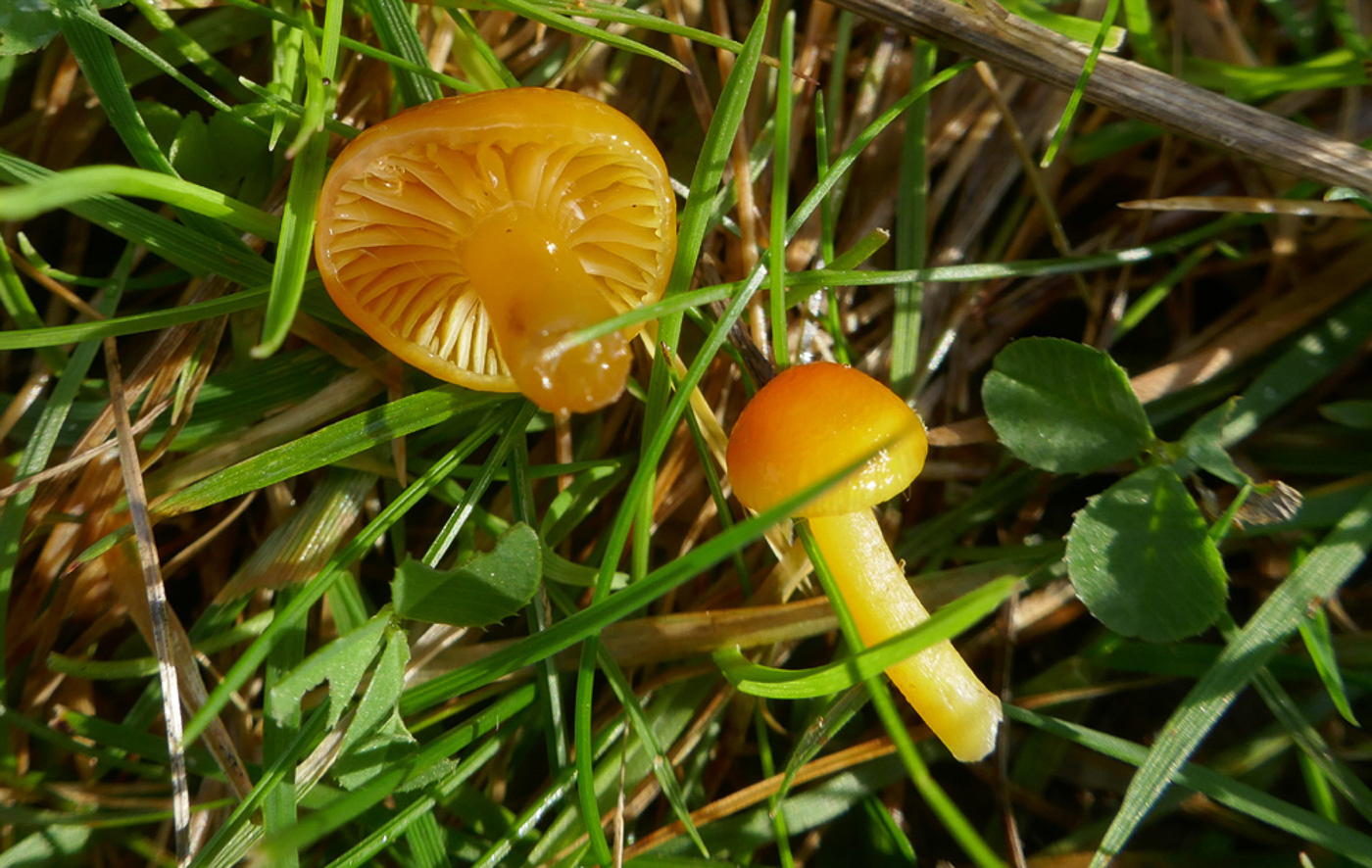 |
Oct 10, 2024. At Stampwell Farm Jackie Ewan found several Waxcaps coming up including this one. Though similar to other small yellow species its somewhat sticky cap and stem - especially after a rain spell - are distinctive. |
 |
Sep 28, 2023. At Prestwood Churchyard in short grass this was the fourth Waxcap species Penny found here today and she knew what species it was as soon as she picked one! There are several small yellow to orange Waxcaps but only this one has a really slimy stem - so much so that it's quite hard to hang on to it! The cap is also sticky and often has a slightly sunken centre as seen here. It is not rare and often turns up in grassy places where different Waxcaps occur, and should present little difficulty to identify especially in damp conditions. See the Masterlist for further examples. |
  |
Jun 9, 2022.  At Stampwell Farm in a grassy weedy spot near where she found this species last July, Jackie Ewan was delighted to discover her first Waxcap of the year - this now proven to be an excellent site for many species of Waxcap. A small species recognisable in the field by its viscid stem as well as cap, it also has quite distinctive spores, though the cap colour can vary from yellow through orange to red. We have around 20 previous records though this is the earliest by several weeks. At Stampwell Farm in a grassy weedy spot near where she found this species last July, Jackie Ewan was delighted to discover her first Waxcap of the year - this now proven to be an excellent site for many species of Waxcap. A small species recognisable in the field by its viscid stem as well as cap, it also has quite distinctive spores, though the cap colour can vary from yellow through orange to red. We have around 20 previous records though this is the earliest by several weeks. |
 |
Jul 12, 2021. In grassland at Stampwell Farm Jackie Ewan found this small Waxcap fruiting somewhat early in the season. It is separated in the field from other very similar species by having not only a very sticky cap but also a very sticky stem. H. inspida could be confused with it but has a stem which is no more than moist when fresh (not really viscid), gills which tend to be decurrent and usually red colours in the stem. |
 |
Nov 3, 2020.  Yet another species for our growing list of Waxcaps, John Catterson found this very slippery collection in Prestwood Churchyard. This is a small orange yellow Waxcap and separated from other yellow species by the whole fruitbody being really slimy making it difficult to pick up as John found today! He also checked the spores which are notably thinner than in other similarly coloured species. Yet another species for our growing list of Waxcaps, John Catterson found this very slippery collection in Prestwood Churchyard. This is a small orange yellow Waxcap and separated from other yellow species by the whole fruitbody being really slimy making it difficult to pick up as John found today! He also checked the spores which are notably thinner than in other similarly coloured species. |
| Hygrocybe insipida (Spangle Waxcap) |
 |
Aug 7, 2023. In a grassy verge in Jordans Jesper Launder found these small Waxcaps just appearing. Somewhat variable in colour, this common species tends to stay less than 2 cm across and both cap and stem are smooth and sticky. Some shade of yellow / orange / red over all, the stem top tends to be red as can be seen here and the gills may or may not be decurrent! |
 |
Oct 11, 2021. At Stampwell Farm Jackie Ewan found this small species of Waxcap in grassland. It is one of the species having a sticky cap and stem and often combined tones of yellow and red, nearly always red at the top of the stem as here. Gills can be more or less decurrent also. |
 |
Nov 1, 2020. Penny C. found this small and pretty Waxcap in Penn Street Churchyard. This quite common species can be recognised by its small cap (often only 1 cm across) but rather long stem in comparison. Gills are usually decurrent and colours are very variable: yellow, orange to red but nearly always with red at the top of the stem which contrasts with the paler yellowish gills. It lacks a distinctive smell. |
| Hygrocybe intermedia (Fibrous Waxcap) |
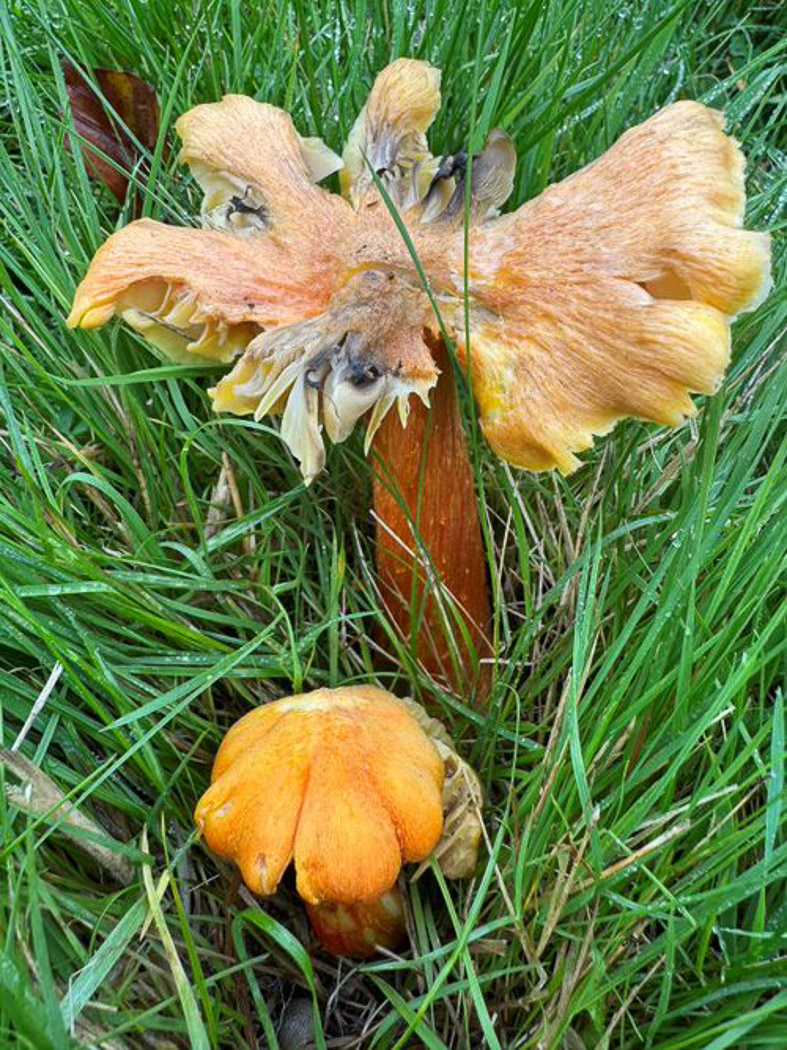 |
Nov 7, 2024. At Stoke Poges Memorial Gardens our large group were particularly pleased to see this species, new to the site and quite a rarity. This is a large chunky dry waxcap with a conical streaky orange / yellow / reddish cap which tends to split and a concolorous thick fibrous stem and was one of 15 waxcaps seen here today, three of which were new to the site. We have only one or two known county sites with very few records but this year would be a good one to look out for it in likely grassy spots, being the best year for waxcaps for quite a time. The photo is Leigh McMahon's |
   |
Oct 17, 2023. The previous day Penny received photo 1 from Phil Townsend to ask if she agreed that this was Hygrocybe intermedia which he'd just seen in Prestwood Churchyard. It did look like it but as the diagnostic fibrous stem was not visible in his photo, she paid a visit there today to try and check it and see what else was about - this is always an interesting site for grassland species. She found what she guessed was the same fruitbody, now past its best and possibly affected by the slight overnight ground frost, but the large fibrous orange cap together with dry fibrous stem was enough to confirm it. Nearby were one or two other examples which further convinced her of its ID (photo 3). She was later surprised to discover that we have no previous county records though she recalls seeing the species in Ashridge many years ago. So this is yet another species to add to the growing list of fungi found at this remarkable little site, also another new entry for Finds. |
| Hygrocybe miniata (Vermilion Waxcap) |
 |
Oct 10, 2024. At Stampwell Farm Jackie Ewan found several Waxcaps coming up including this one. Though similar to other small red species it can be distinguished in the field by its dry cap and stem, the cap surface also finely squamulose with golden flecks clearly seen here. |
  |
Nov 25, 2023. At Stampwell Farm Jackie Ewan found good examples of this species, also having a bright red cap like the entry above, but generally smaller and - in contrast to H. coccinea - critically having a tomentose (roughened) cap surface clearly visible in both photos here. |
 |
Aug 21, 2023. In a grassy area at Burnham Beeches Barry Webb found this little beauty which Penny has named (hopefully correctly) purely from his photo. Small and delicate with a roughened, not sticky, bright red cap surface and adnate rather than decurrent gills (which may or may not be red as well) were the pointers to its ID which is, however, by no means guaranteed. |
 |
Jul 12, 2021. In a grassy area at Stampwell Farm Jackie Ewan found these small brightly coloured Waxcaps fruiting unseasonally early. Told from other red members of the genus by its dry and somewhat scurfy cap surface and contrasting paler gills, it is quite a common species but found most frequently in later autumn! |
 |
Nov 16, 2020. We have this species already, dated 30, but Derek's find today in Hockeridge Wood is our first example of a Waxcap fruiting in woodland. Here it was in a fairly open area in mossy grass amongst deciduous litter. Waxcaps tend to be thought of purely as grassland species but this is in fact not the case and they can quite often pop up in wooded areas, as can clubs as well, though they seem to require some degree of light and space amongst the trees cover. |
   |
Oct 30, 2020.  Penny C. was pleased to find some bright red Waxcaps today in the mossy grassland at Coombe Hill. As is often the way with quite a few different red caps around, some only just emerging, others more mature: were they all the same species and if so which?! Cap surface and smell can be useful pointers and this collection had no smell, even when the gills were crushed, also the surface was not smooth and shiny but finely velutinous to furry (seen with a hand lens and more noticeable after collection as it dried). This feature together with the lack of smell and spore shape was enough to distinguish the species from other likely candidates. Penny C. was pleased to find some bright red Waxcaps today in the mossy grassland at Coombe Hill. As is often the way with quite a few different red caps around, some only just emerging, others more mature: were they all the same species and if so which?! Cap surface and smell can be useful pointers and this collection had no smell, even when the gills were crushed, also the surface was not smooth and shiny but finely velutinous to furry (seen with a hand lens and more noticeable after collection as it dried). This feature together with the lack of smell and spore shape was enough to distinguish the species from other likely candidates. |
| Hygrocybe pratensis (Meadow Waxcap) |
 |
Oct 7, 2020. This attractive grassland species was found just emerging on the lawn at Benhams, a private garden near Fawley, by Richard Fortey (photo Penny Cullington). Quite a common waxcap and easy to identify: neither cap nor stem are sticky and the gills are widely spaced and strongly decurrent (sloping down the stem).
|
| Hygrocybe (Gliophorus) psittacina (Parrot Waxcap) |
   |
Nov 1, 2020. We already have photos of this species dated Sept 08 and Oct 03, but today at the Churchyard at Holmer Green Penny just couldn't resist this stunning collection! The darker caps were so well camouflaged by the surrounding vegetation, some were showing one of the species' variation in colour turning violaceous, others were fading to yellowish with upturned caps - typical when mature. What a beautiful species! |
 |
Sep 8, 2020. Margaret Bolton was surprised to find this specimen so early in the season as most Waxcaps are late season fruiters. It was in unimproved mown grassland in Moor Common. |
 |
Oct 3, 2020. This beautiful collection was found in mown grass at Penn Street churchyard by Penny Cullington. We do have an earlier singleton (dated Sept 8) when conditions were dry, but today in the rain the slimy caps and stems were glistening! The cap colour is very variable and can have yellow or even pinkish or violet tones, but if in doubt over the species the telltale green is usually noticeable at the top of the stem (which may be yellow elsewhere as today). H. laeta (also now in genus Gliophorus) also has a slimy yellowish cap and stem and can be mistaken for today's species, but never has green at the stop of the stem. |
| Hygrocybe punicea (Crimson Waxcap) |
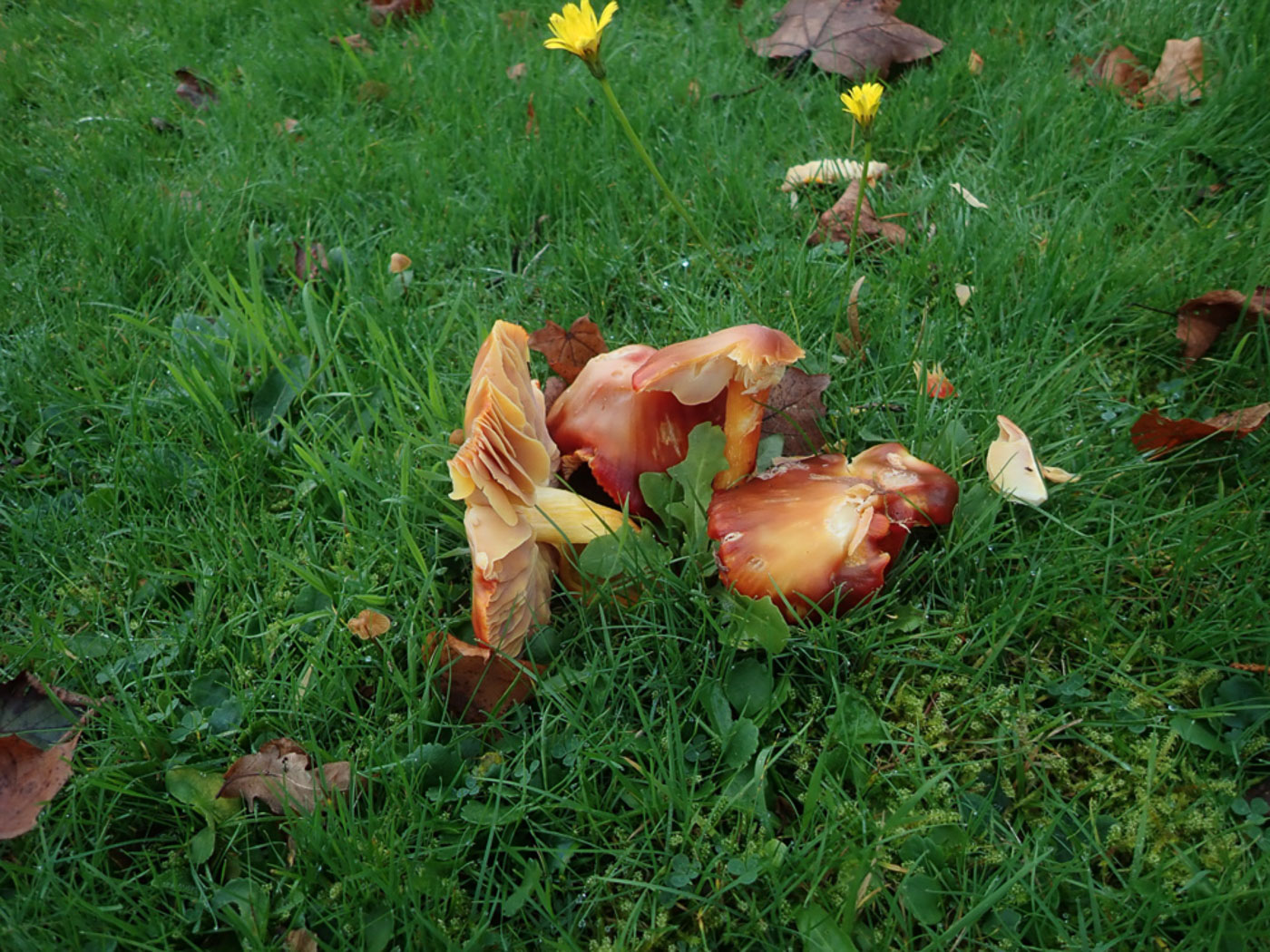
|
Nov 13, 2025. Penny went in search of the many different Waxcaps which often frequent Prestwood churchyard at this time. Though so far it has been a poor year for Waxcaps locally she was pleased to find this special species for which we have only a few county sites. It was not only in its usual spot but there was also evidence of it though damaged almost beyond recognition in a couple of other areas. This was, after all only days after Remembrance Day when the churchyard would have been full of people, so it was perhaps surprising that there were any undamaged fungi to be found here. |
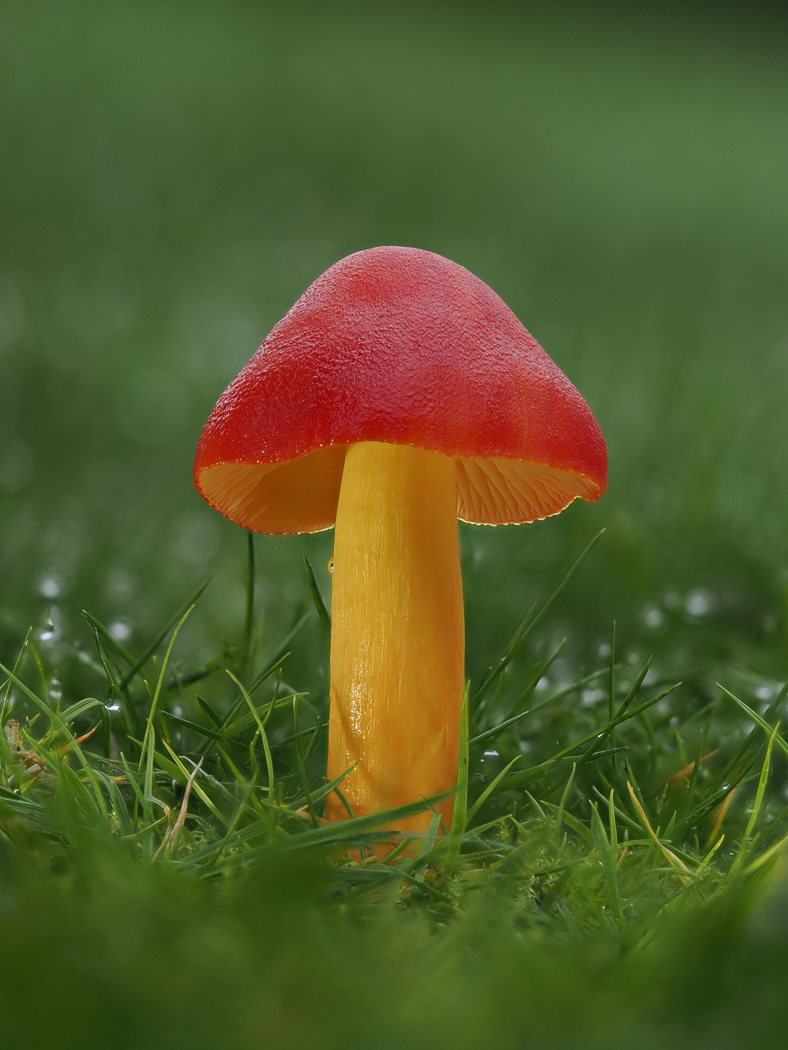 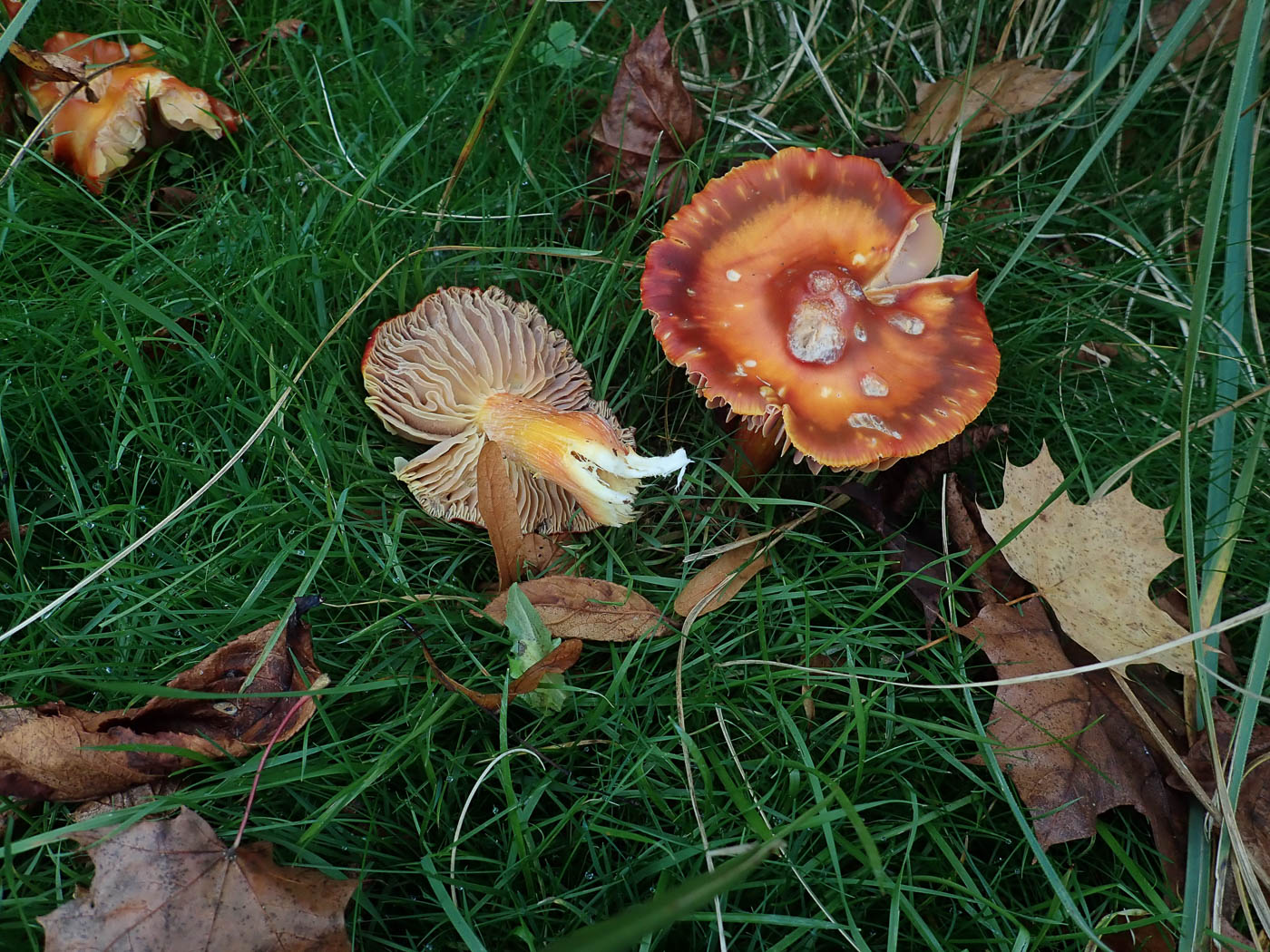 |
Nov 3, 2024. At Stoke Poges Memorial Gardens Eleanor Page took this lovely photo of one of our less common waxcaps though this site is one of its county strongholds along with Prestwood Churchyard. This is a large chunky waxcap with a thick fibrous stem and even when young as here one can tell it has the potential to grow much bigger. Sarah and Penny found it 2 days later at Prestwood when the largest cap was a good 8 cm across (photo 2), and it was still fruiting well at Stoke Poges a week later. |
 |
Nov 15, 2023. Penny went to Prestwood Churchyard today with the express purpose of checking to see if this stunning Waxcap was fruiting as conditions and timing seemed perfect. Success! This is one of our largest and most showy Waxcaps and we have quite a few county records though almost all either from this site or Stowe Landscape Gardens where we visit this coming weekend. It didn't make an appearance here last year though was found in exactly this same spot the two previous years, always late in the season. Fungi can be deceptive in size in photos but the two front specimens were about 10 cms tall. |
  |
Oct 30, 2021. In Prestwood Churchyard the first bit of lawn Penny checked was the site where this stunning and uncommon species had been fruiting the previous year. Sure enough, though well camouflaged by fallen leaves, there it was! This is one of the largest Waxcaps, standing up to 12 cms or more tall and with a thick chunky dry stem. The cap is dry to greasy and a subtle shade of red - not bright and dazzling but with a brown tinge and often a paler margin; the gills are ventricose, reddish with a yellowish edge, and the dry stem is some combination of red, orange and yellow. Our only regular county site for this species is Stowe Landscape Gardens though it occasionally turns up at Penn or Stoke Poges Memorial Gardens. |
 |
Nov 18, 2020. If you are unfamiliar with this quite rare, impressive and beautiful species, Penny C. recommends a visit now to Prestwood churchyard where it is showing well as seen in her photo today. Her earlier photo, dated Nov 13, is overshadowed by today's collection of perfect specimens. (If you'd like the exact location for them contact Penny.) |
 |
Nov 13, 2020. Penny C. was delighted to find three specimens of this rare and beautiful species in Prestwood churchyard. This is the largest Waxcap, apparently sometimes getting to 15 cm high with the cap equally wide! The tallest today was a modest 10 cm tall with the cap just 6 cm across but clearly far from fully grown and expanded. The intensely deep red cap is sticky, the gills are widely spaced and the stem is thick, dry, coarsely fibrous and some combination of red, orange or yellow. We have a few records from Penn Street cricket pitch but not since 2013, one from Stoke Poges Memorial Gardens, also regular records from Stowe Landscape Gardens, but I found (but had forgotten all about) one of my records from today's site back in 2005. |
| Hygrocybe quieta (Oily Waxcap) |
  |
Aug 4, 2023. Under Hornbeam in Hodgemoor Woods Penny thought she'd found a Chanterelle but then realised it was a Waxcap! In fact, though we think of Waxcaps as grassland species they can and do appear in woodland and this species has been recorded here before. Features to note: the gills tend to be a darker orange than the cap, under the scope the spores are quite distinctive and have a 'waist', but the best pointer is its smell: similar to that of Lactarius quietus (hence its common name) but unique for a Waxcap species. Placing a specimen in a pot to dry out a bit, then mashing part of the gill surface can help to make this smell more obvious. |
 |
Jul 15, 2021. In a grassy area at Stampwell Farm Jackie Ewan found yet more Waxcaps though she was unsure of the species - there were several possible orange capped candidates and it was not until Penny suggested cutting one in half and rubbing it to see if she could detect an oily smell similar to Lactarius quietus that the species became clear, the spores when checked confirming it. Not rare but possibly misidentified as the smell is often not obvious, this is now our fifth July Waxcap species which could be a record for this month in the county. |
 |
Sep 16, 2020. his collection was found by Jesper Launder in a grassy patch in Hodgemoor Wood. A typical brightly coloured waxcap, this species is not always easy to separate from others. The yellowish caps combined with orange gills and stem are good characters, but the smell if detected is the clincher in the field and gives rise to the common name. If your bruise the flesh or cut it, it has a distinctive oily rubbery smell very similar to Lactarius quietus (Oak Bug Milkcap) - not helpful, of course, unless you are familiar with that species! |
  |
Oct 3, 2020.  Penny Cullington found this in mown grass in the Penn Street churchyard. Believe it or not, it was all one large but rather broken specimen! We do have another photo (dated Sept 16) though the cap colour is much more typical here, thus worth including. Another medium sized yellow Waxcap, this one has orange gills and stem (compare with the pale yellow gills of the similar H. chlorophana, same date), also a smell similar to that of Lactarius quietus - hence the Latin species name. Photo 2 contains both these two Waxcaps for comparison: Left is H. chlorophana (two specimens) and Right is H. quieta (one large and one small). (As the two have differently shaped spores, these were checked to confirm the field identification.) Penny Cullington found this in mown grass in the Penn Street churchyard. Believe it or not, it was all one large but rather broken specimen! We do have another photo (dated Sept 16) though the cap colour is much more typical here, thus worth including. Another medium sized yellow Waxcap, this one has orange gills and stem (compare with the pale yellow gills of the similar H. chlorophana, same date), also a smell similar to that of Lactarius quietus - hence the Latin species name. Photo 2 contains both these two Waxcaps for comparison: Left is H. chlorophana (two specimens) and Right is H. quieta (one large and one small). (As the two have differently shaped spores, these were checked to confirm the field identification.) |
| Hygrocybe reidii (Honey Waxcap) |
 |
Oct 10, 2024. At Stampwell Farm Jackie Ewan found several Waxcaps coming up including this one. Though similar to other small species it can be distinguished in the field by its orange tint, pale gills, and if you squash the cap a bit it has a distinct smell of honey. |
  |
Oct 28, 2023. At Stampwell Farm Jackie Ewan found several areas where this Waxcap was popping up. She suspected it was this species though often its telltale honey smell is reluctant to be really convincing even when one mashes the gills a bit! However, once the specimens started to dry off a bit she reports the smell became really obvious, confirming her first impressions. |
 |
Dec 6, 2022. In St. Giles Churchyard Penny found just these two specimens which to her looked too orange in colour with gills too pale for H. coccinea (Scarlet Waxcap) which was also fruiting nearby. The give-away smell was missing, however, until it had dried out for several hours after collection when a bit of gill tissue was mashed a bit to reveal its smell of honey. (The photo is Claire Williams's.) |
 |
Oct 30, 2020.  Penny found this collection amongst quite a few Waxcaps similar in appearance in mossy grassland at Coombe Hill. In contrast to H. miniata which was nearby, she noted the more orange colours and smooth shiny cap surface and when the gills were crushed she detected a smell of honey which is unique to this particular species of Waxcap. This smell is not always obvious: some specimens oblige, others from the same collection don't! But crush one really firmly and put it in a pot and, as is usually the case with fungal smells, it will increase after time to give you a better chance of picking it up. To be sure, one should always check the spore shape and size to confirm. Penny found this collection amongst quite a few Waxcaps similar in appearance in mossy grassland at Coombe Hill. In contrast to H. miniata which was nearby, she noted the more orange colours and smooth shiny cap surface and when the gills were crushed she detected a smell of honey which is unique to this particular species of Waxcap. This smell is not always obvious: some specimens oblige, others from the same collection don't! But crush one really firmly and put it in a pot and, as is usually the case with fungal smells, it will increase after time to give you a better chance of picking it up. To be sure, one should always check the spore shape and size to confirm. |
| Hygrocybe virginea var. fuscescens (a species closely related to Snowy Waxcap) |
  |
Oct 25, 2020. Several collections of this unusual variety of Waxcap were found by Penny C. in unimproved grassland at Ragpits Nature Reserve where BFG has recorded it before at this site in past visits, though at no other county site. Recognised by its strongly decurrent gills (as in the very common white capped H. virginea) this variety has an off white to cream cap with a cinnamon brown central spot, also the cap tends to develop radial striations in the outer half (visible in the central cap in photo 1). Like H. virginea it lack any smell.
|
| Hygrophoropsis aurantiaca (False Chanterelle) |
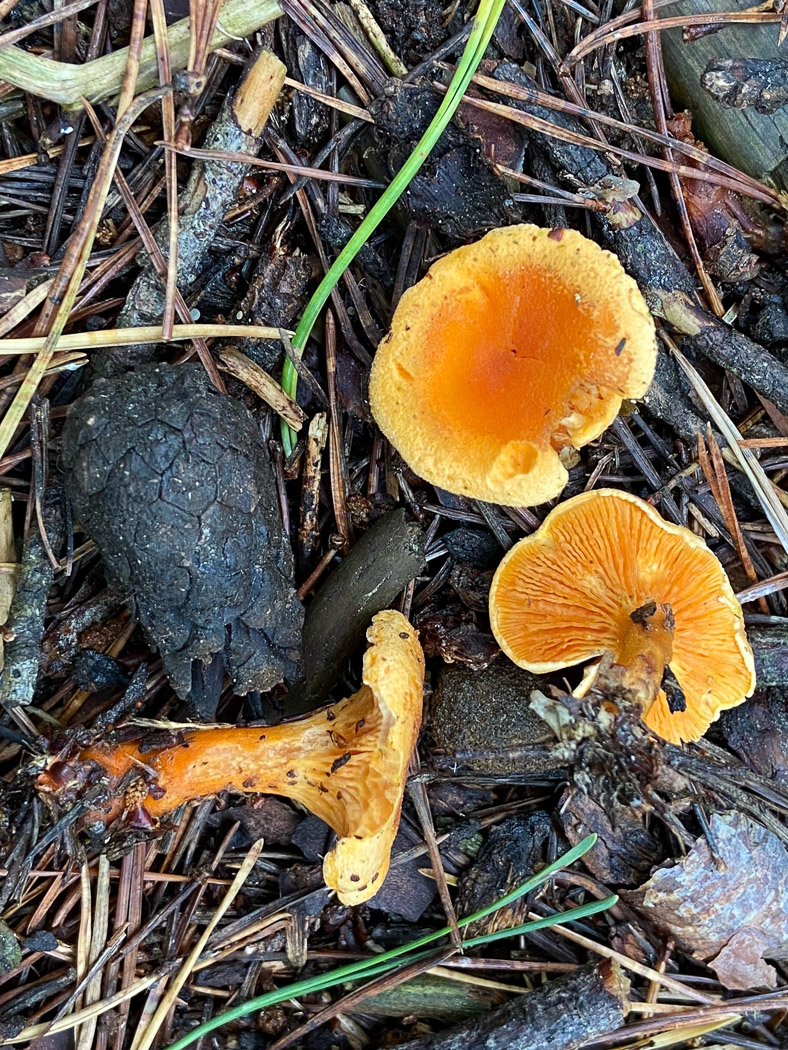 |
Sep 24, 2024. At Rushmere Estate Stephen Plummer found this species whilst under Pine. It tends to favour conifer woodland but can also occur in deciduous woods. Noting the sharp edged gills seen here should prevent any confusion with Cantharellus cibarius (Chanterelle) which has much broader 'foldlike' gills, though both species do have a similar colour and general shape. |
 |
Aug 4, 2023. In the dense Pine litter in Hodgemoor Woods this common species was beginning to appear. Though the cap colour can vary - here it is quite pale orange - the closely packed fine orange gills which run well down the stem should make the species easy to identify. |
  |
Sep 29, 2022. In the areas with Pine this was the more prolific species at Stoke Common found by Penny, though all were small and young as seen here. |
  |
Nov 7, 2020. We have rather poor photos of this dated Oct 27, so Penny C. took the opportunity to share hopefully better images when it showed up again today under Pine at Stoke Common. Though normally very common it seems to have been scarce this autumn. This is a somewhat pale collection but the rather wrinkled decurrent gills are clear, a good diagnostic feature. |
  |
Oct 27, 2020. It seems remarkable that this normally common species is only just making an appearance. It was found in a Spruce plantation near Ibstone by Penny C. though as the fruitbodies were growing out from under a felled Oak trunk they are somewhat atypically shaped. They do at least show the deeply decurrent and forking gills (see photo 2) but are rather pale both above and below. Hopefully better examples will be forthcoming. This is a species of heathland and grassland, often where there's bracken, and can be under both conifers and deciduous trees. |
| Hygrophoropsis macrospora (Ivory False Chanterelle) |
  |
Oct 27, 2021.  Alongside a path in Stoke Common Penny noticed these really pale caps and was surprised when turning one over to see the decurrent slightly crinkly gills of Hygrophoropsis. Having been with Geoffrey Kibby in the Mire at nearby Burnham Beeches last autumn when we found the same very pale species, I knew to check the spore size to compare with the very common H. aurantiaca and in the field took the opportunity to take a comparison shot of both species (photo 2) with the pale H. macrospora on the left. The species is rare with few records as yet, new for the site here and with just the two previous county records from Burnham Beeches last year. Alongside a path in Stoke Common Penny noticed these really pale caps and was surprised when turning one over to see the decurrent slightly crinkly gills of Hygrophoropsis. Having been with Geoffrey Kibby in the Mire at nearby Burnham Beeches last autumn when we found the same very pale species, I knew to check the spore size to compare with the very common H. aurantiaca and in the field took the opportunity to take a comparison shot of both species (photo 2) with the pale H. macrospora on the left. The species is rare with few records as yet, new for the site here and with just the two previous county records from Burnham Beeches last year.
|
| Hygrophoropsis rufa (Foxy False Chanterelle) |
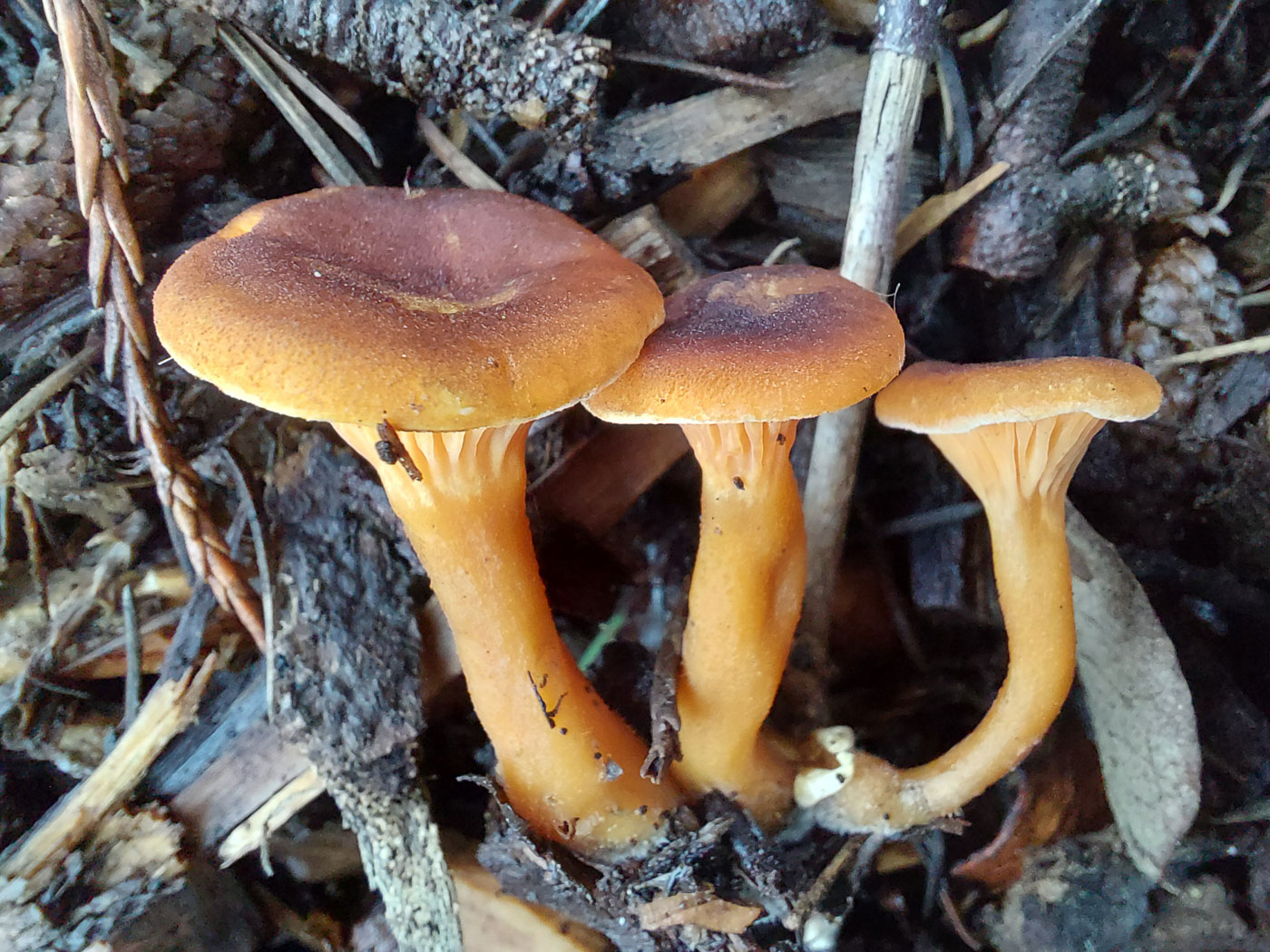
|
Dec 8, 2025. At Stoke Poges Memorial Gardens Jesper Launder found this quite unusual species still fruiting in woodchip under one of the Cedars. We have just four other county sites where it's been found though it's one Penny tends to look for here having first seen it here several years ago. We recorded it on our BFG walk here in November though the material was not the greatest so it's good to have Jesper's photo showing the typical rufous and slightly roughened cap which distinguishes it from the common and more familiar False Chanterelle. |
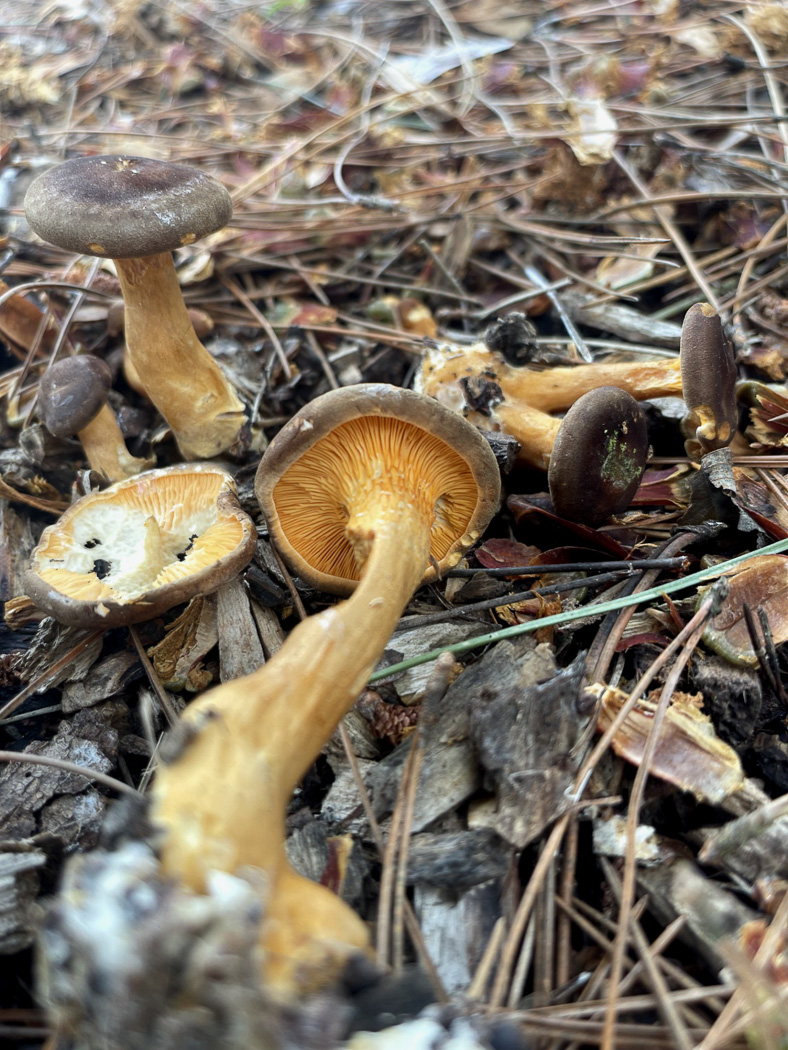
|
Oct 24, 2025. In the Tree Cathedral at Willen, near Milton Keynes, Justin Long noticed this interesting False Chanterelles in conifer litter. The orange sharp edged decurrent gills placed them firmly in Hygrophoropsis but the caps were notably darker than in the common H. aurantiaca so he investigated further, finding this species previously named a variety of H. aurantiaca but since 2008 raised to species level. The cap surface is very different in this species being finely furry, also the margin tends to stay inrolled and the proportions seem different to Penny with a longer stem and smaller cap. This is now our 5th county collection. |
  |
Oct 23, 2022. In Granborough churchyard Jesper Launder noticed this False Chanterelle which had a dark roughened and finely hairy cap centre, making it this relatively recently described but quite distinctive species. We have a couple of previous county records, one of them in Finds 2020 October 28th. |
  |
Oct 28, 2020. Yesterday Penny C. found the common H. aurantiaca starting to fruit so she was not surprised to find more of it today at Stoke Poges Memorial Gardens. She'd forgotten, however, that last year at this time here she'd found this much rarer - or at least rarely recorded - species which has a darker rufous cap coated in fine dark hairs and also distinctly darker orange gills. A small collection was growing in woodchip under Birch. Our only previous county records are from Stowe Landscape Gardens and today's site last year. The species is illustrated in Kibby vol 1. |
| Hygrophorus chrysodon (Goldflecked Woodwax) |
  |
Oct 20, 2022. In Lott Wood near Stokenchurch on a mossy bank near Beech there were several sticky white Woodwaxes dotted about, and one caught Penny's eye having a distinct but broken bright yellow edge. This is a rare species - we have just 4 previous records all pre 2000 - and was one Penny'd never seen though has been on the lookout for. It seemed less glutinous than its neighbours (probably either H. eburneus or discoxanthus - both very common and fruiting at the moment) and lacked any reaction to KOH - a useful test for the many sticky white species of the genus. This is a first for Finds, both photos are Stephen Plummer's.
|
| Hygrophorus discoxanthus (Yellowing Woodwax) |
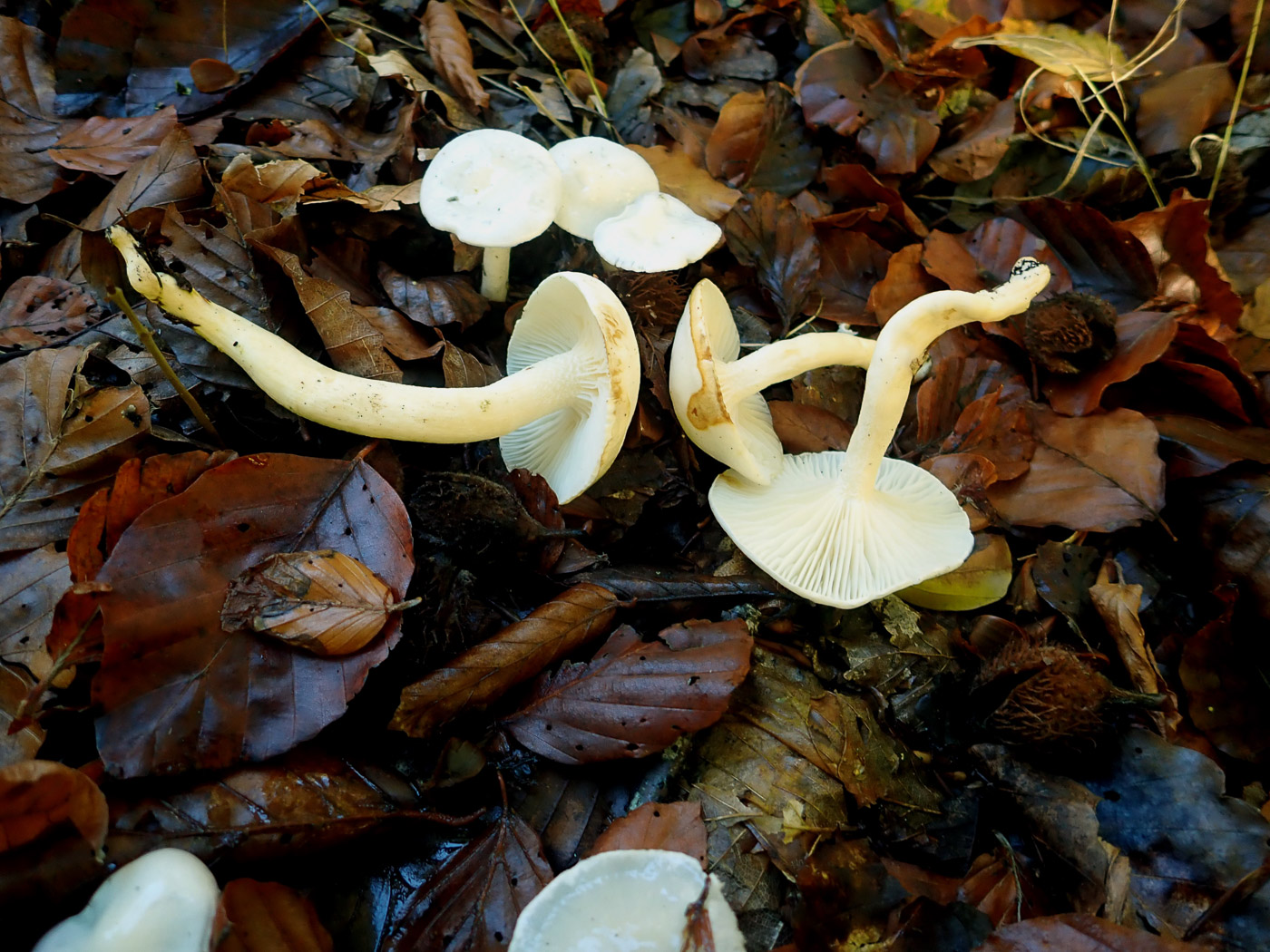 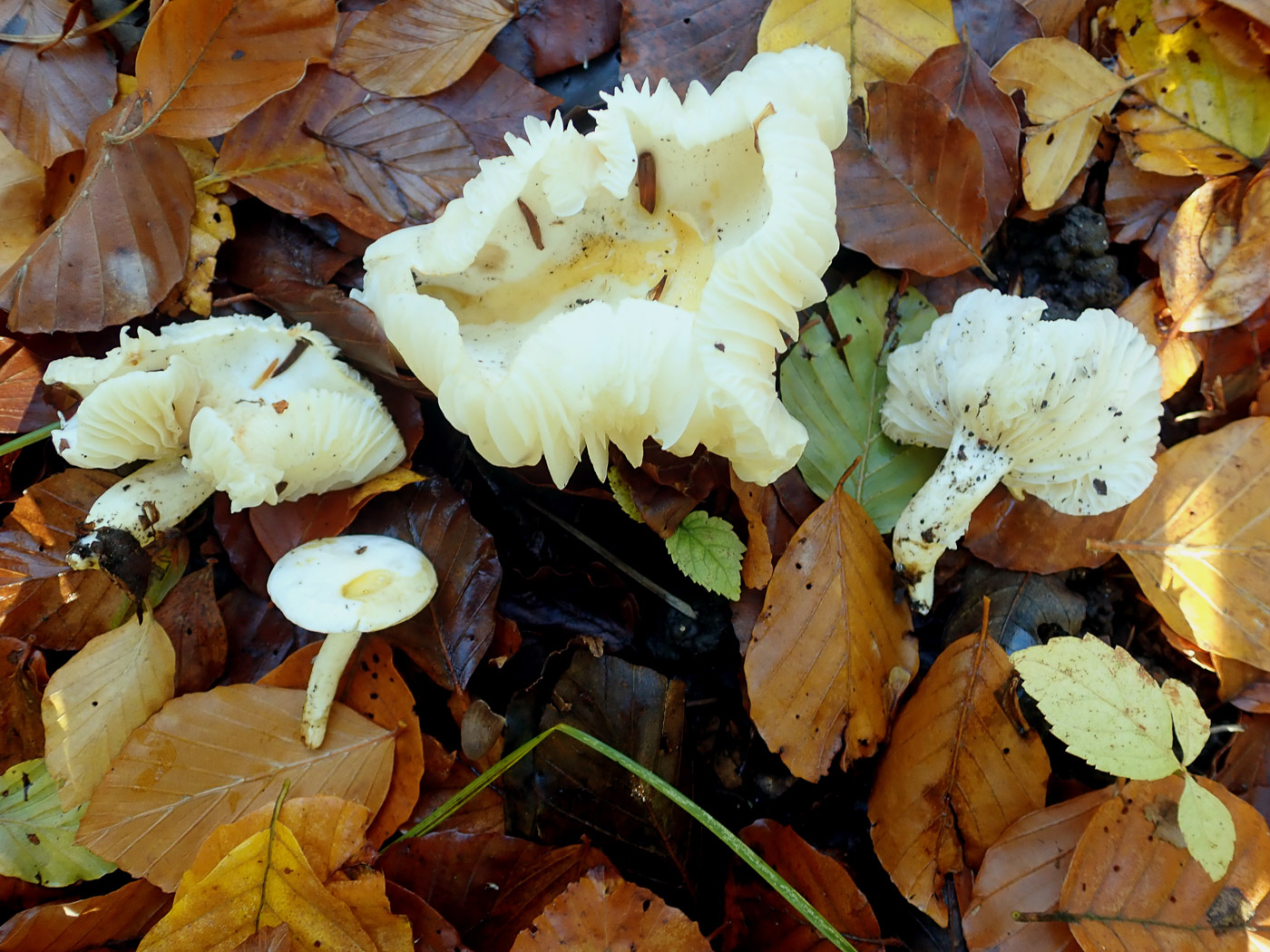
|
Oct 24, 2025. There was a bumper crop of Woodwaxwes under Beech at Gussetts Wood today with 4 different species found by Penny and Paul. The white slimy capped ones were really plentiful and could only be separated with a drop of KOH on the cap: yellowish brown after a few seconds in H. discoxanthus but no change in H. eburneus (Ivory Woodwax). In fact as the caps were wet the KOH ran round the cap edges as can be seen in photo 1. Photo 2 shows a huge specimen with cap strongly upturned (but still the KOH test shows in the centre!) |
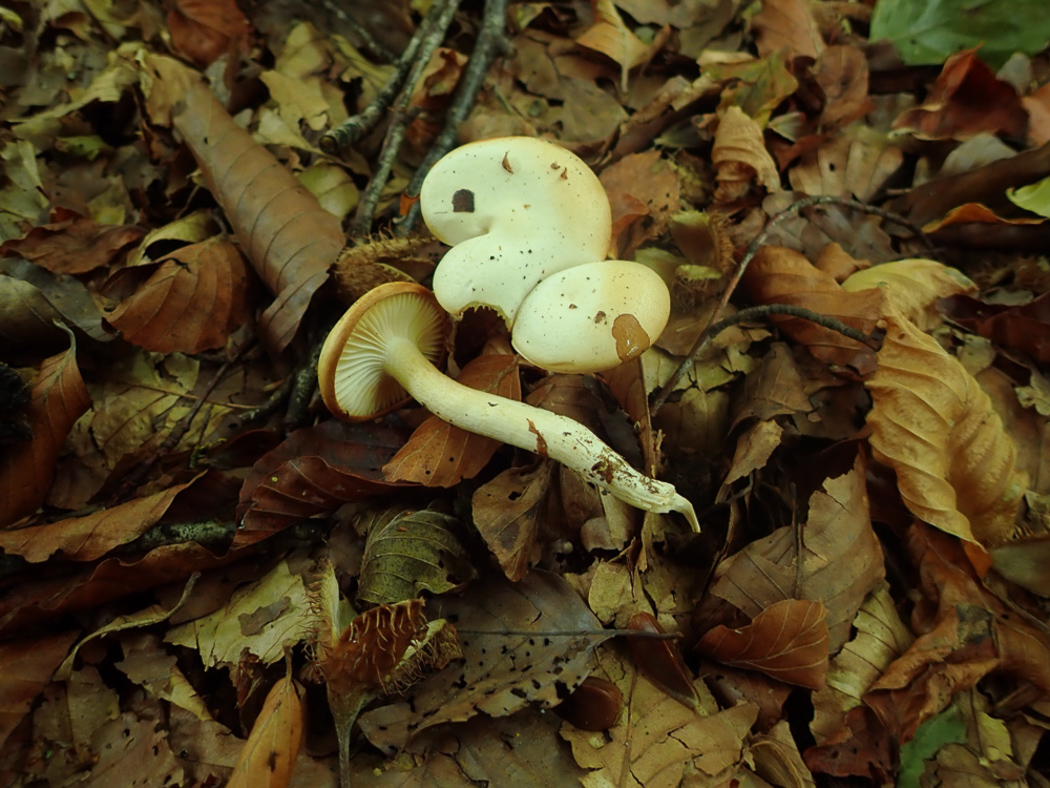
|
Oct 7, 2025. In Gussetts Wood Penny saw many white sticky capped woodwaxes under the Beeches but this particular group was already turning rusty brown around the edges, this indicating that it was not the pure white H. eburneus (Ivory Woodwax) which remains white at it matures, but this less common species. It is likely, however, that because both species are more or less identical when young and fresh both would tend to be named H. eburneus, so H. discoxanthus may well be more common than is realised. A drop of KOH helps to split them if no brown staining is in evidence because H. eburneus reacts negatively on the cap (ie no change) whereas H. discoxanthus turns chestnut brown within a few seconds. H. eburneus turns orange at the stem base with this chemical, however. When the fruitbodies are already visibly browning as here then the KOH test becomes unnecessary. |
  |
Aug 16, 2023. Under Beech in Gussett's Wood Penny and Paul found various examples of white Woodwax, one collection of which was H. eburneus (see under that species below under August 14th). The collection shown here, however, appeared different: less sticky, larger and just beginning to discolour with age. Penny assumed it was different but did not realise it was in fact H. discoxanthus until at home later when she placed a drop of KOH on the cap which turned it instantly rusty brown (photo 2). When immature this species can be identical with H. eburneus when the KOH test comes into its own. Both are quite common under Beech but usually fruit later in the autumn season. |
  |
Oct 21, 2021. In Mousells Wood Penny found this sticky white species and knew that it would need testing at home in order to name it. There are several extremely similar white Woodwaxes, some are sticky, some are dry, and the host tree can be significant also. Under Beech as here there are two likely candidates, both quite common, which can be split with a drop of KOH. The cap of today's species turned instantly yellow brown with KOH (and in fact in the field old specimens can often be found having naturally turned yellow or brown in places), whereas H. eburneus never yellows in the field and only turns brown at the stem base with KOH. See H. eburneus dated Oct 20th for comparison. Photo 2 is of a more mature collection made a week later near Jordans Village by Jesper Launder where the beginnings of natural yellowing can be seen at the cap edge. |
| Hygrophorus eburneus (Ivory Woodwax) |
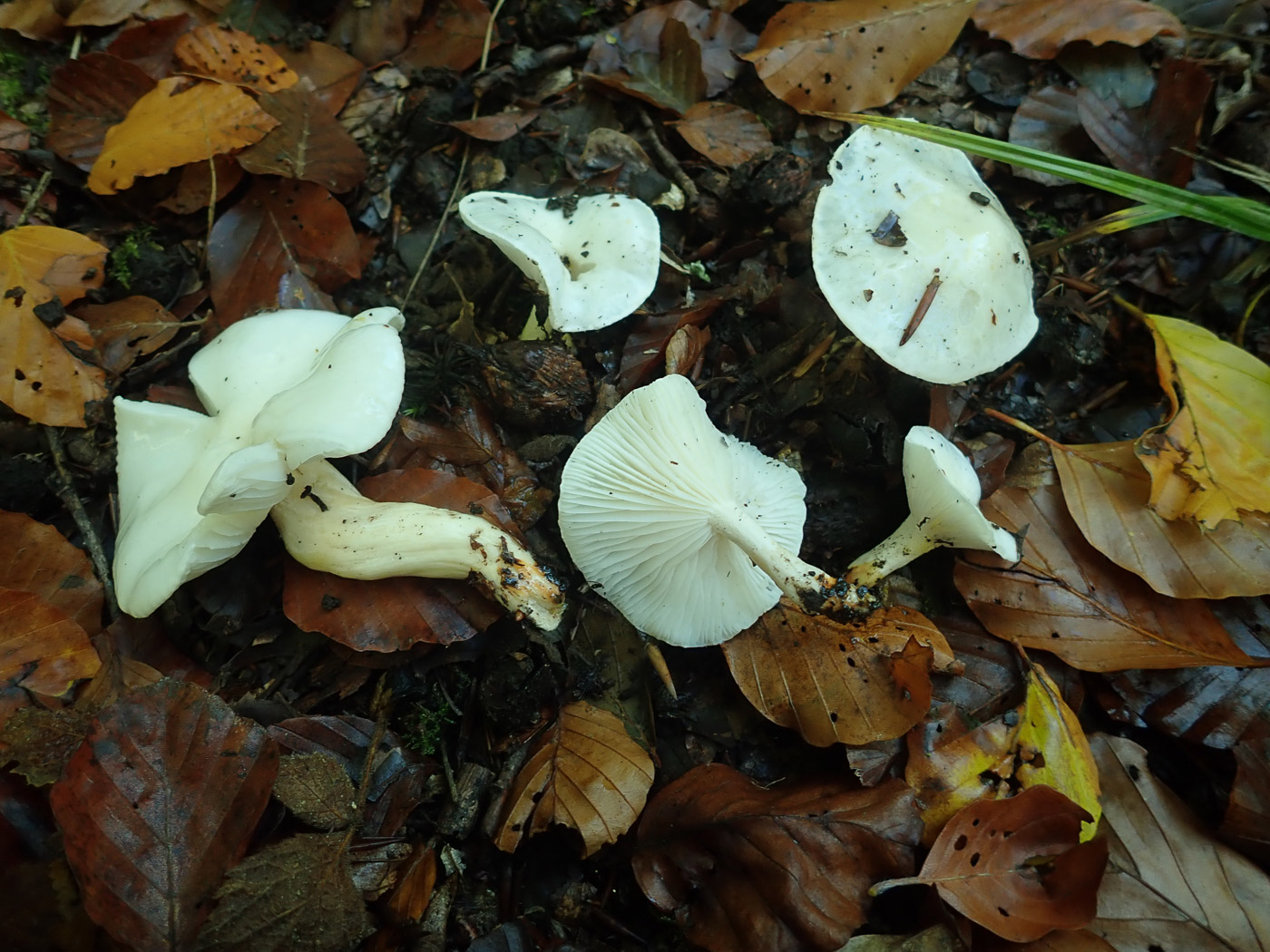
|
Oct 24, 2025. In Gussetts Wood under Beech this was one of four Woodwax species found by Penny and Paul. This one is considered the commonest of the white slimy members of the genus - host specific to Beech and having a cap with negative reaction to KOH in contrast to the identical H. discoxanthus (also found today) which turns quickly brown. However, a drop of KOH on the stem base of H. eburneus turns rusty orange red, as can just be seen here in the three upturned specimens. |
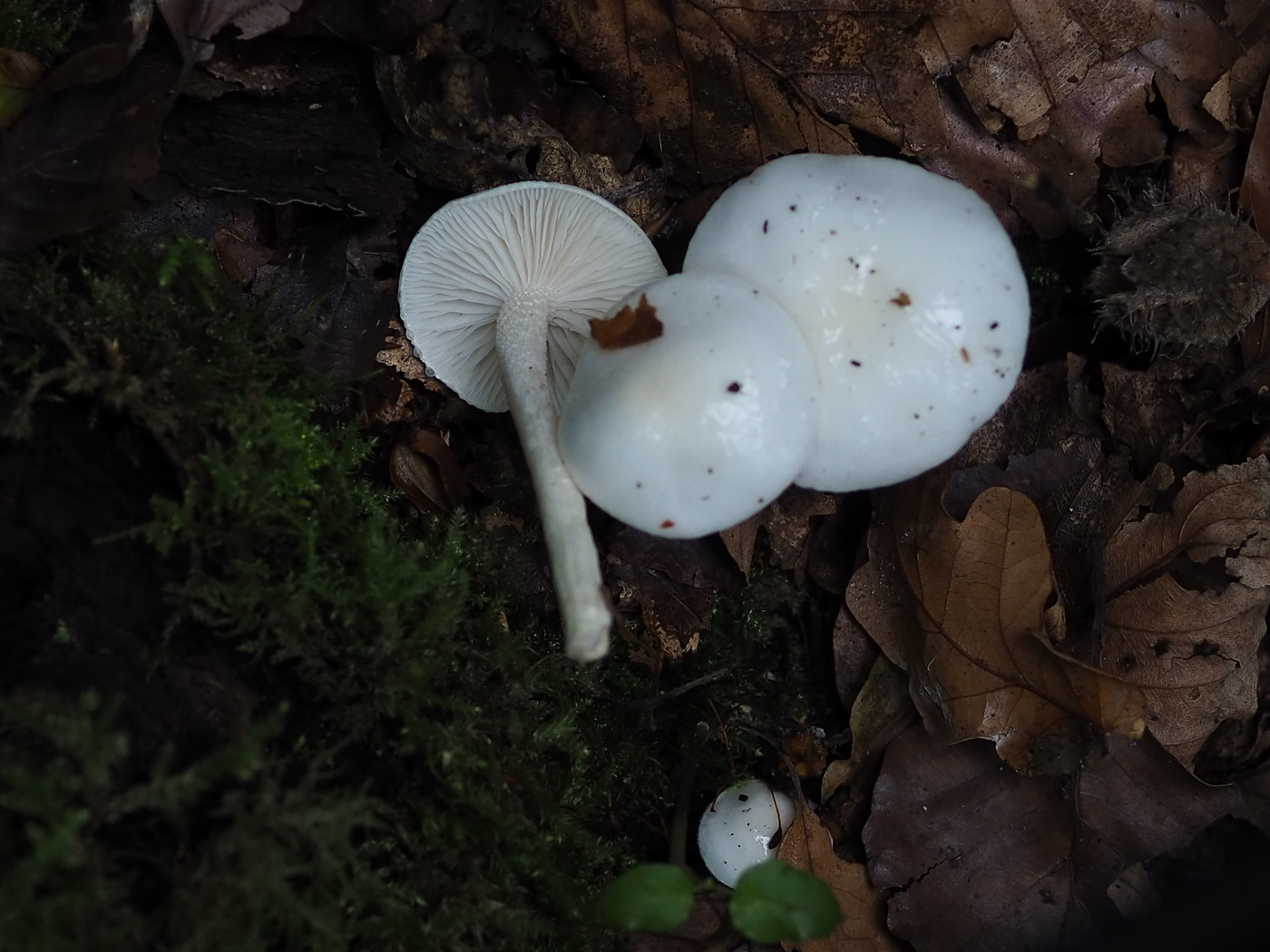
|
Oct 2, 2025. In Tinkers Wood John Catterson found these rather slimy white mushrooms under Beech and took them home to test with a drop of KOH in order to decide which of the two likely sticky white candidates they were. A drop on the cap turns quickly rusty brown on H. discoxanthus (Yellowing Woodwax) which with age tends to discolour this way naturally, but John found the KOH only reacted orange on the stem base with no change on the cap, indicating H. eburneus. Both are common, however, and occur under Beech and when fresh this test is essential to be able to split them. |
  |
Aug 14, 2023. Under Beech in Tinkers Wood John Catterson found these pure white and very slimy little mushrooms and assumed from their colour that they were this species. Penny, however, shed some doubt and asked him to check them with KOH - there being two very similar species occurring under Beech which can be well nigh impossible to separate. A drop of KOH on the cap of H. discoxanthus turns quickly rusty brown but is negative - has no effect - on the cap of H. eburneus. However, as seen in photo 2, KOH on the stem base of H. eburneus has this same positive reaction - but there only! John duly returned to the wood with his KOH and confirmed his ID. Photo 2 is of Penny's collection of H. eburneus from Gussett's Wood two days later where incidentally she also found H. discoxanthus |
 |
Oct 21, 2022. Under Beech in Gussett's Wood Penny found good numbers of this small but very slimy white Waxcap, one of several very similar species. Two of these - including this one - are common under Beech and they can easily be split with a drop or two of KOH: both go bright rusty brown with a drop on the base of the stem but only H. discoxanthus goes this colour with a drop on the cap as well. (Neither of the two rarer species react to KOH in this way.) The KOH test at home showed this collection was H. eburneus. |
 |
Oct 20, 2021. After rain in Gussets Wood under Beech Penny found many extremely slimy small mushrooms which were entirely white. There are several quite similar white members of this genus - a bit like Waxcaps but found in woodland - and it is often necessary to take one home to treat with a drop of the chemical KOH. Unlike another very common white species, the cap of which turns instantly rusty brown, today's species turns rusty brown only at the stem base with no change in the cap. |
  |
Oct 10, 2020. Penny Cullington came across good numbers of this quite unusual species in Beech litter in Gussets Wood. You know you have one of the white Woodwax species as soon as you try and pick one: they are so slimy, both caps and stems, that it can be hard to hang on to them, especially after rain as today. There are several almost identical white species and one needs to notice under which tree they are growing and then test them later with a drop of KOH. Today's species grows under Beech and KOH on the cap has no effect at all but the stem base turns bright rusty orange (see photo 2). Hopefully we'll be able to demonstrate KOH on other Woodwax species when available. |
| Hygrophorus hypothejus (Herald of Winter) |
 |
Dec 13, 2021. Knowing that Penny was on the lookout for this unusual species and that it occurs under Pine, Sarah Ebdon went looking for it in Hillock Wood nr Great Hampden and was successful! The genus Hygrophorus (Woodwax) tends to fruit at the end of the autumn season but only the white and somewhat slimy species are considered common - H. eburneus and discoxanthus, both of which occur under Beech. The yellow-capped H. lucorum is found under Larch but quite rarely (and not recorded in the county this year as yet) and we have just a handful of known sites for H. hypothejus though very few records this century, the last 10 years ago in Rushmere Estate where Pine in common. It has a distinctive olive brown slimy cap, yellowish decurrent gills and a yellowish slimy stem having a ring zone.
|
| Hygrophorus lucorum (Larch Woodwax) |
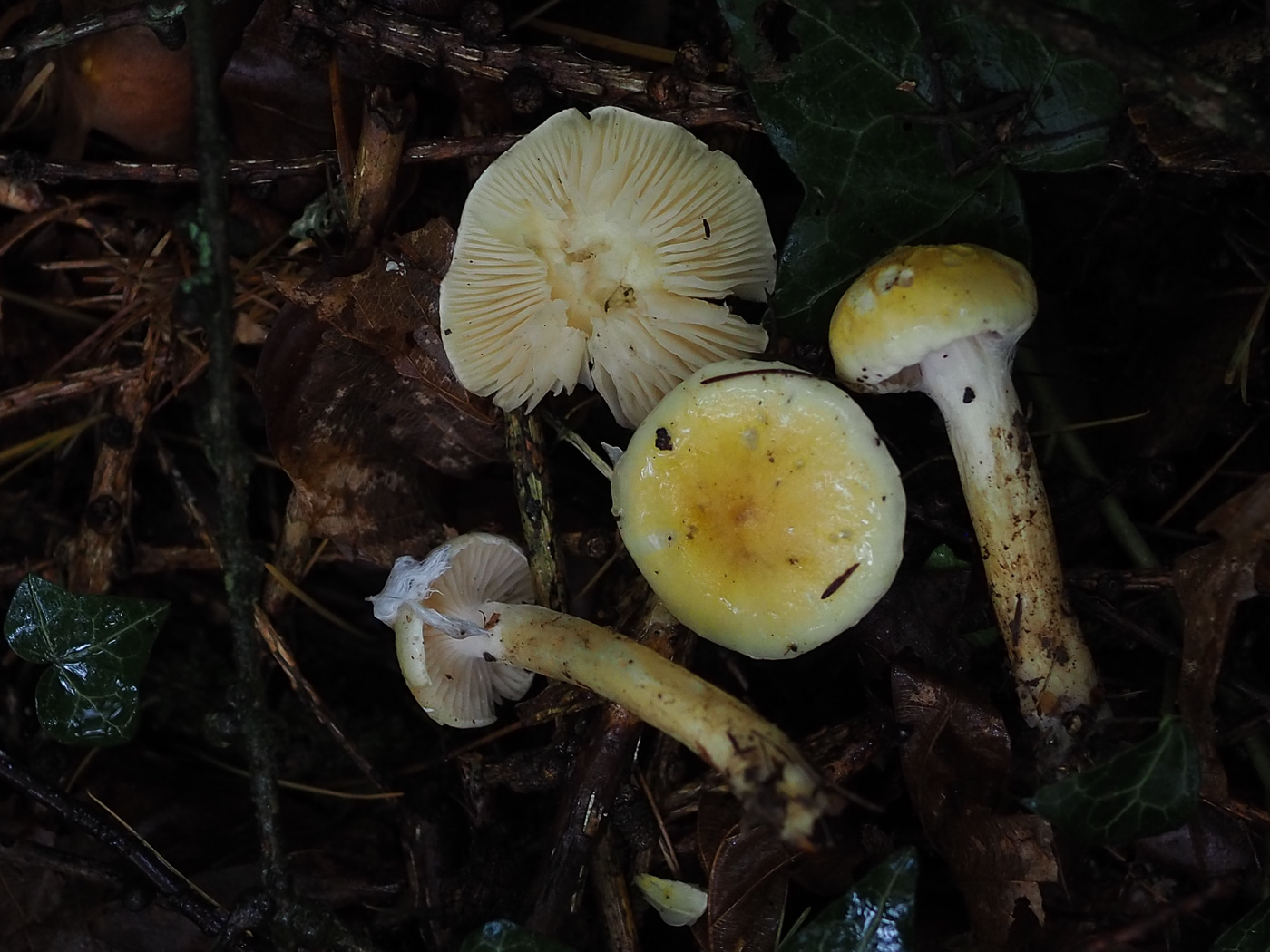
|
Oct 22, 2025. In Tinkers Wood where there is an area of Larch, John Catterson found this uncommon mushroom - host specific to that tree and often appearing late in the season. At first glance appearing something like a yellow-capped Russula, once collected the obvious sticky to viscid cap surface, rather distant and slightly decurrent gills plus a ring zone on the stem should be sufficient to eliminate that genus and identify it, given the presence of Larch of course. |
 |
Oct 23, 2020. John Catterson found good numbers of this uncommon species under Larch in a plantation near Tinkers Wood where he remembered it from last year. Like most species of Woodwax this is a late season fruiter and host specific to Larch, but fruiting seems to be very unpredictable with both good years and bad. So this is one worth looking out for now if you have that tree nearby. Any sticky yellow-capped mushroom with widely spaced slightly decurrent gills is likely to be this.
|
| Hygrophorus mesotephrus (Ashen Woodwax) |
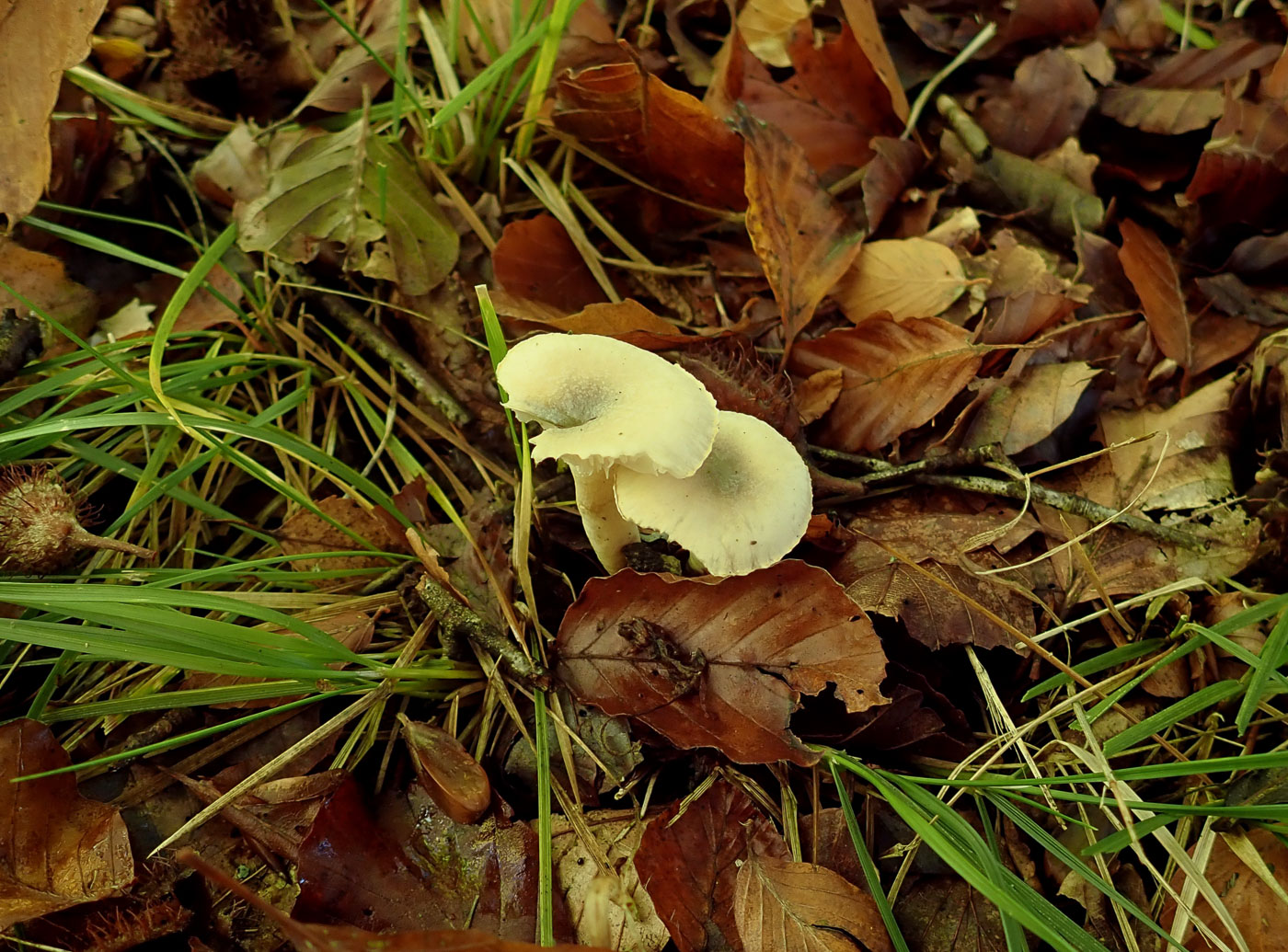 
|
Oct 24, 2025. In Gussetts Wood under Beech Penny and Paul found this quite rare Woodwax which they'd found here back in 2021 when confirmed with sequencing. It has a slimy grey cap with distinctly darker central spot, slightly decurrent white gills and the stem, though sticky below, has a ringlike zone near the top and is dry above this, also the base is tapering and semi-rooting. |
  |
Oct 21, 2022.   Under Beech in Gussett's Wood Penny found just these two specimens thickly coated in slime and knew she'd found something interesting. Unlike the other white-capped sticky Woodwaxes these had a greyish look to then with distinctly darker grey centres, also the proportions appeared different: longer stems and smaller slightly umbonate caps. At home she checked and found H. mesotephrus fitted like a glove, even to having the very top of the stem dry and slightly narrower - visible here. We have just a couple of previous county records of this species which is new to Finds. Under Beech in Gussett's Wood Penny found just these two specimens thickly coated in slime and knew she'd found something interesting. Unlike the other white-capped sticky Woodwaxes these had a greyish look to then with distinctly darker grey centres, also the proportions appeared different: longer stems and smaller slightly umbonate caps. At home she checked and found H. mesotephrus fitted like a glove, even to having the very top of the stem dry and slightly narrower - visible here. We have just a couple of previous county records of this species which is new to Finds.
|
| Hygrophorus penarius (Matt Woodwax) |
 |
Aug 21, 2023. In Bradenham Wood under Beech Penny noticed a patch of pale cream rather rounded mushrooms and turning one over she took a few moments to place the genus and then the species. This is not one of our common Beech associating Woodwaxes and is quite large and dry-capped compared to the more familiar white and somewhat glutinous species we often find under Beech. The gills are pinky cream and slightly wrinkled and the white stem tends to narrow at the base. The species was new to Penny at this site when shown her by Geoffrey Kibby over 20 years ago and we now have a dozen county records though from a fewer number of sites. This is a new entry for Finds.
|
| Hygrophorus persoonii (Snakeskin Woodwax) |
    |
Oct 19, 2023. A few days earlier when Penny received photo 1 from Stuart Blackhurst - found near Burnham Beeches - she named it (incorrectly!) Cortinarius trivialis (Girdled Webcap) on account of its heavily slimy brown cap and stem with clear band markings typical of this unusual Webcap which is a member of Section Myxacium. The species associates with Willow or Birch though Stuart said he'd notice only Oak in the vicinity and apparently the online ID service he'd submitted this photo to had suggested Olive Waxcap to him, this not being an officially recognised common name but apparently indicating Hygrophorus olivaceoalba - a species Penny was entirely unfamiliar with. Today he sent further photos which entirely changed things! The gills - not in view in photo 1 - are clearly white and not rusty, so there's no way this could be a Cortinarius! In fact the genus Hygrophorus was beginning to look more likely. Checking on H. olivaceoalba Penny learnt that this is a Spruce associate making it extremely unlikely, but similar to that species she found H. persoonii which is an Oak associate, tends to grow clustered and is extremely slimy and has clear bandlike markings on the stem. Stuart has since confirmed there is no Spruce in the vicinity, hence this ID which has not been checked microscopically but does appear to be spot on in appearance. This is a rare species for which we have very few county records, and is new to Finds (and to Penny!). This tale only goes to show how careful one has to be when making assumptions from photos where not all the vital features are shown. Please bear this in mind when sending in your photos!
|
| Hygrophorus unicolor (Twotone Woodwax) |
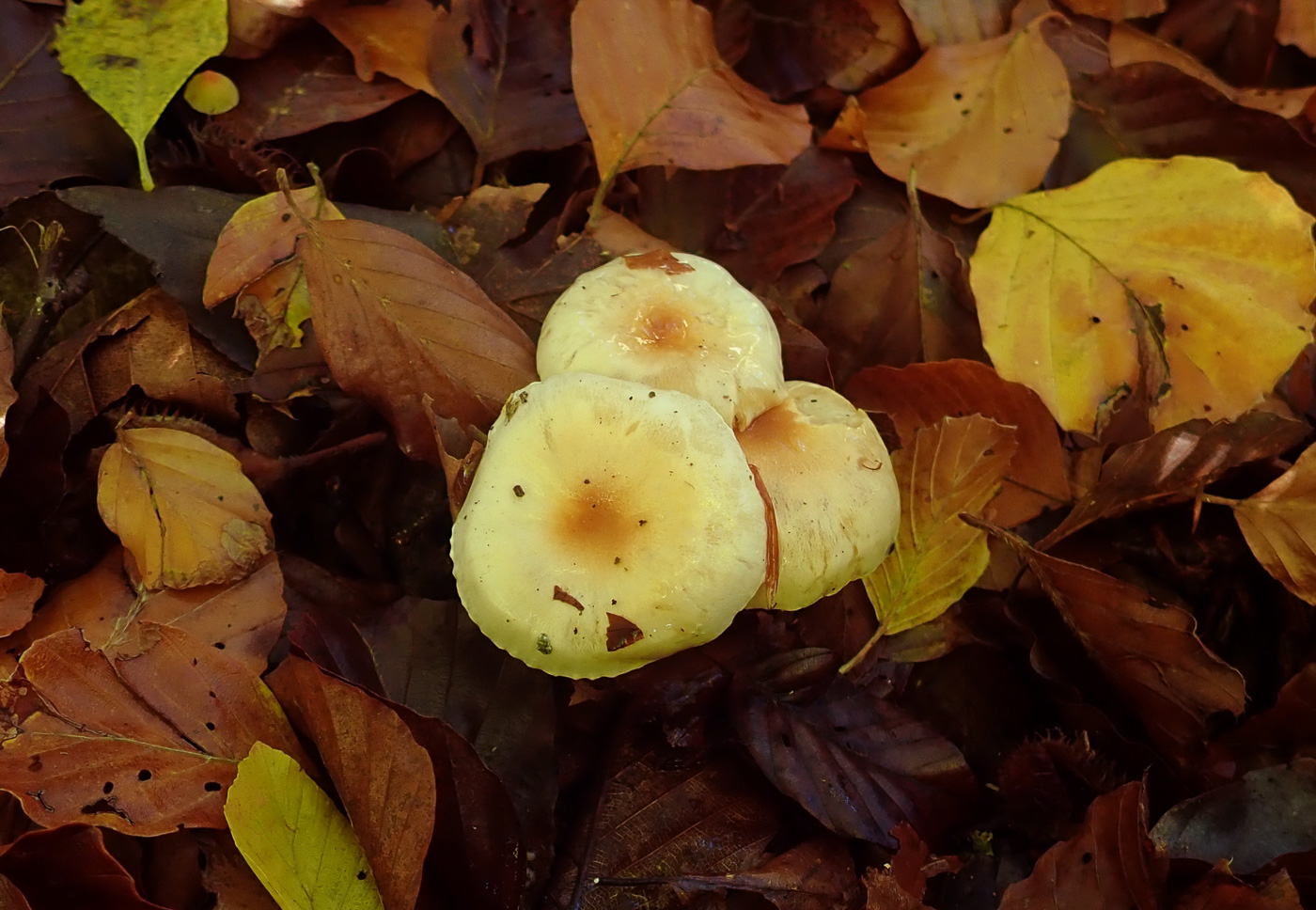 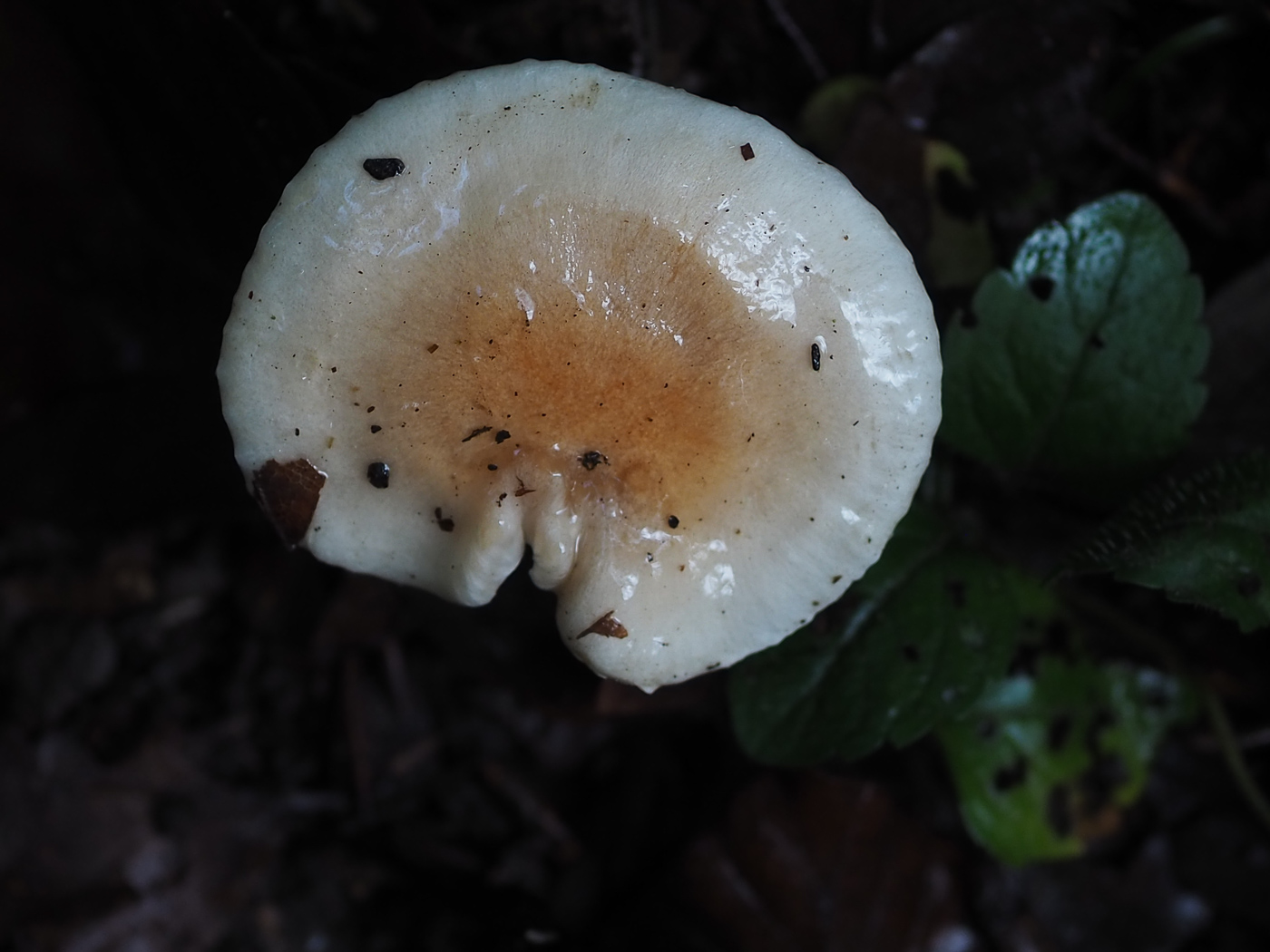 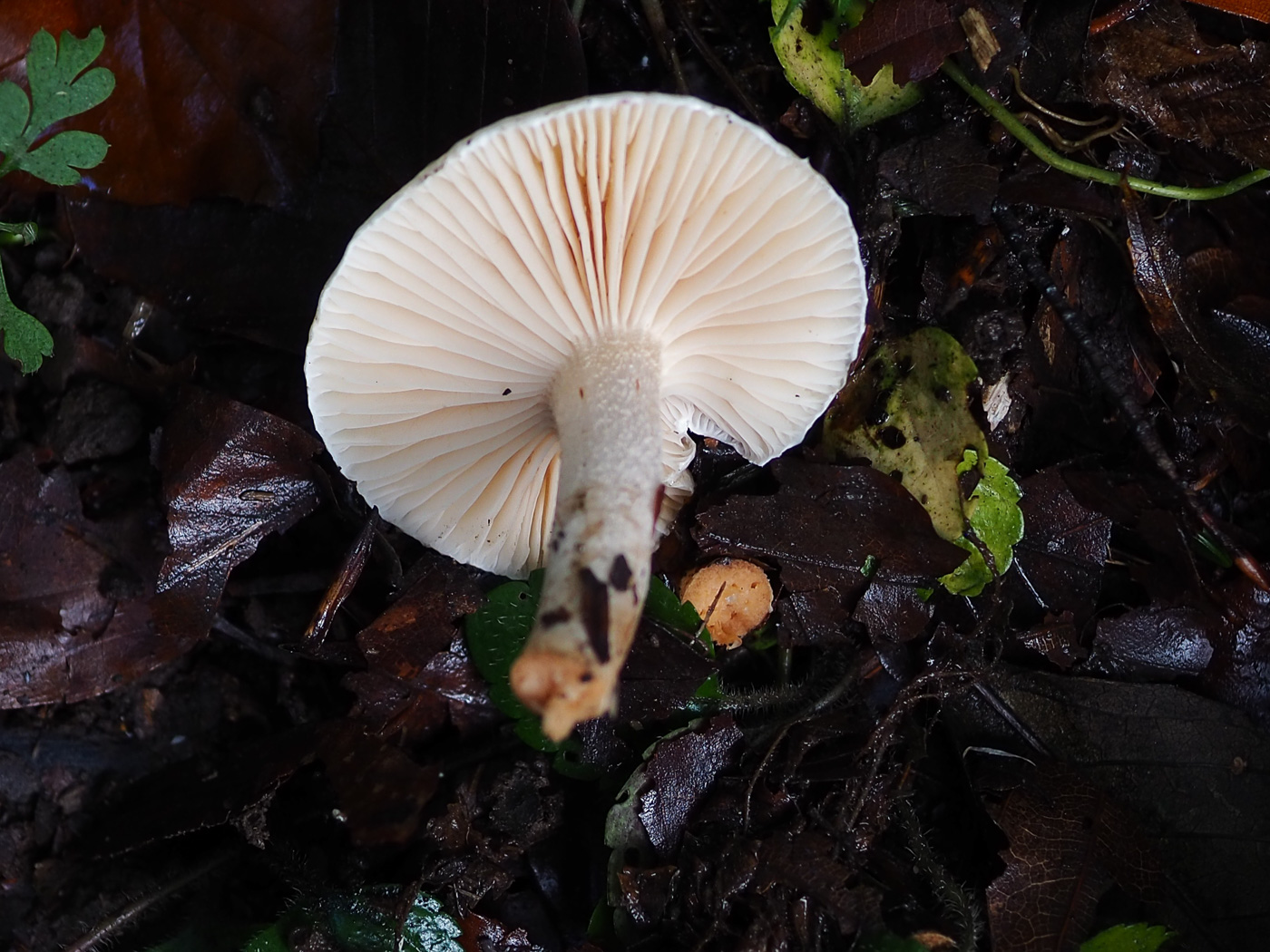
|
Oct 24, 2025. In Gussetts Wood under Beech this was one of two more uncommon species of Woodwax species found by Penny and Paul (and with a somewhat misleading Latin epithet in Penny's opinion). Uniform in colour the cap it is not! It is a subtle pale peachy pink with a distinctly darker central zone, though one has to assume that the epithet refers to the fact that the gills and stem are also this subtle colour. Sadly Penny's camera fails miserably to reflect this colour well, but a week later John Catterson also found and identified this species in Tinkers Wood. Photos 2 and 3 are his. |
  |
Aug 12, 2023. In Burnham Beeches Russell Ness was confused by this species (presumably found under Beech though he didn't stipulate). He correctly guessed the genus but was then unable to determine the species. Penny, having seen it previously, was familiar with its pale flesh pink colour in both cap and gills though its common name is somewhat confusing when the species name correctly indicates that it is all basically one colour! The cap can be darker in the centre but not always in her experience. Unlike other similar Woodwaxes under Beech it lacks their slimy stems though the cap is sticky. It is far less common, however. See also in Finds 2020 October 24th. |
  |
Oct 24, 2020. Paul C. found these two fruitbodies in Beech litter in Gussetts Wood. Far less common than the very slimy white H. eburneus (see photo dated Oct 10) which was also much in evidence here today, this species also has a sticky cap but the stem is dry and the colours very different with a subtle pink peach tone to the entire fruitbody except for the darker orange-brown cap centre. Like H. eburneus it is found under Beech. Photo 2 is of a further collection from the same site made on Nov 5th. |
| Hymenochaete corrugata (Glue Crust) |
  |
May 10, 2021. On the outskirts of Burnham Beeches in a Hazel bush Jesper Launder noticed how two dead branches had been fixed unnaturally together, and sure enough there was the fungus responsible for this phenomenon. It starts out much paler brown looking more like a species of Phellinus (or Fuscoporia) along a Hazel branch, then when meeting with a suitably adjacent twig it grows across to encompass both, thus preventing them from falling to provide itself with the nutrients from the dying wood. Clever or what?! |
 |
Feb 5, 2021. In Rushbeds Wood Joanna Dodsworth found this interesting fungus, known to encompass two separate pieces of dead or dying wood where they happen to touch, in effect fixing them together - hence its common name. This bracket-like resupinate is most commonly found on standing Hazel - a wood which abounds at Rushbeds, thus several of our 13 previous county records for the species are from this site. One could surmise that the purpose of fixing the wood together is to prevent it falling to the ground where it could become a source of nutrients for other competing fungal species. |
| Hymenochaete rubiginosa (Oak Curtain Crust) |
 |
Jan 29, 2022. In woodland near Jordans Village Jesper Launder noticed this nice example on unidentified fallen wood though the species is most common on Oak, occasional of Sweet Chestnut. It commonly forms rows of zoned cinnamon brown brackets but occasionally forms complete circles, as seen here. It is easily separated from other similar zoned brackets by its dark brown undersurface. |
  |
Mar 27, 2021. On a bare fallen Oak branch at Turville Heath Penny noticed this distinctive bracket. It tends to grow in rows forming quite shallow brackets which are dark brown above and cocoa brown below. Photo 1 shows the typical row of brackets and photo 2 the underside. It is very common on Oak though apparently can occasionally be found on Sweet Chestnut. See also Finds 2020 dated Oct 19th. |
 |
Oct 19, 2020. This colony of dark brown tiered brackets was found by Penny C. on fallen Oak in Burnham Beeches. It is similar in size., style and shape to the much more common Stereum hirsutum (see photo dated Sept 25) but is always this deep brown colour, both on the upper surface and underneath - the central top piece in the photo has been turned over to show this. It is only found on fallen Oak. |
| Hymenogaster arenarius (Sandy False Truffle) |
   |
Apr 21, 2024.  This is the second of two different Tuber species Jesper Launder found lurking in the soil under a Lime tree in his Jordans Village garden - this one new to the county with only 17 FRDBI records, mostly under either Beech or Lime. Photos 2 and 3 are of a collection Jesper made under Lime and Oak in Beaconsfield, June 7th. See the notes for the entry below for a little more general information about the genus. This is the second of two different Tuber species Jesper Launder found lurking in the soil under a Lime tree in his Jordans Village garden - this one new to the county with only 17 FRDBI records, mostly under either Beech or Lime. Photos 2 and 3 are of a collection Jesper made under Lime and Oak in Beaconsfield, June 7th. See the notes for the entry below for a little more general information about the genus.
|
Hymenogaster citrinus (Citrine False Truffle)  |
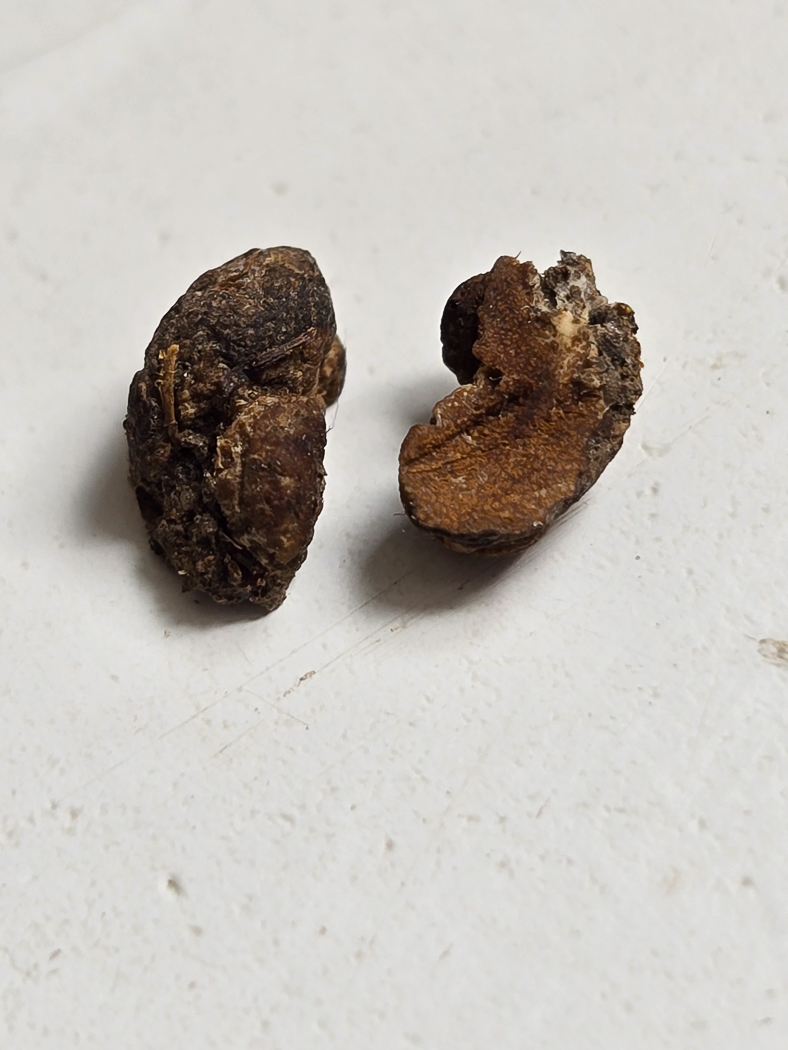
|
Jun 30, 2025. Whilst in Bourne End Jesper Launder spotted a roadside having both Hornbeam and Birch and on further investigation found some likely looking 'dig holes' underneath their canopy, ie small disturbances in the soil where small rodents had been excavating in their search for something edible, possibly truffles. As well as locating an example of the common Tuber rufum (Red Truffle), he also found this rather past-its-best truffle which he took home to identify. To his surprise he found notably large citriform to fusiform shaped spores and this together with other clues pointed to H. citrinus though he says that H. olivaceus is quite similar so cannot be ruled out definitively. Neither species are common and he's not found them at all frequently, so this is one to be dried and sequenced. What really surprised him, however, was that any member of this genus - known to favour damp condition - should be fruiting in this spell of notably hot dry conditions. His previous find of this species was new to the county. |
 |
Jun 28, 2021. In Beaconsfield in a private garden, Jesper Launder spotted some 'dig holes' in grass under Hornbeam. Further investigation revealed three small dark brown truffles which he took home to work on and, having identified this species on a previous occasion, was able to make the determination. This is a difficult genus, having many species, though there are few mycologists who find and / or look at the various truffle genera, so we are lucky to have Jesper's expertise. This is a new county record and there are under 50 national records, so this was a notable find.
|
| Hymenogaster luteus (Golden False Truffle) |
  |
Jun 10, 2024.  Jesper Launder and Sarah Ebdon returned to the Little Chalfont site where he'd discovered good numbers of various truffle species under Oak and Birch just a couple of days previously. This time they found yet another unusual species, one found just once previously in the county by truffle expert Carol Hobart in Derek's Whitchurch garden in 2011! It is recognised by its pale gleba (inner surface - phpto 2) and distinctive spores. There are only 14 records for the species in FRDBI reflecting its rarity. Jesper Launder and Sarah Ebdon returned to the Little Chalfont site where he'd discovered good numbers of various truffle species under Oak and Birch just a couple of days previously. This time they found yet another unusual species, one found just once previously in the county by truffle expert Carol Hobart in Derek's Whitchurch garden in 2011! It is recognised by its pale gleba (inner surface - phpto 2) and distinctive spores. There are only 14 records for the species in FRDBI reflecting its rarity.
|
| Hymenogaster tener (Thin False Truffle) |
  |
Apr 21, 2024.  This is one of two different Tuber species Jesper Launder found lurking in the soil under a Lime tree in his Jordans Village garden. Then two days later he found this species again under Hornbeam in Gerrards Cross (photo 2).The genus which has over 30 different species - all under 2 cm across - is apparently and surprisingly related to Cortinarius (the Webcaps)! This particular species has the smallest spores and its size here can be assessed by the comparative size of the leaves in Jesper's photos. This is just our second county record (and new to Finds) with only 30 FRDBI records, though it is not considered rare. This is one of two different Tuber species Jesper Launder found lurking in the soil under a Lime tree in his Jordans Village garden. Then two days later he found this species again under Hornbeam in Gerrards Cross (photo 2).The genus which has over 30 different species - all under 2 cm across - is apparently and surprisingly related to Cortinarius (the Webcaps)! This particular species has the smallest spores and its size here can be assessed by the comparative size of the leaves in Jesper's photos. This is just our second county record (and new to Finds) with only 30 FRDBI records, though it is not considered rare.
|
| Hymenopellis (previously Xerula) radicata (Rooting Shank) |
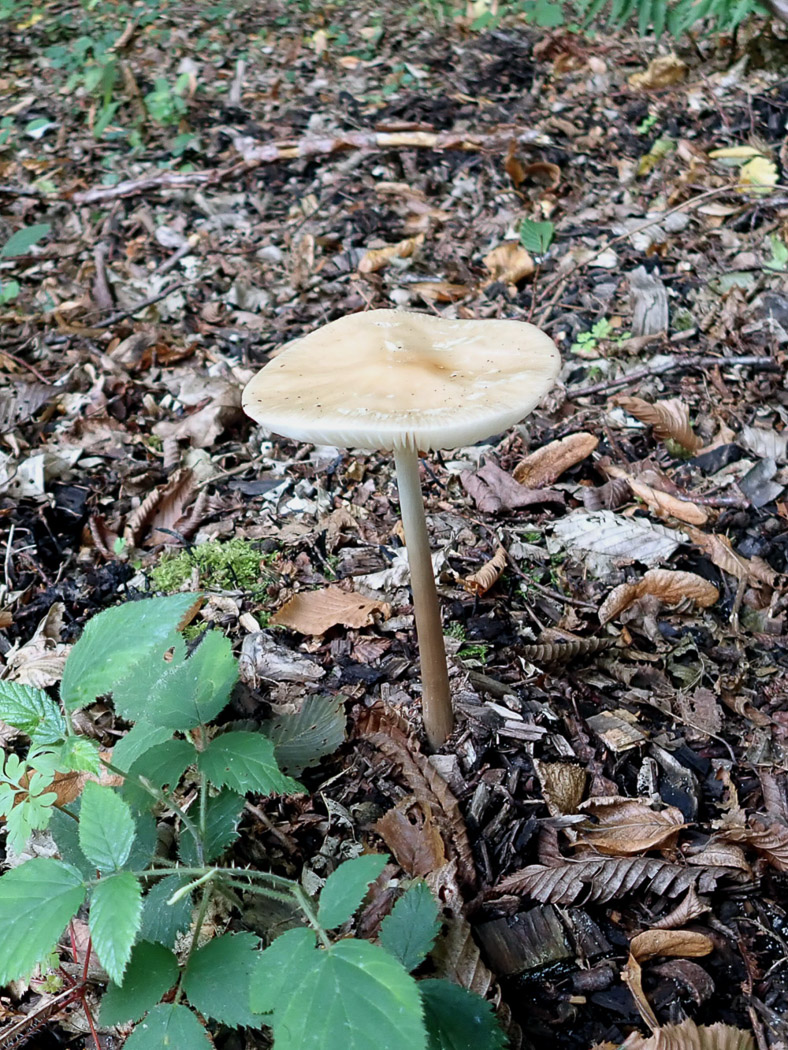 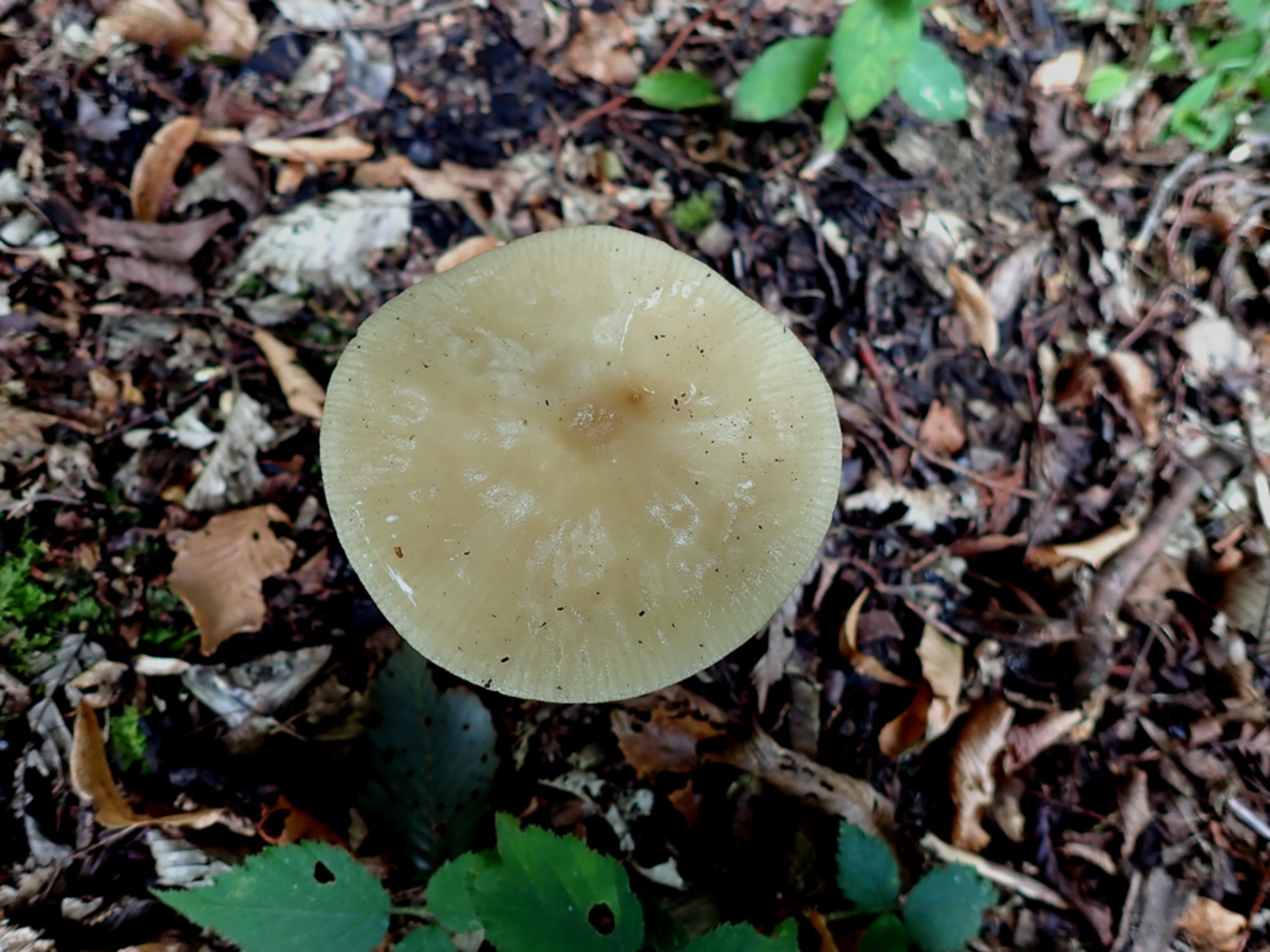 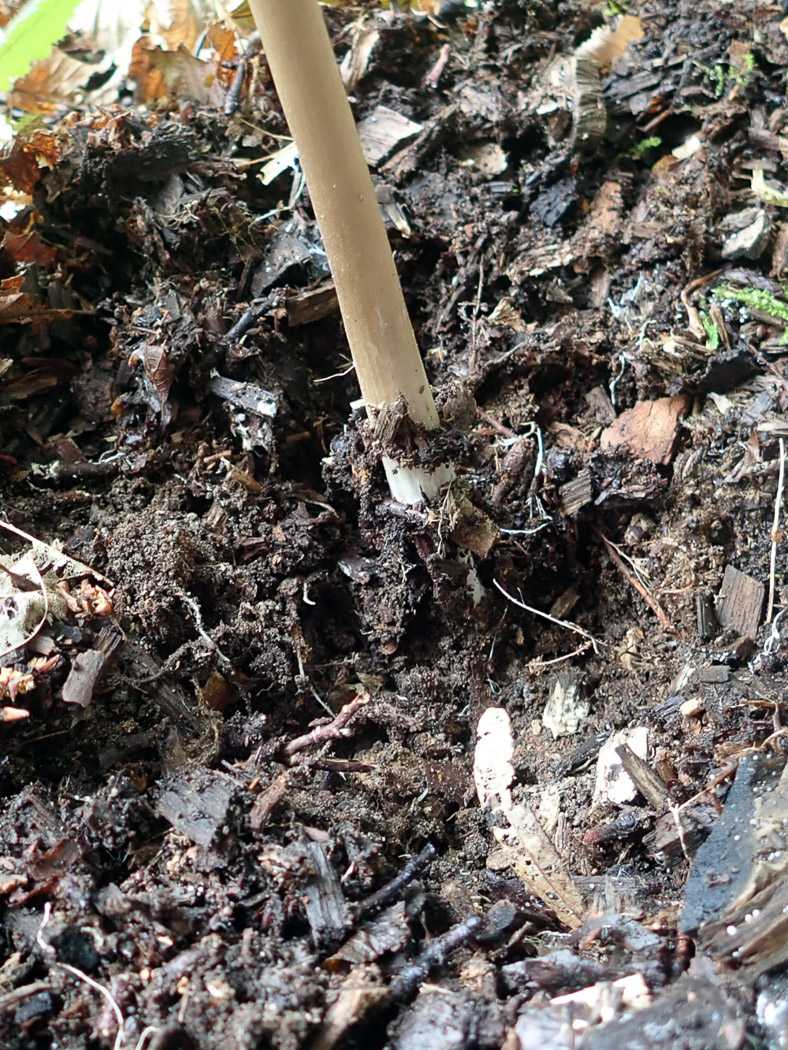
|
Aug 1, 2025. At Turville Heath under the Limes Penny was pleased to see quite a few mushrooms fruiting - a sight for saw eyes - including this smart example of quite a common woodland mushroom which often seems to confuse with its dull brown cap and white gills, one of several common species sharing those characters. After rain this species has a shiny coating of slime and develops a rather uneven slightly ridged surface (photo 2), but the give-away character is its 'taproot' which can extend for several inches down to the host piece of wood or root. Not wanting to disturb the specimen Penny dug down around the stem base revealing enough of the single thick continuation of stem descending well below the soil surface, took her photo 3, then returned the soil to support it. |
  |
Nov 15, 2023. In Prestwood Churchyard Penny was surprised to find two very different examples of this common woodland species in lawn only 18 inches apart and not very near to Pine. The habitat alone was a bit strange - no deciduous trees around, but the caps were totally different colours - one pale, one dark brown - though the slimy wrinkled surface was clearly visible in both. Then turning them over, both had the typical widely spaced white gills of the species but the darker-capped specimen also sported distinct dark gill edges. This particular character is known to be variable, as also is the cap colour, but what struck Penny as odd was why two adjacent examples should develop so differently given the same conditions and why there was no evidence of one of their accepted deciduous hosts. (The species was previously in genus Xerula.) |
  |
Sep 26, 2023. At Turville Heath in long grass under a Lime sapling Penny saw two very large brown wrinkled slimy caps and recalled finding similar sized examples of this species (previously in genus Xerula) in this exact same spot almost to the day last year! The caps must have been all of 12 cm across. The adjacent nettles discouraged me from attempting to dig up the diagnostic taproot, but there was little doubt over its ID with widely spaced white gill showing a slight dark edge - sometimes but not always present. See last year's example plus other in Finds. |
 |
Jun 24, 2023. In Gerrards Cross under a deciduous tree Jesper Launder noticed this sizeable mushroom managing to fruit despite the warm dry conditions. Better known under its previous genus name of Xerula and before that Oudemansiella, this is a common species growing on tree roots, most commonly on Beech, hence getting moisture from those roots so probably less affected by drought conditions that some other genera. If its typically wrinkled cap surface (seen here) is not obvious, its thick white 'taproot' can often be dug up with care, proving its identity. |
  |
Sep 27, 2022. In longish grass near a recently planted Lime at Turville Heath Penny found the biggest specimen of this species she'd ever seen! Much more familiar by its previous genus name Xerula, it was standing proud imitating a fully grown Parasol, the cap probably 15 cm across and stem even more than that - amazing. Nearby were two others of normal proportions, and one she dug up to confirm it had the typical long straight root and wide-spaced white gills of the species. Even at this size, the cap is showing the telltale radial wrinkles and slimy coating when wet as seen here. This is a common species which grows on deciduous roots, very often on Beech. |
    |
Sep 22, 2020. Its name only recently changed from Xerula radicata, this common woodland species was found in Naphill Common by Paul Goby. It grows on the roots of deciduous trees, most commonly Beech, and though it has a brown cap like so many other mushrooms it has three redeeming features. The cap surface is clearly wrinkled (though less so as it dries out as here) and in moist conditions is sticky, separating it from other lookalikes, also the gills are not only very widely spaced but also pure white (and occasionally lined with a dark edge). The third features is the clincher: once you've recognised the wrinkled brown cap, take care when extracting it to dig down around the tall stem which will be found to extend well below the surface - the root. Only if the host tree root is on the surface will this stem extention be absent. See additional photos (taken Sept 27th) for a more distinctly wrinkled cap and a stem with excavated root. |
| Hymenoscyphus fraxineus (Ash Dieback Disco) |
  |
Jul 9, 2023. In Rushbeds Wood Penny was not surprised to catch her eye in these tiny pale short-stemmed discs on a rotting leaf petiole in pathside litter. Sadly Ash Dieback is apparently rife at this site with much felling and some path closures as a result. |
 |
Oct 12, 2022. On an old Ash leaf petiole at Dancersend Barry Webb found these tiny pale cream discs which are smooth and have a short stem. Despite the small size of the fruitbodies, this is the fungus now devastating so many Ash trees both here and all over Europe. Hopefully in time some Ash saplings will evolve which have a natural resistance to the disease this fungus causes, and thus allow this tree species to regenerate. |
  |
Aug 13, 2021. In Rushbeds Wood Penny noticed some tiny pale short stemmed cups growing on long thin black dead stems in general litter which she took home to attempt to identify. It gradually dawned on her that the stems were probably last year's Ash petioles - Ash being one of the most plentiful trees on site - and putting two and two together she checked the microscopic details against those for this species, knowing from the notice pinned on the gate that the dreaded Ash Dieback disease was present at Rushbeds. There are two almost identical Hymenoscyphus species which grow on this substrate, the other being the harmless H. albidus which is reportedly decreasing whereas H. fraxineus is seriously increasing. Not being an Asco expert, Penny could not say for sure which of the two species she'd collected but bearing in mind the facts above H. fraxineus unfortunately seems much the most likely of the two. Both species have pale cream smooth edged cups up to 2 mm across, with a short stem, wider at the top and black at the base, and long thin spores which are pointed one end and have droplets within. |
| Hymenoscyphus fructigenus (Nut Disco) |
  |
Oct 24, 2022. In Lott Wood (after successfully finding the Dendrocollybia racemosa) Claire Williams noticed these tiny short stemmed cups which are common on fallen Beech cupules. |
 |
Oct 4, 2021. In Tinkers Wood Claire Williams noticed this Beech nut husk liberally covered in this small and distinctive Ascomycete. The genus has many species, characterised by having smooth hairless cups and a notable equally smooth stem, and observing the substrate is often key to their determination to species. Today's species gets to about 4mm high and only occurs on Beech husks, hence is fairly common in the Chilterns. |
| Hyphodontia alutaria (Needled Webcrust) |
 |
Mar 23, 2022.  On a bare fallen Pine trunk in Burnham Beeches Claudi Soler noticed this whitish flat patch - typical of a good many such species - and took it home to work on with a scope, then compared notes with Kerry Robinson who confirmed his identification. Not a rarity but with only a handful of county records, this was new to the site today and occurs on both coniferous and deciduous woods. This is our first image of the species on Finds. On a bare fallen Pine trunk in Burnham Beeches Claudi Soler noticed this whitish flat patch - typical of a good many such species - and took it home to work on with a scope, then compared notes with Kerry Robinson who confirmed his identification. Not a rarity but with only a handful of county records, this was new to the site today and occurs on both coniferous and deciduous woods. This is our first image of the species on Finds.
|
| Hypholoma elongatum (Sphagnum Brownie) |
  |
Nov 30, 2020.  Growing in Sphagnum in the Mire in Burnham Beeches, Penny C. found this singleton - a typical fairly nondescript LBJ. At first glance it could have been a species of perhaps Conocybe, Tubaria - something like that, but the gills had a pinkish tinge and had a decurrent tooth (see photo 2) and the stem was distinctly yellowish and darker at the base. Furthermore the habitat in this area being somewhat unusual, it seemed likely that this would be something different. Under the scope the plentiful yellow cells on both the gill edge and flat surface left no doubt as to what this species was - in the same genus as the very common and familiar H. fasciculare (Suphurtuft) but certainly very different! Growing in Sphagnum in the Mire in Burnham Beeches, Penny C. found this singleton - a typical fairly nondescript LBJ. At first glance it could have been a species of perhaps Conocybe, Tubaria - something like that, but the gills had a pinkish tinge and had a decurrent tooth (see photo 2) and the stem was distinctly yellowish and darker at the base. Furthermore the habitat in this area being somewhat unusual, it seemed likely that this would be something different. Under the scope the plentiful yellow cells on both the gill edge and flat surface left no doubt as to what this species was - in the same genus as the very common and familiar H. fasciculare (Suphurtuft) but certainly very different!
|
| Hypholoma fasciculare (Sulphur Tuft) |
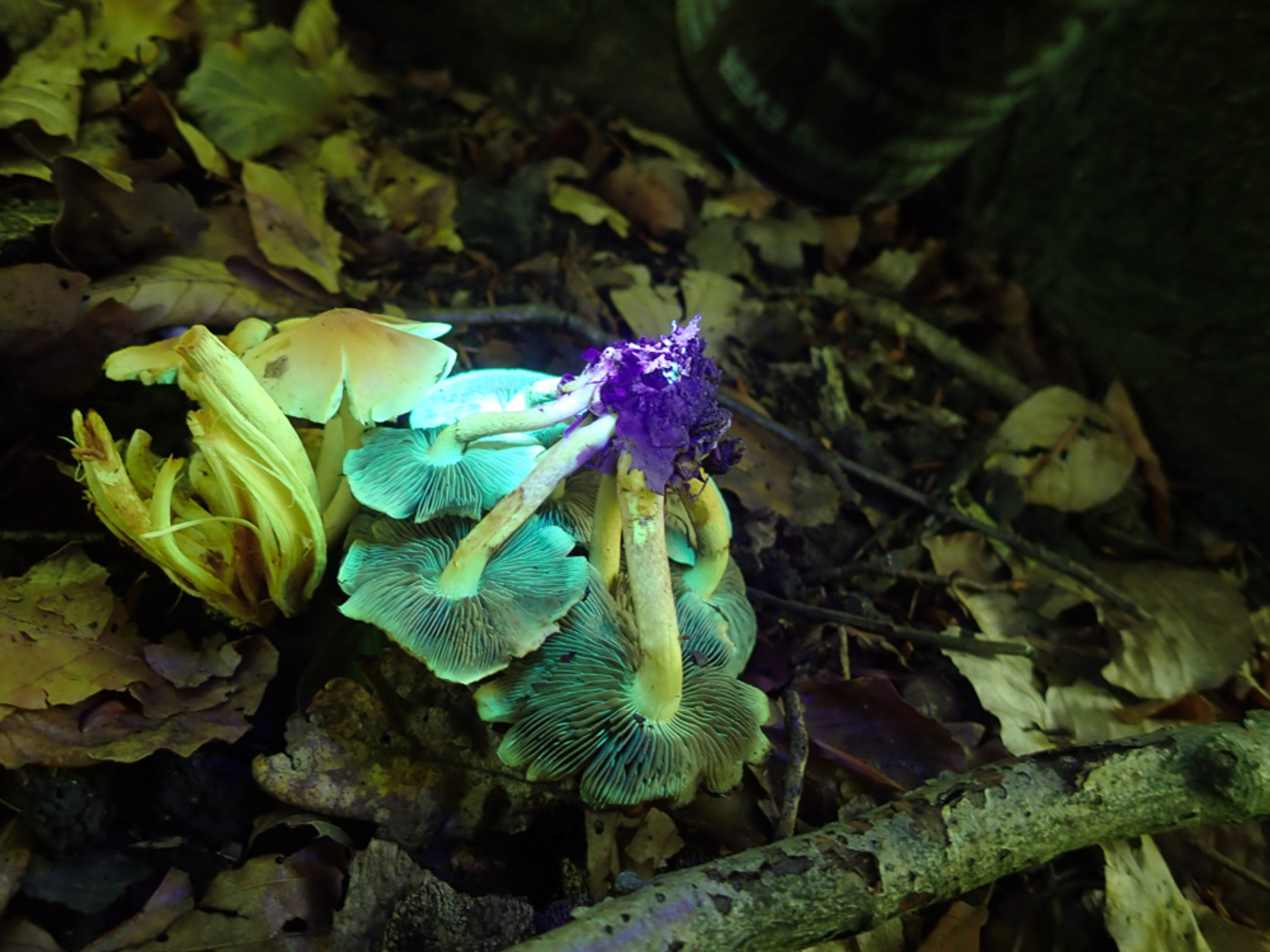
|
Sep 29, 2025. Penny went armed with her new UV torch (395) to Gussetts Wood and immediately spotted her target species! She'd recently been shown how this species glows purple at the base and also the cap centres under ultraviolet light (though it needs to be this number and not 365). The evidence is in the photo here! |
   |
Apr 23, 2024. On a fallen very rotten Lime trunk at Turville Heath Penny spotted three yellow rather nibbled caps. On closer inspection she recognised the species, then spotted more fruitbodies lurking inside a hollow in the trunk. Photo 2 shows how the sulphur yellow young gills soon darken to almost black as the spores mature and colour them accordingly. This is one of our commonest mushrooms growing on wood and is not that unusual to find at this time of year. |
  |
Aug 12, 2023. In a grassy path edge near Oak at Turville Heath Penny saw these fresh examples of one of our commonest woodland mushrooms. Note its clustered habit, the greenish tinge to the gills when young and before they've been blackened by the maturing dark spores, also the blackish veil remnants usually attached to the cap rim - useful pointers to its ID. |
  |
Apr 18, 2023. Penny was surprised to find these young fresh specimens of a common autumn species at Burnham Beeches today, especially as they appeared to be on pony dung! Further exploration revealed woody debris of Pine beneath, however. The BFG database shows finds from every month of the year though they are few and far between for February and April. This is a species in which the young and mature examples are remarkably different. |
  |
Sep 29, 2022. At Stoke Common on a Pine stump Penny was pleased to find a decent sized fresh clump of this very common species which has been conspicuous by its absence recently. In photo 2 note the grey-black remnants on the cap margin, also how the pale sulphur gills are already darkening as the black spores mature and colour them. |
  |
Jun 13, 2022. On an old deciduous stump at Turville Heath Penny caught her eye in these tiny buttons just emerging, thought they were likely to be this species though with the largest caps well under 1cm across she could not be certain. However, all the microscopic features confirmed it. It's not that unusual to find clusters of this common species popping up at any time of year when conditions are suitable. |
 |
Oct 27, 2021. At Stoke Common Penny found this very common species coming up in droves wherever trees had been cleared with roots still remaining. The caps when young are bright orange becoming sulphur yellow around the edges then gradually elsewhere, and the gills also start out yellow but soon turn darker to grey black as the very dark spores mature and colour them. It will grow in tight clusters on dying or dead wood of both deciduous and coniferous trees everywhere. |
 |
Jan 29, 2022. At Stampwell Farm Jackie Ewan noticed this nice fresh clump today. It may be a very common species but it's nice to see any freshly fruiting mushrooms at this time, especially after the spell of frosts which have rather curtailed entries for Finds in recently. For further images see Finds 2021 October 27th, together with others on earlier pages. |
 |
Jun 21, 2021. In Tinkers Wood, Downley John and Leslie Catterson noticed this early fruiting clump of a very common summer to autumn woodland species. It is always associated with wood of one kind or another and here was on a fallen Larch log. Often much more obviously yellow than shown here, the caps have clearly been rather washed out by the recent rain. Note also how the gills (which start pale yellowish) are just beginning to darken as the purple-brown spores mature, also leaving a faint dark ring zone on the stem where some of them get trapped and here just visible on the upturned specimen. This species is dangerously toxic. |
  |
Sep 16, 2020. This very common species seems to have only just started fruiting around here this season - both collections here were found on and around fallen wood by Penny Cullington in Penn Wood. Usually growing clustered and never far from some sort of wood, this is a species which will fruit at any time of year on many different types of wood. These two collections look superficially like two different species. Like many dark-spored mushrooms, when young the gills can be pale (sulphur yellow in this case) and only darken as the mature spores develop and then start falling. Note also in the mature specimens the cap edge which typically develops black patches.
THIS SPECIES IS VERY POISONOUS!
|
| Hypholoma laeticolor (Bright Brownie) |
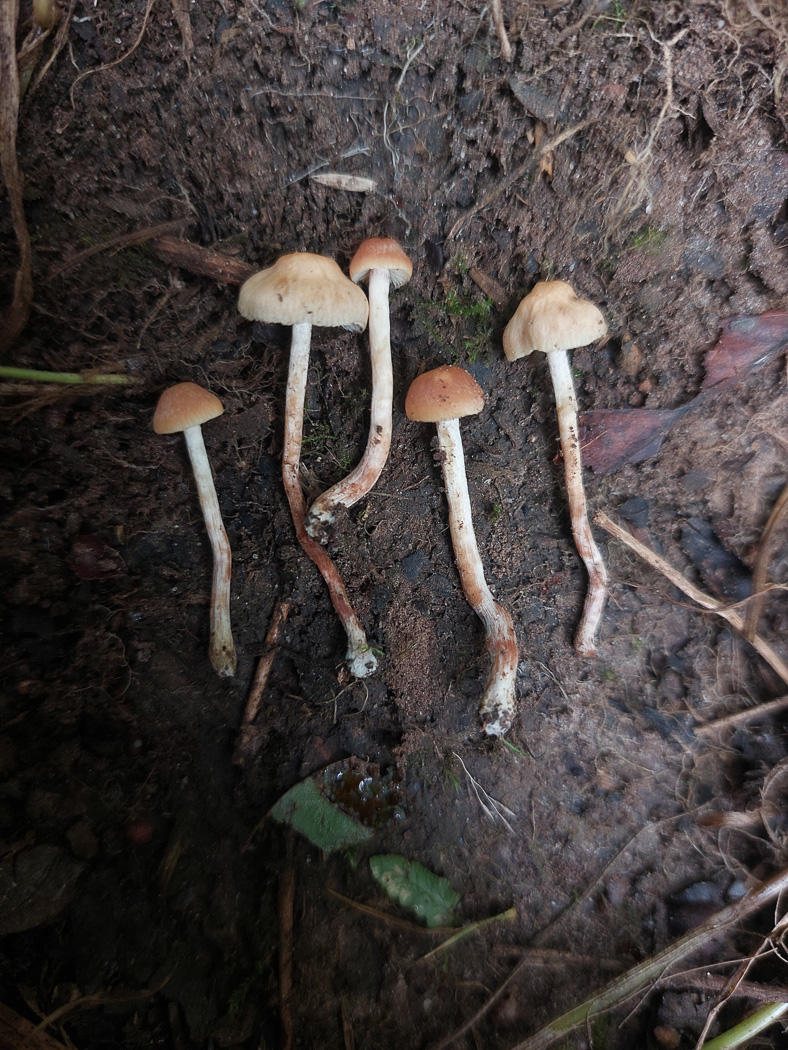
|
Oct 11, 2025.  On our group walk at Naphill Common Jesper Launder collected these from soil around the edge of a pond. The genus Hypholoma was quickly recognised though a key was needed to work out the species name. Not often recorded, it favours mossy vegetation in damp sites and is quite similar to H. elongatum but differs in spore size. Jesper's photo didn't make the cut for the report but is clearly worthy of inclusion here as we have only one previous county record. On our group walk at Naphill Common Jesper Launder collected these from soil around the edge of a pond. The genus Hypholoma was quickly recognised though a key was needed to work out the species name. Not often recorded, it favours mossy vegetation in damp sites and is quite similar to H. elongatum but differs in spore size. Jesper's photo didn't make the cut for the report but is clearly worthy of inclusion here as we have only one previous county record. |
| Hypholoma lateritium (Brick Tuft) |
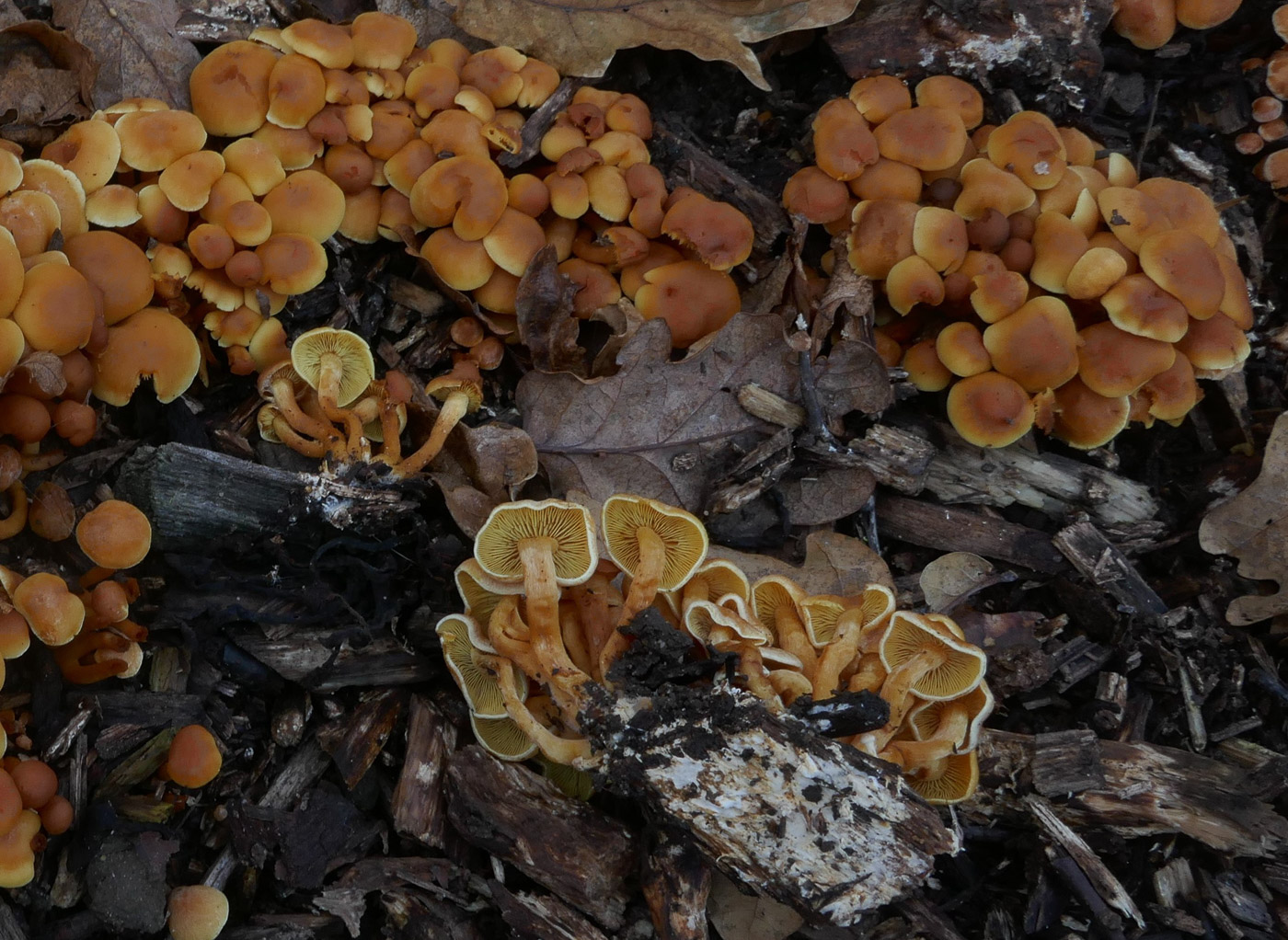 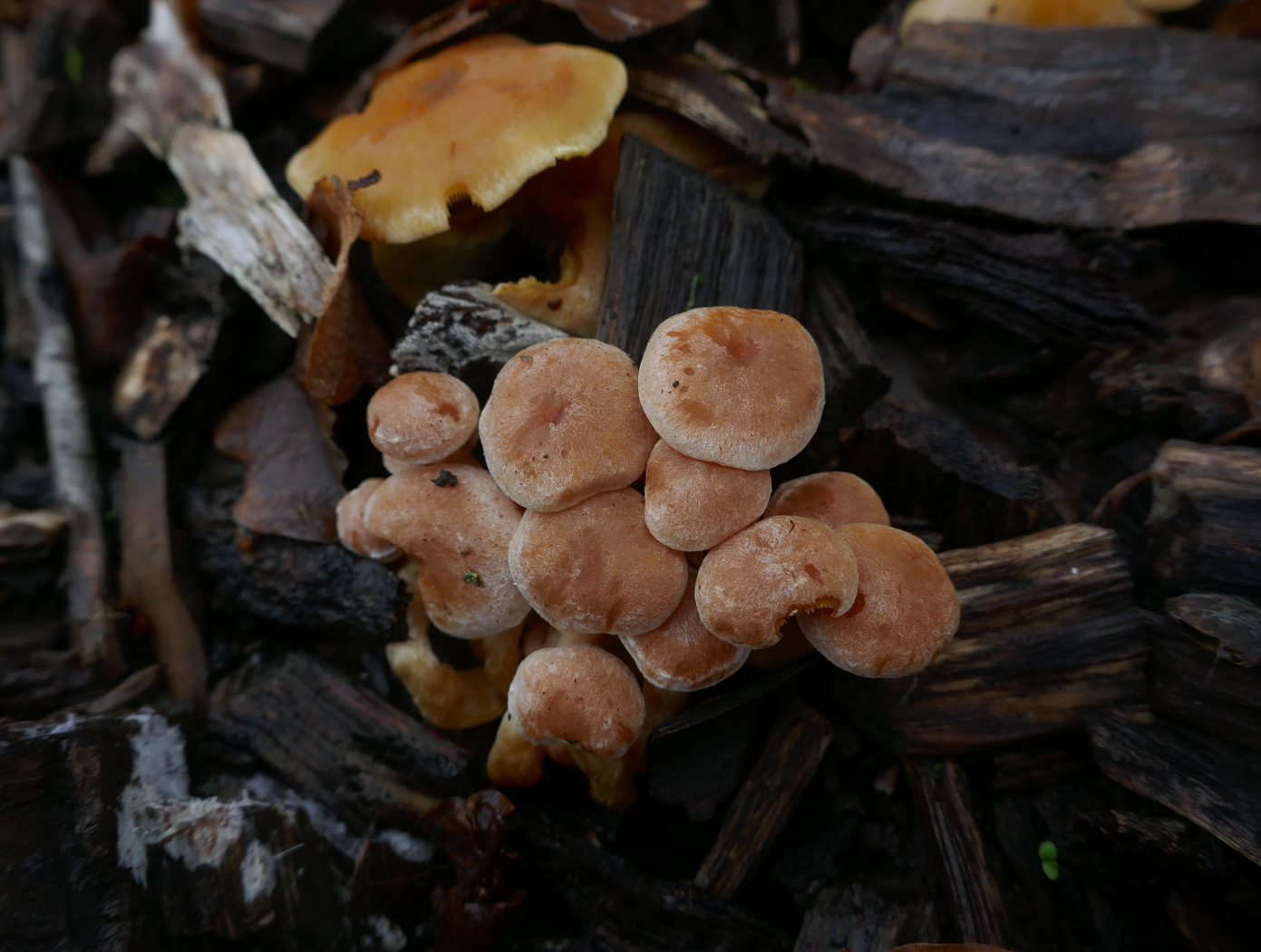 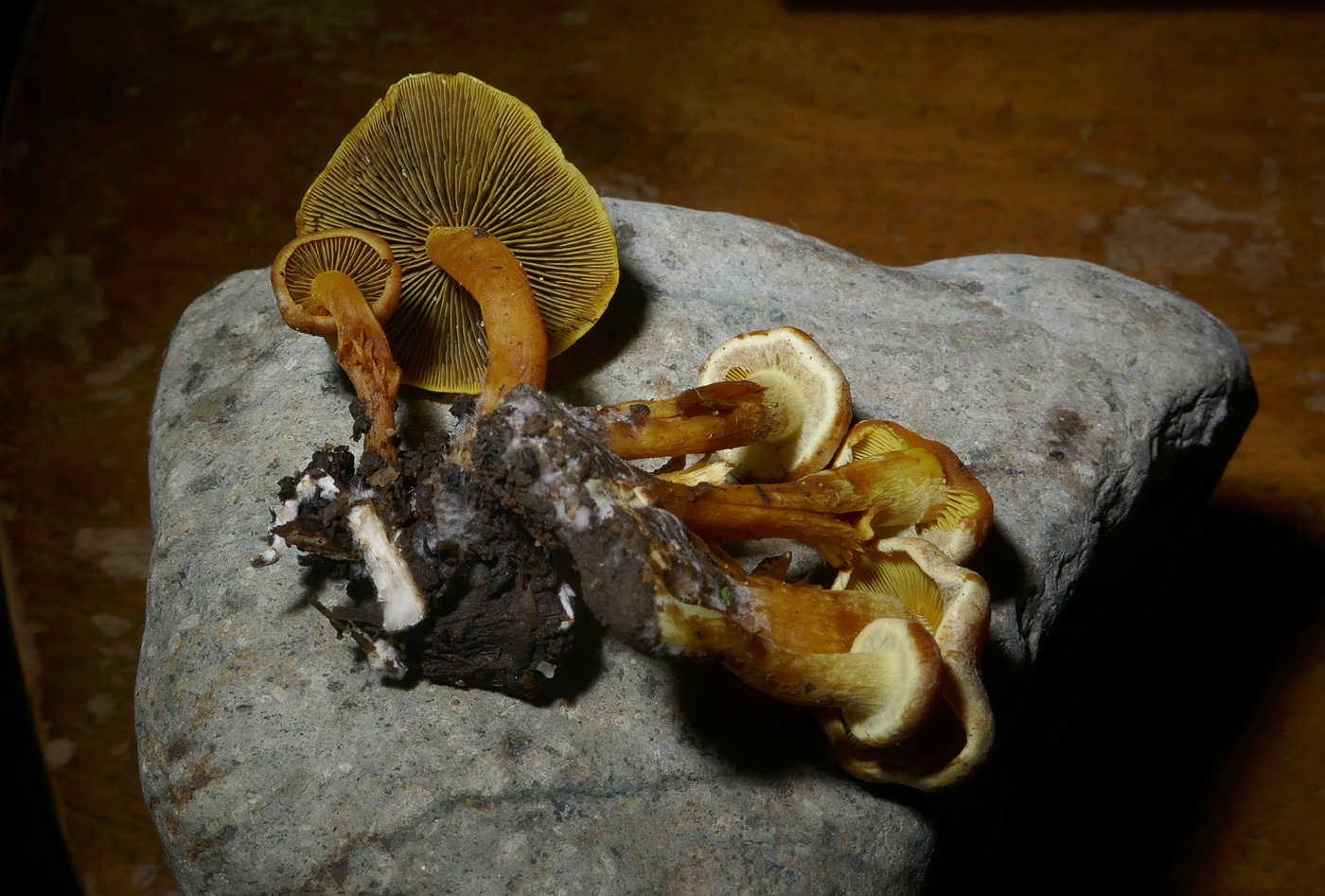 |
Dec 9, 2024. On a large woodchip pile at Stampwell Farm Jackie Ewan noticed this generous fruiting of a species somewhat similar to the common Hypholoma fasciculare (Sulphur Tuft) but with differences. The species is far less common, favours deciduous stumps and woody remains, and lacks the greenish yellow cap colours of the H. fasciculare, having much rustier red tones which are also apparent in the lower stem. |
   |
Oct 24, 2020. Paul C. found this large cluster on rotting woodchips in Gussetts Wood (photo Penny C.). Belonging to the same genus as the common and familiar Sulphur Tuft, this species is far less frequent and generally occurs on deciduous stumps. Features to note beside the bright rusty brick cap colour are the pale margin where flecks of veil often remain (not visible in the young collection but clear on photos 1 and 2,) the pale crowded but slightly concave gills which lack the sulphur tints found in Sulphur Tuft and which become much darker once the blackish spores mature, also the stem which is fluffy when young but becomes smooth though darker in the lower half with a faint ring zone remaining, visible in photo 2 where coloured by the dark spores. |
| Hypocrea gelatinosa (an Ascomycete with no English name) |
 |
Nov 27, 2020. The sharp eyes of Barry Webb noticed these tiny 'cushions' on the bark of fallen deciduous wood in Burnham Beeches. Each cushion is less that 3mm across and the tips of the cells containing the green spores are visible as tiny dark blotches just under the surface, making this rare species very distinctive and recognisable in the field. We have just two previous county records, though along with many other tiny species of fungi they are so easily missed and may well not be that rare.
|
| Hypomyces aurantius (Orange Polypore Mould) |
  |
Mar 23, 2022. Noticing a rather soggy and strangely orange coloured bracket on rotting fallen deciduous wood in Burnham Beeches, Penny took a further look underneath where the distinctly orange roughened surface of this paracitic Hypomycete was very apparent. Though named Polypore Mould, this species is common on many different fungi, particularly Trametes versicolor (Turkeytail) - today's host. (Photo 1 is Penny's photo, 2 is Claudi Soler's). This is our first image of the species on Finds.
|
| Hypomyces chrysospermus (Bolete Mould) |
 |
Aug 7, 2023. At Stampwell Farm Jackie Ewan noticed this typical example of a very common fungus though a first for Finds. Related to the Ascomycetes, the species parasitises several genera of Boletes, causing them to turn white then eventually bright chrome yellow as can be seen here and rendering them impossible to identify.
|
| Hypoxylon fragiforme (Beech Woodwart) |
   |
Nov 24, 2022. On fallen Beech in Bradenham Woods Penny found this common Pyrenomycete (hard crusty Ascomycete) which was showing both mature black fruit bodies as well as the paler cocoa brown younger ones, seen in photo 3. Photo 2 elucidates the reference to strawberries in the Latin species name, ie the bumpy surface with tiny 'ostioles' (holes) from which the spores are shot out when mature. |
 |
Aug 19, 2021. In Kings Wood Tylers Green Penny saw plenty of fresh swarms of this very common Ascomycete on fallen branches of Beech. At this stage they are typically bright cocoa brown but later become much darker to almost black. They can get to about 1 cm across and the surface is roughened with punctate tiny openings (reminiscent of the surface of a strawberry, hence the common name) through which the spores are expelled. The species is confined to Beech, so if you find similar warts on different wood you have a different species. |
  |
Sep 22, 2020. This common ascomycete was found on its typical host, fallen Beech, in Naphill Common by Peter Davis and Paul Goby independently. There are several different species of Woodwart, all pretty similar, and the easiest way to identify them is by knowing which species fruits on which type of wood. This particular species only grows on Beech and the name 'fragiforme' refers to its bumpy surface which is not unlike that of a strawberry (Latin fragaria). It's always found in swarms, sometimes in large quantities and fruitbodies get no bigger than 1cm across. They start out reddish to cocoa brown (see photo 1) and end up almost black when older (see photo 2). |
| Hypoxylon fuscum (Hazel Woodwart) |
  |
Jan 26, 2024. In Chalfont St. Peter Jim Wills found this stick under Hazel with a good display of this very common fungus. A typical species of Hypoxylon, it is smaller than H. fragiforme (Beech Woodwart) and only occurs on Hazel, often in large colonies on dead but still attached branches. |
 |
Jul 21, 2021. On the same stack of dead branches in Turville Heath Penny noticed a colony of brown to blackish crusty lumps on Hazel. This is as common as - and also very similar to - H. fragiforme (Beech Woodwart) though obviously both species are dependent on the presence of dead or dying branches of their host tree. |
 |
Oct 25, 2020. Penny C. found a dead Hazel branch in Ragpits Nature Reserve which was liberally dotted with this very common Ascomycete. Identifying Woodwarts to species largely depends upon identifying the fallen wood they are found on. Compare with H. fragiforme (Beech Woodwart) dated Sept 22. |
| Hypoxylon subticinense (a rare Woodwart with no English name) |
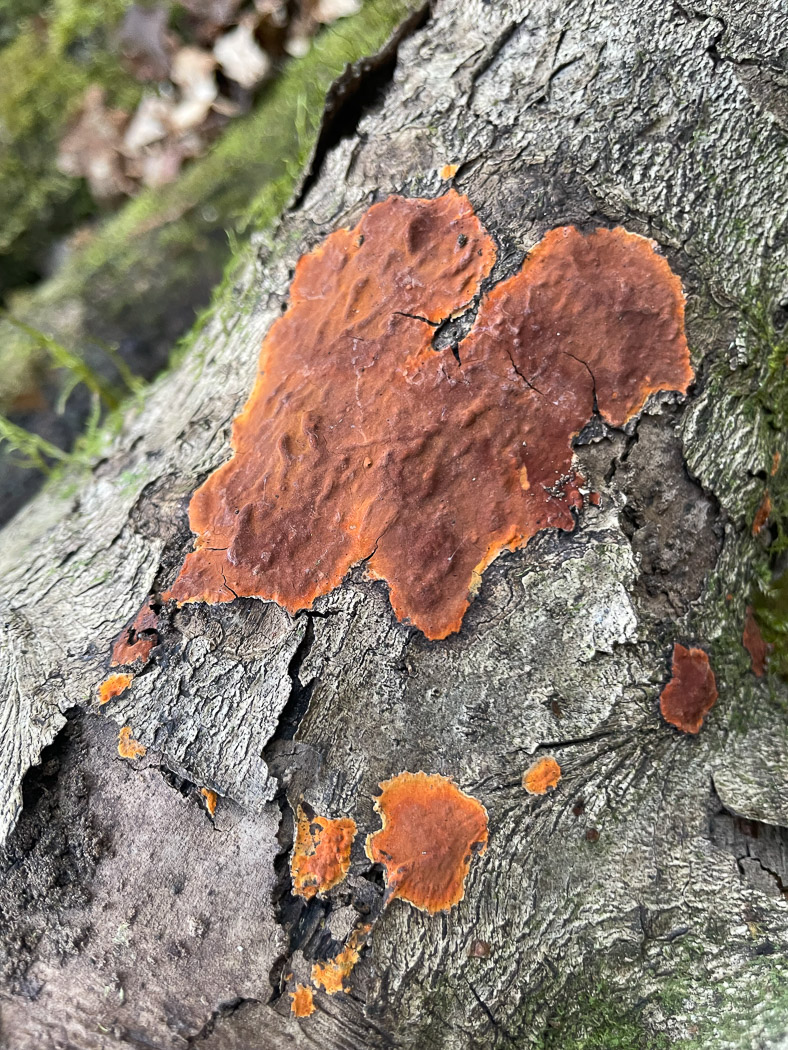
|
Apr 9th, 2025.  Burnham Beeches Sarah Ebdon and Jesper Launder made a B-line for a particular log pile, mainly Beech, where we'd found several interesting species on our Walk here last April including this unusual Hypoxylon which was then new to the county (see my report for April 17th, 2024) .Sure enough, after turning various logs they found it fruiting in abundance on the fallen Beech branches. Sarah says that her photo shown here really doesn't do justice to its brilliant ochre-orange colour which singles out this species from others, nor does it form the typical round 'warts' with which we are familiar in the much more common species of Hypoxylon. So this is our second county record but the first entry for Finds, last year's collection was not included here as Finds is reserved for those collections made in the county apart from on our Walks. Burnham Beeches Sarah Ebdon and Jesper Launder made a B-line for a particular log pile, mainly Beech, where we'd found several interesting species on our Walk here last April including this unusual Hypoxylon which was then new to the county (see my report for April 17th, 2024) .Sure enough, after turning various logs they found it fruiting in abundance on the fallen Beech branches. Sarah says that her photo shown here really doesn't do justice to its brilliant ochre-orange colour which singles out this species from others, nor does it form the typical round 'warts' with which we are familiar in the much more common species of Hypoxylon. So this is our second county record but the first entry for Finds, last year's collection was not included here as Finds is reserved for those collections made in the county apart from on our Walks.
|

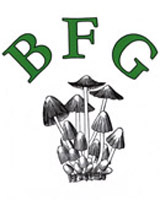
















































































.jpg)













.jpg)


































































































.jpg)






































































































































































































































































